common diseases in human
- Books Name
- A TEXT OF BIOLOGY - CLASS XII
- Publication
- ACME SMART PUBLICATION
- Course
- CBSE Class 12
- Subject
- Biology
HEALTH
The term health is very frequently used by everybody. How do we define if?
Health does not simply mean 'absence of disease' or 'physical fitness'.
It could be defined as a state of complete physical, mental and social well-being.
When people are healthy, they are more efficient at work.
This increases productivity and brings economic prosperity.
Health also increases longevity of people and reduces infant and maternal mortality.
Balanced diet, personal hygiene and regular exercise are very important to maintain good health.
Yoga has been practised since time immemorial to achieve physical and mental health.
Awareness about diseases and their effect on different bodily functions, vaccination (immunisation) against infectious diseases, proper disposal of wastes, control of vectors and maintenance of hygienic food and water resources are necessary for achieving good health.
DISEASE
When the functioning of one or more organs or systems of the body is adversely affected, characterised by various signs and symptoms, we say that we are not healthy, i.e., we have a disease.
Diseases can be broadly grouped into infectious and non-infectious.
Diseases which are easily transmitted from one person to another, are called infectious diseases.
Infectious diseases are very common and every one of us suffers from these at sometime or other.
Some of the infectious diseases like AIDS are fatal.
Among non-infectious diseases, cancer is the major cause of death.
Drug and alcohol abuse also affect our health adversely.
The disease can be defined as a disorder of the mind or body.
This term covers varied conditions leading to deviation of the human body from the normal course or deviation from the normal health.
Thus disease is opposed to health.
From time immemorial diseases have been a prime concern of man.
Early man thought that diseases were caused by evil spirits, hence cure consisted of pacifying the evil spirits with the help of charms and magic.
Hippocrates (B.C. 460-359), the great Greek physician was the first to separate medicine from religion and superstition.
He gave description of disease symptoms and emphasized the need for good diet, fresh air and rest.
He also described that human body has natural tendency to defend itself against diseases.
Pathogen. It is an organism which is capable of producing a disease.
The ability of the pathogen to gain entrance and produce symptoms of disease is called pathogenicity.
Virulence is the degree of pathogenicity of a pathogen in the host body.
Pathogens are biological agents including bacteria, fungi, viruses, mycoplasma, protozoans, helminths, etc.
Parasite is the organism which lives at the expense of the other organism called host for obtaining food and shelter.
A parasite may cause disease in the host.
Infection is the interaction between the host and the parasite having a competition for superiority.
The disease occurs when the parasitic organism is able to win.
The infection or transmission may occur by contact, through air, through food and water, insect bite or by contaminated materials.
The researches in parasitology described causative organisms (parasites) of diseases.
Our knowledge of human parasities developed after the invention of microscope in 1835.
Categories of Diseases
The diseases can be broadly divided into two groups congenital and acquired diseases.
(i) Congenital Diseases : They occur since birth and may result from metabolic disorder or defect in development.
(ii) Acquired Diseases : They develop after birth and can be further divided into two main categories
(i) Communicable diseases which rapidly spread from one person to another, they include infectious diseases, and
(ii) Non-communicable diseases which do not spread from person to person, they include all other acquired diseases.
COMMUNICABLE DISEASES
The infectious diseases rapidly spreading from person to person are called communicable diseases.
The communicable diseases can be categorised on the basis of different aspects.
On the basis of transmission they may be divided into (i) transmitted through air, (ii) through food and water, (iii) through insect bite, and (iv) transmitted by contact.
On the basis of causative organism or pathogen these diseases may be categorised into bacterial, viral, protozoic, helminthic and fungal diseases.
DISEASES CAUSED BY VIRUSES
1. Common cold:
One of the most infectious human ailment.
It is caused by Rhino viruses.
They infect the nose and respiratory passage but not the lungs.
The common cold is characterised by nasal congestion and discharge, sore throat, cough, headache, tiredness, hoarseness etc. for 3 to 7 days.
2. Influenza:
It is commonly known as "Flu" and is highly infectious.
It causes fever and pain all over the body and affects the nose, throat and air passages as in common cold.
The disease is caused by various types of influenza viruses (e.g., Myxovirus influenzae).
It starts with fever, headache, sore throat, cold with sneezing and pain all over the body with restlessness.
In neglected cases, complications like pneumonia, bronchitis and ear infections may develop.
There is no vaccine at present which can give protection against all types of influenza viruses as each epidemic is of a different type.
3. Small Pox (Variola) :
It is highly infectious disease starting with high fever, chill, backache and headache, followed by appearance of rash on the third day of illness.
The rash appears first on the face, then on the rest of the body.
It is more on the face and limbs and less on the trunk.
The rash starts as small reddish spots which change into papules.
These in turn change into small vesicles containing clear fluid.
Vesicles change into pustules.
Finally, a scab is formed and it falls off by the third week.
These scabs leave deep pits or scars known as pock marks.
Many children become blind and develop discharge from the ear.
This disease is caused by a small pox virus named Variola virus (ds DNA virus).
The virus is present in the oral and nasal discharges of the patients and is ejected during the acts of coughing, sneezing, fomites etc., and infects the healthy people.
Vaccination against small pox is one of the best preventive remedies available today.
This was discovered by Edward Jenner in 1798.
Small-pox has been eradicated from India.
4. Chicken Pox (Varicella) :

It is a mild but highly infectious disease causing slight slight fever and a rash which undergoes changes into vesicles, pustules and finally a dark brown scab which falls off leaving no scar unlike smallpox.
The rash comes out in crops and with each fresh crop, there may be slight fever again.
The rash first appears on the trunk and there are more lesions on the trunk than on the face and limbs.
The disease is caused by a virus of chicken-pox named Varicella zoster which is passed out in the discharges of the respiratory tract of an infected person directly as droplets or through contaminated articles used by the patient.
Vaccination against chicken-pox is now available.
The most common late complication of chicken-pox is shingles caused by reactivation of varicella zoster.
5. Measles (Rubeola Disease) :
Measles is a highly infectious disease causing fever, inflammation of the air passages and a rash all over the body.
It attacks especially the children below the age of 5 years and those who have escaped may be attacked even in the later life.
It is caused by Rubeola virus (RNA virus) which is passed out in the secretions of nose and throat of the infected persons as droplets or in articles soiled by these secretions.
The disease starts with catarrh' of the nose and throat, and fever.
The eyes are red and watery, and the face is flushed.
The rash which is slightly pinkish in colour appears first on the back of the ear and face, and spreads downwards on the body.

6. Mumps (Infectious Parotitis):
It is infectious disease causing fever, difficulty in opening the mouth and painful swelling of the parotid glands which lie just below the lobe of the ears.
It is caused by Paramyxovirus (RNA virus), which comes out in the saliva of the infected person.
The patient should take complete bed rest till the swelling subsides in order to avoid complications.
Usually, there are no complications, but in some cases there may be pain and swelling of the testes (orchitis) or pain in the abdomen.
7. Poliomyelitis:
This disease was called infantile paralysis.
But it is now known that the disease may occur at any age.
This disease spreads mainly through intestinal discharges.
It may also spread through contaminated food or drink and by flies or other insects that may contaminate food or drink.
Polio virus (ss RNA) usually enters the body via alimentary canal where it multiplies and reaches the nervous system (spinal cord) through the blood stream.
Its incubation period is 7-14 days.
It produces inflammation of the nervous system.
The earliest sign of this disease is involvement of the central nervous system causing inability to bend the head forward.
Stiffness of the neck is an important sign. Paralysis starts following the weakness of particular skeletal muscles.
The attack of paralysis begins with high fever, headache, chills, pain all over the body.
If muscles of larynx and pharynx are involved it proves fatal.
Within two to three days the paralysis reaches its maximum.
There is no sure cure for polio.
The patient should be kept isolated.
He should be given complete rest.
An adequate arrangement for proper disposal of urine and faeces of the patient must be provided because they contain polio virus.
Overcrowding of children in schools, playgrounds and cinema should be avoided.
Polio is preventable. Polio vaccine is safe and effective.
Now-a-days multiple vaccines are used against polio, diphtheria, whooping cough and tetanus simultaneously.
Concept Builder
Pulse Polio is an Immunization campaign established by the Government of India in 1994 to eradicate poliomyelitis (Polio) in India by vaccinating annually all children under age five against poliovirus.
Every child (0-5 years of age) receives a dose of Oral Polio Vaccine (OPV), a live, attenuated virus which colonises the gastrointestinal tract.
This virus competitively inhibits the wild, disease-causing poliovirus.
Not only does this prevent pernicious infection in the host, it precludes transmission of the wild poliovirus to other hosts.
Since poliovirus cannot survive outside a host for more than two weeks, theoretically it would be eradicated, resulting in the eradication of poliomyelitis.
The campaign proved to be successful and the incidence of poliomyelitis in India has decreased dramatically.
Nevertheless, critics charge that the campaign has seriously encroached on other essential public health services at times when health care resources were minimal.
8. Trachoma:
It is caused by Chlamydia trachomatis.
Trachoma is a chronic inflammatory disease of the eye affecting the conjunctiva and cornea.
It is characterised by development of granules.
Its common symptoms are inflammation, pain and watering of the eye.
It can lead to blindness.
Infection spreads by direct contact, by use of handkerchiefs, towels, pillows of the patient.
9. Rabies (Hydrophobia) :
It is caused by a virus named as Rhabdo virus.
It is introduced in the body by the bite of rabid (mad) dogs usually.
It can be injected by the bite of jackels, wolves, cats etc., Incubation period is from 10 days to one year.
Fear of water is the most important characteristic symptom of this disease.
Other symptoms are saliva from the mouth, severe headache, high fever, alternating periods of excitement and depression, inability to swallow even fluids due to choked throat.
The virus destroys the brain and spinal cord. Rabies is 100% fatal.
There should be compulsory immunisation of dogs and cat population.
10. Dengue fever:
Dengue fever is caused by a RNA containing Arbovirus (Arthropod borne virus) of ffavivirus group which also causes yellow fever (not found in India).
Thus, the virus which causes dengue fever is a mosquito borne flavi-ribo virus.
The virus of dengue fever is transmitted by the bite of female Aedes aegypti (mosquito).
Incubation period is 3-8 days.
Two types: classical dengue fever and dengue haemorrhagic fever are known to occur.
Symptoms of Classical Dengue Fever are
(i) Abrupt onset of high fever.
(ii) Severe frontal headache.
(iii) Pain behind the eyes which worsens with eye movement.
(iv) Muscles and joint pain.
(v) Loss of sense of taste and appetite.
(vi) Measles like rash over chest and upper limbs.
(vii) Nausea and vomiting.
Symptoms of Dengue Haemorrhagic Fever are symptoms similar to classical dengue fever except the following
(i) Bleeding from the nose, mouth, gums and skin bruising.
(ii) Severe and continuous stomach pains.
(iii) Frequent vomiting with or without blood.
(iv) Pale cold or clammy skin.
(v) Excessive thirst (dry mouth).
(vi) Rapid weak pulse.
(vii) Difficulty in breathing.
(viii) Restlessness and constant crying.
If there is fever consult the doctor at once, take paracetamol tablets on the advice of doctor.
Don't take Aspirin and Dispirin.
Do cold sponging if fever is high.
Give plenty of liquids to the patient.
Rush the patient to the hospital if there is bleeding from any part of the body or if the patient becomes unconscious.
No vaccine for Dengue fever is available.
Eliminate mosquito breeding places by covering small water containers, water tanks, changing the water of cooler every week, and where Aedes mosquito breed.
Wear clothes which cover arms and legs.
Do not allow children to play in shorts and half sleeved clothes.
Use mosquito repellents, repellent cream and sleep in mosquito-net.
11. Chikungunya:
It is caused by Chikungunya virus.
This virus was first isolated from human patients and Aedes aegypti mosquitoes from Tanzania in 1952.
The name 'Chikungunya' is derived from the native word for the disease in which patient walks "doubled up" due to severe joint pain.
Its symptons include sudden onset of fever, crippling joint pain, lymphodenopathy and conjuctivitis.
Some show haemorrhagic manifestations.
No vaccine is available.
DISEASES CAUSED BY BACTERIA
1. Cholera:
This is an acute infectious disease caused by Vibrio cholerae.
These may get into a healthy person with contaminated food and water.
The patient starts passing stools frequently, which are white like rice water, and gets repeated vomiting.
Since, a large quantity of fluid and salts are rapidly lost through stools and vomit, therefore, the most important dore treatment is to replace the lost fluid and salts equally rapidly.
Rapid replacement of fluid and elecrolytes is done by oral rehydration-therapy.
2. Typhoid:
It is an infectious disease caused by Gram negative bacterium called Salmonella typhi which is a non-spore forming bacillus.
Typhoid germs are contracted from food or drink contaminated with excreta from carriers or patients.
The spread is facilitated by poor environmental hygiene. Immunity following the infection is not sufficient to prevent relapse.
A large number of organisms have to be ingested by healthy person to suffer from typhoid.
Smaller number may produce the disease if the organisms are very virulent or if the resistance of the host is poor.
The acid in stomach destroys Salmonella that is ingested. Hence, patients having achlorhydria (no acid in stomach) or who take large amounts of antacids to neutralise the acid in stomach suffer more often from typhoid.
The normal intestinal flora produces short chain fatty acids which are lethal to Salmonella.
When this is reduced by antibiotics, the patient is more prone to typhoid.
Salmonella that cause enterocolitis after ingestion, invade the mucosal cells and multiply within them.
They do not penetrate beyond lamina propria and multiply in the lymphoid tissues (Peyers patches) of the small intestine.
Inflammatory changes occur with accumulation of leucocytes.
Enterotoxin liberated by the bacteria may form abscess which may burst causing ovoid ulcers.
This may cause haemorrhage and if the ulcer reaches the serosa, perforation occurs leading peritonitis.
The infection is usually localised in the small intestine and colon.
The incubation period is usually 12-72 hours but may be up to 2 weeks.
(i) Nausea, vomiting and an early chill are common initially followed by colicky abdominal pain and diarrhoea of watery, green, offensive stools.
(ii) Blood mixed with stool and high fever may occur if there is involvement of colon.
Symptoms may subside within a week or two.
There is clinical syndrome characterised by fever, headache, cough, splenomegaly and leucopenia.
This is called enteric fever.
The fever is continuous in type which rises in a step-wise manner.
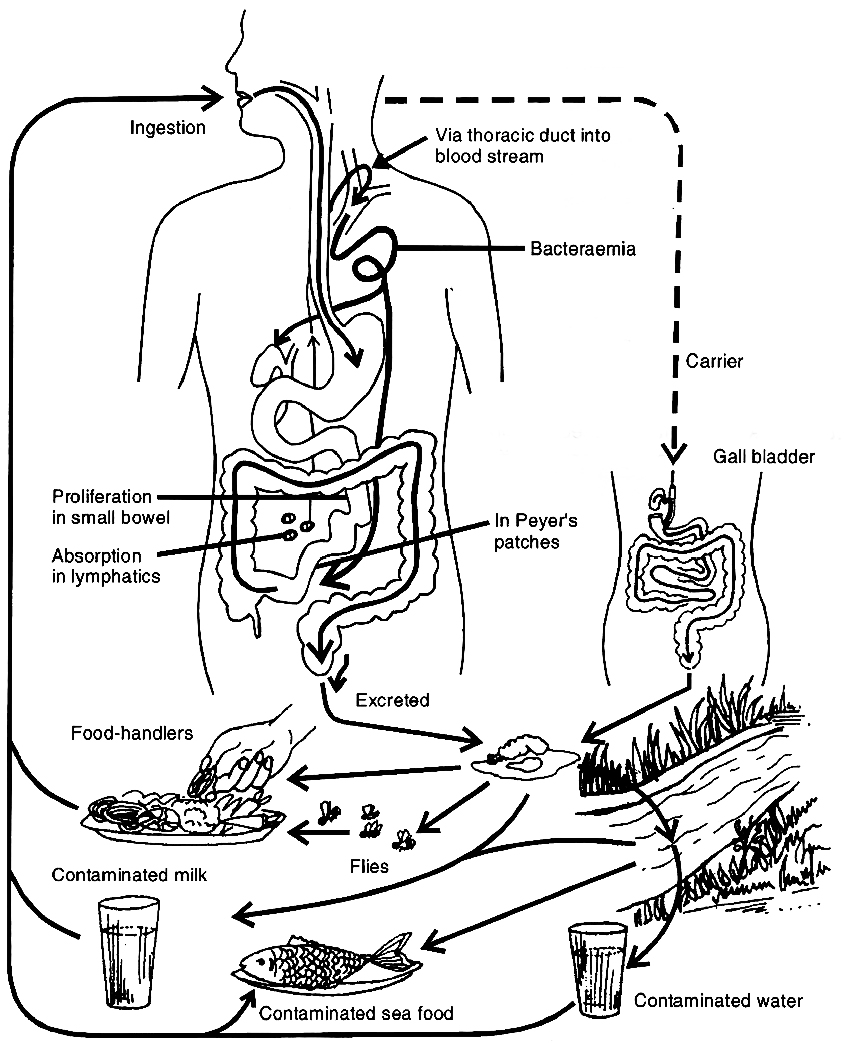
Diagnosis is done by Widal test which determines the agglutinins against the antigen.
The test is usually positive in the 2nd week of the disease.
The concentration of agglutinins must keep on rising with time to suggest the disease.
The treatment involves use of antibiotics, antipyretics and rest. TAB vaccine is useful against typhoid.
Special care must be taken to ensure that persons who are engaged as cooks or work in eating establishments are not 'carriers' of this disease who can keep spreading this disease through food .
A classical example of typhoid carrier recorded in history was Mary Mallon who was a cook.
3. Diphtheria:
This disease is caused by Corynebacterium diphtheriae usually affecting children upto five years of age.
It maystart as sore throat, chills with mild fever, sometimes vomiting and headache.
Throat and or tonsils show a grey membrane which may spread down and cause hoarseness and difficulty in breathing.
Nose may be affected giving rise to a blood-tinged nasal discharge from one nostril.
If the disease is not treated early and properly, the toxin produced by the germs affects the heart and the nervous system, and proves fatal.
The most important preventive measure-against this disease is that all babies should be, immunised within the first six weeks of birth using DPT vaccine.
4. Whooping Cough (Pertussis) :
It is a highly infectious disease of young children causing inflammation of the respiratory passages with severe attacks of cough.
It is caused by Bordetella pertussis which comes out while coughing from the discharges of the nose and throat of the patient.
It spreads by direct inhalation of droplets from the patient or the carrier, or by the articles freshly soiled by the discharges.
The cough becomes troublesome, especially at night.
Face becomes red during coughing.
These repeated bouts of violent cough end in a whoop.
Whooping sound is produced due to rushing in of air during deep inspiration at the end of a bout of cough.
The child usually vomits and there is frothy discharge from his mouth and nose.
The disease can be prevented by immunising all infants with whooping cough vaccine which is available singly or in combination as triple vaccine (i.e., DPT).
5. Pneumonia:
This disease is caused by Diplococcus pneumoniae.
Pneumonia is a serious disease of the lungs.
Lymph and mucus collect in the alveoli and bronchioles of the lungs so that the lungs do not get sufficient air.
Therefore, proper exchange of gases does not take place in the alveoli.
It usually lowers body resistance.
Infection spreads by sputum of the patient.
Breathing rate increases with high grade fever. Common in children below age of 5 years.
6. Tetanus (Lock Jaw) :
It is caused by Clostridium tetani.
The first indications of this disease are irritability and restlessness, the neck becomes stiff and there is difficulty in chewing and swallowing.
Subsequently spasms of muscles of the jaw and face take place and thus "Lock Jaw" occurs.
There is a severe pain.
It is often a fatal disease.
The toxin affects 'voluntary muscles' mainly.
Tetanus organisms live in the intestine of horses and other animals without doing any harm.
The spores, are therefore, abundant in the soil manufactured with animal dung.
Spores may survive for 60 or more years in contaminated soil.
On entering the body by way of wounds, the spores release active bacteria.
The latter multiply and secrete powerful exotoxin into the tissue and blood.
The exotoxin known as Tetanospasmin brings about tetanus.
Anti tetanus serum (ATS) injection should be administered in case of an injury.
7. Plague:
This disease is characterized by high fever and a bubo (painful swelling) in the groin or the armpit.
Plague is caused by Yersinia pestis, a deadly bacterium.
It is primarily a disease of rodents but it accidently affects man.
It goes from rat to rat through the rat fleas.
But when the rats die of plague, the fleas leave the dead rat and if any man is round about, they bite him and accidently inject into his blood some plague germs.
In its typical form the bubonic plague is not transmitted from one man to the other, but always from a rat to one or more men.
Concept Builder
When a person is bitten by an infected flea or is infected by handling an infected animal, the plague bacteria move through the bloodstream to the lymph nodes.
The lymph nodes swell, causing the painful lumps ("bubos") that are characteristic of bubonic plague.
Other symptoms are fever, headache, chills, and extreme tiredness.
Some people have gastrointestinal symptoms.
If bubonic plague goes untreated, the bacteria can multiply in the bloodstream and produce plague septicemia (septicemia plague), severe blood infection.
Signs and symptoms are fever, chills, tiredness, abdominal pain, shock, and bleeding into the skin another organs.
Untreated septicemia plague is usually fatal.
Pneumonic plague, or plague pneumonia, develops when the bacteria infect the lungs.
People with plague pneumonia have high fever, chills, difficulty breathing, a cough, and bloody sputum.
Plague pneumonia is considered a public health emergency because a cough can quickly spread the disease to others.
Untreated pneumonic plague is usually fatal.
8. Tuberculosis (TB) :
It is also called Koch's disease.
It a caused by Mycobacterium tuberculosis.
The bacteria damage the tissues and release a toxin named tuberculin which produces the disease.
It affects the lungs, lymph nodes, bones and joints.
Incubation period is quite variable.
Symptoms of pulmonary (lungs) tuberculosis are fever, cough, blood containing sputum, pain in the chest and loss of weight, excessive fatigue, failure of appetite, rise of temperature in the evening, hoarseness of throat, night sweating and rapid pulse.
BCG vaccine gives considerable protection against tuberculosis.
Concept Builder
DOTS (Directly Observed Treatment, Short course chemotherapy) is a strategy to ensure cure by providing the most effective medicine and confirming that it is taken.
It is the only strategy which has been documented to be effective Worldwide on a program basis.
DOTS ensures that patients take medicines regularly until they are cured.
During the intensive phase of treatment, a health worker or other trained person watches as the patient swallows the drug in his presence.
During the continuation phase, the patient is issued medicines for one week of which the first dose is taken in presence of health worker or other trained person issuing the drugs.
The consumption of medicine in the continuation phase is also checked by return of the empty multibilister combipack when the patientcomes to collect medicine for the next week.
Sputum microscopy is done at defined intervals during treatment to monitor the patients progress toward cure.
9. Leprosy (Hansen's Disease) :
This disease is caused by Mycobacterium leprae, which was discovered by Hansen.
Symptoms of leprosy include appearance of light coloured patches on the skin, thickening of the nerves, partial or total loss of sensation in the affected parts of the body.
These are accompanied by fever, pain, ulcers and skin eruptions.
Deformities of toes and fingers may also develop.
The bacilli leave the body in nasal discharge, from the throat during coughing, sneezing and even speaking and through broken skin lesions.
The patient is treated with DDS (diamino diphenyl sulphone).
DISEASE SPREAD BY PROTOZOA
1. Malaria
Of all the communicable diseases caused by protozoa, malaria is the most destructive for man. Malaria is widespread in the tropics and subtropics and also in certain areas of the temperate zones.
Malaria was earlier thought to be caused by foul gases emanating from marshes, hence the disease was named malaria (Italian, mala = bad, aria = air).
The term malaria was given by Maculoch (1837).
A French army doctor Charles Laveran (1880) discovered malaria parasite (Plasmodium vivax and P. malariae) in the RBC of malaria patient.
Stephens discovered P. ovale and Welch discovered P. falciparum. Lancisi suspected that malaria occurs where mosquito are found.
Richard Pfeiffer (1892) explained that some blood sucking insects are involved in transmission of malaria.
Scottish doctor Patrick Manson (1894) suggested that mosquito has some role in transmission of malaria.
A doctor in Indian Army Sir Ronald Ross (1897) established relationship between mosquito and malaria.
On 29th August, 1897 Ronald Ross discovered the oocysts of Plasmodium on the stomach of female Anopheles mosquito.
Hence 29th August is observed as the Mosquito day.
For his valuable discovery Ronald Ross was awarded the Noble Prize of medicine in 1902.
The life history of malaria parasite in female Anopheles mosquito was studied by B. Grassi (1917).
A. Bignami and G. Bastianelli.
Erythrocytic schizogony in the RBC of man was studied by Golgi (1885).
E. Shortt (1948) reported development of malaria parasite in the liver of man.
The detailed monograph of malarial parasites was written in 1996 by P.C.C. Garnham and their fine structure has been reviewed by M. Rudzinska (1969).
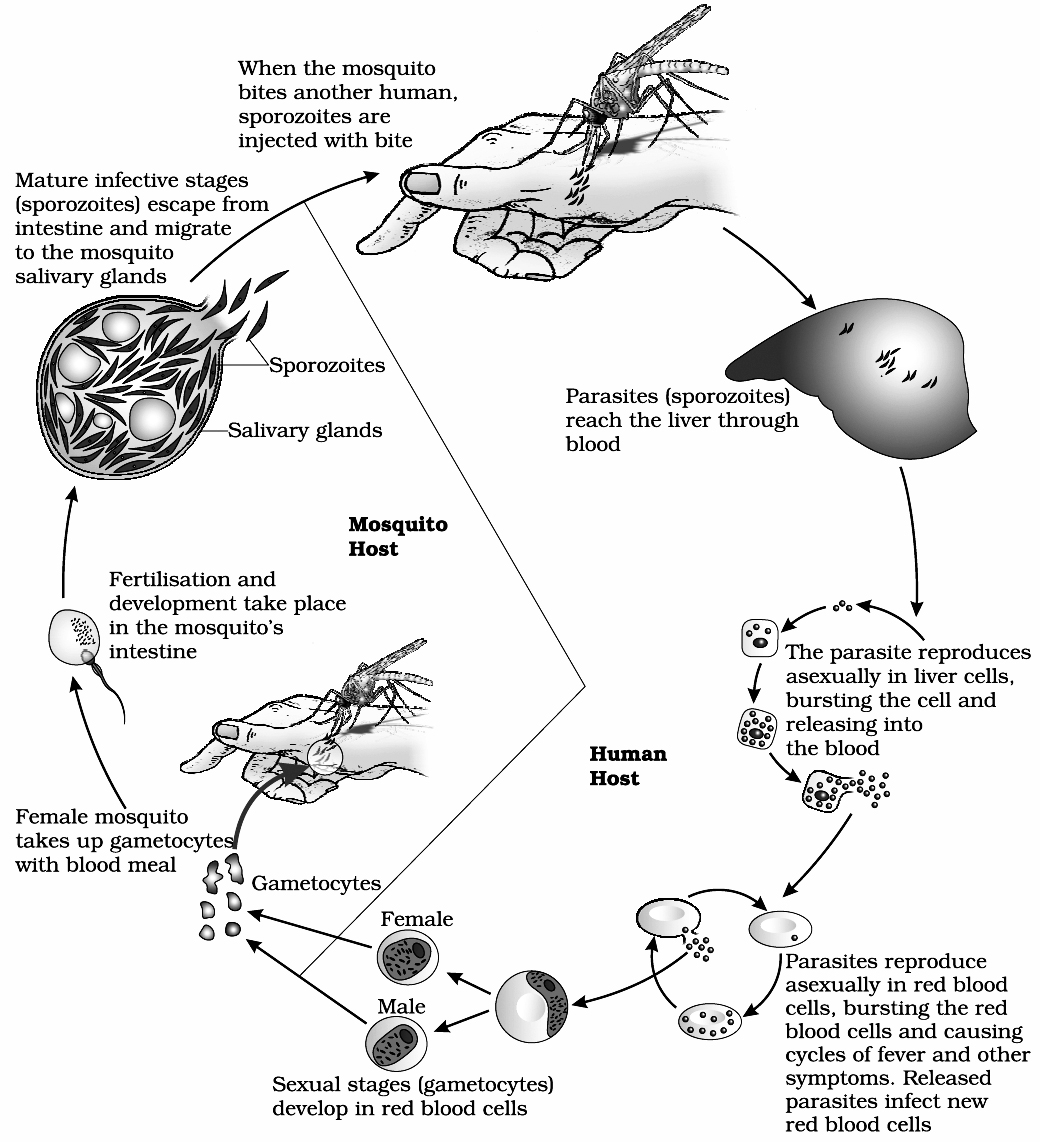
Malaria is a common tropical disease caused by a protozoa Plasmodium through the bite of female Anopheles mosquito.
There are mainly four types of Plasmodium infection causing malaria as follows:
1. Plasmodium falciparum (Malignant tertian malaria)
2. Plasmodium vivax (Benign tertian malaria)
3. Plasmodium malariae (Quartan malaria)
4. Plasmodium ovale (Mild tertian malaria)
When an infected mosquito bites an individual, its saliva, rich in parasites (sporozoites) is injected.
The sporozoites enter the circulation and then the liver (pre-erythrocytic phase).
It multiplies in the liver cells forming merozoites.
After 5-9 days, the merozoites enter the red blood cells (erythrocytic phase) forming trophozoites which subsequently mature to become schizonts.
The erythrocytic merozoites are discharged into the blood stream when the red cells degenerate.
This results in an attack of malarial fever.
The red cells are destroyed by the spleen which enlarges and some of the merozoites continue to develop in the liver (exo-erythrocytic phase) causing a relapse.
This phase is absent in life cycle of P. falciparum.
Some of the merozoites for unknown reasons do not form schizonts but develop into male and female gametocytes.
During the mosquito bite, these gametocytes are ingested.
They fertilise in mosquito's stomach and develop into sporozoites which localise in the salivary glands of the mosquito.
These sporozoites enter the human blood stream on a subsequent mosquito bite and thus complete the cycle.
The onset may be insidious with abdominal pain, nausea, dry cough and malaise. Rarely it may be acute and with fever and chills.
In the early stage, fever may be persistent for several days but soon it develops into a synchronous periodicity.
A classical attack of fever has a chill, rise in temperature to 40-41QC headache and myalgia.
This is followed by several hours of profuse sweating and fall in temperature.
In vivax and ovale malaria these paroxysms occur every 48 hours (benign tertian) whereas in malariae, it occurs every 72 hours (quartan).
In falciparum malaria, the temperature is usually persistently elevated or may progress to 48 hour cycle (malignant tertian malaria).
These cycles may be repeated in case of benign tertian malaria due to exo-erythrocytic phase.
Liver is moderately enlarged and tender.
Spleen is often palpable in acute attack.
It is soft to firm and occasionally tender.
Rarely jaundice may occur.
Malarial parasites may be visible on the peripheral smear examination.
Malarial parasites can also be demonstrated on bone marrow examination and by splenic puncture.
Treatment of Malaria includes drugs like Daraprim Chloroquine & Quinine (derived from the bark of Cinchona tree).
2. Amoebiasis
Amoebiasis is caused to man by a protozoan Entamoeba histolytica.
This is also known as amoebic dysentery.
Entamoeba histolytica was first discovered by Lambl (1859).
Friedrick Losch, a Russian zoologist in 1875, rediscovered this protozoan in the faeces and intestinal ulcers of dysentery patient and succeeded in transferring it to puppies.
Entamoeba histolytica is a microscopic endoparasite of man and is commonly found harbouring the lumen of the upper part of the large intestine i.e. the colon.
It invades the mucosa and sub-mucosa of the intestinal wall and causes amoebic dysentery or amoebiasis.
The trophozoites of the parasite make their way deep by eating through mucosa of the intestinal wall.
Here they multiply by binary fission and spread rapidly outward to form flask-shaped ulcers containing cellular debris, lymphocytes, blood corpuscles and bacteria.
This causes the formation of abscesses in the intestinal wall.
The penetration into the sub-mucosa by the trophozoites is made possible by histolysis as well as cytolysis.
The mechanism involves the dissolution and necrosis of tissues and cells by a proteolytic enzyme of the nature of histolysin secreted by the trophozoites themselves.
As the sub-mucosa is eroded by the trophozoites the ulcers burst and the blood capillaries rupture.
The blood and the ulcer contents pour into the lumen of the intestine and pass to outside with stool.
This characterises the amoebic dysentery or amoebiasis.
The stool of a dysenteric person is usually acidic and consists of swarms of Entamoebae as well.
Person suffering from amoebic dysentery has repeated blood-mixed, slimy and foul-smelling motions.
Sometimes, the trophozoites make their way through the blood circulation, into the brain, liver, spleen, lungs and gonads.
Here also they destroy the tissues and cause formation of abscesses (cavities containing pus).
Within the liver, the trophozoites cause severe lesion affecting the metabolic activities.
Formation of abscesses in brain usually proves fatal.
It mainly occurs by ingestion of tetranucleated cysts in food or drinks.
Diagnosis, consists of microscopical detection of trophozoites or cysts in faecal smears.
The presence of white, stone-shaped 'Charcot-Leydon' crystals in faeces suggest the E. histolytica infection.
Treatment of amoebic dysentery is not very difficult but the permanent cure is sometimes hard to achieve as relapses do occur.
For temporary relief, an alkaloid Emetine is effective.
A synthetic derivative called Dehydroemetine, is equally effective.
The most significant advance in the treatment of amoebiasis has been the use of Metronidazole and Tinidiazole as an amoebicide.
It is very active against both intestinal and extra intestinal amoebiasis.
Prevention of infection is entirely a matter of hygiene, both personal as well as municipal.
3. Giardiasis (= Diarrhoea)
Also known as 'Backpacker disease' because travellers are some of the most vulnerable to this disease.
It is caused by a zooflagellate protozoan named Giardia intestinalis.
It is the first human parasitic protozoan known.
It lives in the upper parts (duodenum and jejunum) of human small intestine.
It is found all over the world.
The parasites perch over the living cells of intestinal wall by means of their adhesive discs.
They absorb nourishment from the food passing through intestine, grow and multiply through binary fission.
The large number of parasites interfere with digestion and absorption of food.
This causes epigastric pain, abdominal discomfort, diarrhoea, headache and sometimes fever.
The disease caused by Giardia is popularly known as giardiasis or diarrhoea (watery and frequent stools).
DISEASE CAUSED BY HELMINTHES
1. Ascariasis:
It is caused by Ascaris lumbricoides which is cosmopolitan in distribution.
It is an endoparasite of the small intestine of human beings, but also infects the pigs and cattle.
It is more common in the children, because the latter are generally in the habit of eating soil and clay, which may be infected by the eggs of Ascaris.
The food of the worm consists of semi-digested food of the host, the blood and the fluid of the alimentary canal of the host.
The worm ingests the food with the help of suctorial pharynx.
There is no secondary host in the life cycle of this parasite.
Since a large number of adult Ascaris worms normally infest a single host, they obstruct the intestinal passage and thereby cause abdominal discomforts, like colic pains.
The patient may also suffer from impaired digestion, diarrhoea and vomiting.
In children, where the ascaris infection is quite common, mental efficiency is affected and body growth is retarded.
The disease can best be treated by administering antihelminthic drugs such as oil of Chenopodium, Alcopar, Bendex, Dewormis, Zental, etc.
Since the main source of infection is the pollution of soil, water, vegetables, therefore utmost care should be taken in the dispersal of human faecal matter.
Vegetables as a rule, should be washed properly before eating.
The parents should see to it that their children do not take to the habit of eating soil.
2. Filariasis:
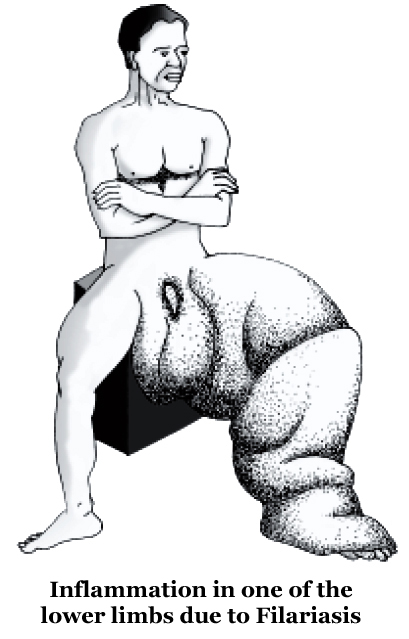
Wuchereria (W. bancrofti and W. malayi), the filarial worms cause a slowly developing chronic inflammation of the organs in which they live for many years, usually the lymphatic vessels of the lower limbs and the disease is called elephantiasis or filariasis.
The genital organs are also often affected, resulting in gross deformities.
The pathogens are transmitted to a healthy person through the bite by the female Culex mosquito vectors.
DISEASE CAUSED BY FUNGI
The dermatophytes are a group of closely related fungi.
These infect the skin hair and nails and cause a variety of clinical conditions collectively called as dermatophytoses or tinea or ringworm.
Dermatophytes include three genera:
Trichophyton. It infects skin, hair and nails.
Microsporum. It attacks the hair and skin but usually not the nails.
Epidermophyton. It infects the skin and nails but not the hair.
Thus main symptoms of the disease are appearance of dry, scaly lesions on various parts of the body such as skin, nails and scalp.
These lesions are accompanied by intense itching.
In Tinea cruis or dhobie itch, the groin and the perineum are involved.
In Tinea barbae, the bearded areas of the face and neck are involved.
Tinea pedis or athletes's foot is the ring worm of foot and Tinea capitis is the ringworm of the scalp.
Heat and moisture help these fungi to grow in the skin folds such as those in the groin or between the toes.
The infection of ringworm is usually acquired from soil or by using towels, clothes or comb of infected persons.
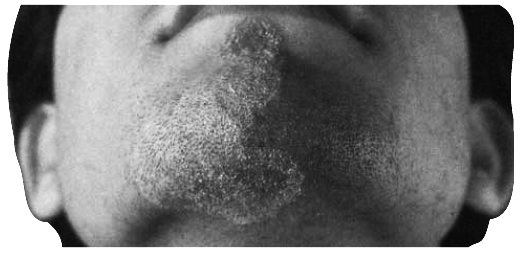
understanding the immunology
- Books Name
- A TEXT OF BIOLOGY - CLASS XII
- Publication
- ACME SMART PUBLICATION
- Course
- CBSE Class 12
- Subject
- Biology
IMMUNITY
Everyday we are exposed to large number of infectious agents.
However, only a few of these exposures result in disease. Why?
This is due to the fact that the body is able to defend itself from most of these foreign agents.
This overall ability of the host to fight the disease-causing organisms, conferred by the immune system is called immunity.
The organs of the immune system includes primary lymphoid organs like bone marrow and Thymus where immature lymphocytes differentiate into antigen sensitive lymphocytes and secondary lymphoid organs like lymph nodes, spleen which provide sites of interaction of lymphocytes and antigens.
Lymphoid Organs:
Lymphoid organs are those organs where the maturation and proliferation of lymphocytes take place.
Types of Lymphoid Organs :
There are two types
(a) Primary Lymphoid' Organs (= Central lymphoid organs)
They are those organs where T -lymphocytes and B -lymphocytes mature and acquire their antigen -specific receptors.
Thymus and Bursa of fabricius of birds are primary lymphoid organs.
The bone marrow of mammals is considered equivalent to avian Bursa of fabricius.
All the cells of the immune system are initially derived from the bone marrow.
They form through a process called hematopoiesis.
During hematopoiesis, bone marrow -derived stem cells differentiate into either mature cells of the immune system or into precursors of cells that migrate out of the bone marrow to continue their maturation elsewhere.
The bone marrow produces B-cells, NK cells, granulocytes and immature thymocytes, in addition to red blood cells and platelets.
Thymus is also called "Throne of immunity" or "Training school of T -lymphocytes".
The function of the thymus is to produce mature T cells.
Immature thymocytes / prothymocytes leave the bone marrow and migrate into the thymus.
Through a remarkable maturation process, sometimes referred to as thymic education, T -cells that are beneficial to the immune system are spread, while those T -cells that might evoke a detrimental auto-immune response are eliminated.
The mature Tcells are then released into the blood stream.
(b) Secondary Lymphoid Organs ( =Peripheral lymphoid organs)
After maturation, B -lymphocytes and T -lymphocytes migrate via blood vascular and lymphatic system to the secondary lymphoid organs where they undergo proliferation and differentiation.
The secondary lymphoid organs are lymph nodes, spleen, tonsils, peyer's patches of the small intestine, appendix and mucosal associated lymphoid tissues (MALT).
MALT is located within the lining of the major tracts (digestive, respiratory and urinogenital).
It constitutes about 50% of the lymphoid tissue in human body.
In secondary lymphoid organs like lymph nodes and spleen, there are two types of areas
(i) Thymus -dependent Area: Any part of peripheral lymphoid organs populated by T -lymphocytes. e.g. Paracortex of lymph nodes and centre of malpighian corpuscle of spleen.
(ii) Thymus -independent Area: It is rich is B -lymphocytes.
Spleen
The spleen is an immunologic filter of the blood.
It contains B cells, T cells, macrophages, natural killer cells and red blood cells.
In addition to capturing foreign materials (antigens) from the blood that passes through the spleen, migratory macrophages bring antigens to the spleen via the bloodstream.
An immune response is initiated when the macrophages present the antigen to the appropriate B or T cells.
This organ can be thought of as an immunological conference center.
In the spleen, B cells become activated and produce large amounts of antibody.
Also, old red blood cells are destroyed in the spleen.
Lymph Nodes
The lymph nodes function as an immunologic filter for the body fluid known as lymph.
Lymph nodes are found throughout the body.
Composed mostly of T cells, B cells, and macrophages, the nodes drain fluid from most of our tissues.
Antigens are filtered out of the lymph in the lymph node before returning the lymph to the circulation.
In a similar fashion as the spleen, the macrophages that capture antigens present these foreign materials to T and B cells, consequently initiating an immune response.
Lymphoid tissue located within the lining of major tracts (respiratory, digestive etc.) are called mucosal associated lymphoid tissue (MALT).
It constitutes 50% of the lymphoid tissue in the body.
Types of Immunity
There are two types of immunity against pathogens :
Non specific innate and Specific acquired immunity
A. Non-specific innate immunity:
It includes all those defense elements with which an individual is born i.e., always available to protect a living body. It can be further of four categories :
1. Anatomic barriers or Physical barriers :
(a) Skin:
The skin is physical barrier of body.
Its outer tough layer, the stratum corneum prevents the entry of bacteria and viruses.
(b) Mucous membrane:
Mucus secreted by mucous membrane traps the microorganisms and immobilises them.
Microorganisms and dust particles can enter the respiratory tract with air during breathing which are trapped in the mucus.
The cilia sweep the mucus loaded with microorganisms and dust particles into the pharynx (throat).
From the pharynx it is thrown out or swallowed for elimination with the faeces.
Mucous membrane over mucosa of stomach protects it from corrosive action of HCl.
2. Physiological barrier :
(a) Oil secreted by the oil glands and sweat secreted by sweat glands make the surface of the skin acidic (pH 3-5). This does not allow the microorganisms to establish on the skin. Some friendly bacteria also occur on the skin which releases acids and other metabolic wastes that check the growth of pathogens. The sweat also contains an enzyme named lysozyme that destroys the cell walls of many bacteria.
(b) Lysozyme is also present in tears and checks eye infections.
(c) Lysozyme is also present in the saliva which kills bacteria present in food.
(d) Highly acidic gastric juice also kills harmful bacteria in the stomach.
(e) Bile checks the growth of foreign bacteria in the intestine.
(f) The mesh of fine hair in our nostrils filters out particles which may carry pathogens. Nasal secretions also destroy the harmful foreign germs with their lysozyme.
(g) Certain bacteria normally live in vagina. These bacteria produce lactic acid. Lactic acid kills the foreign bacteria.
(h) Interferon:
These are the glycoproteins released by the cells in response to a viral infection which they help to combat.
These interferons do not kill/inactivate the virus, but they make the unattacked cells less susceptible so they are prevented from the attack of virus.
Interferons were discovered by Isaac and Lindemann.
They also prevent the viruses from taking over the cellular machinery.
Interferon proteins have proved to be effective in treating influenza and hepatitis, but their role in cancer treatment is doubtful. (Interferons are now included in cytokine barrier.)
Concept Builder
The interferon treatment known as interferon alpha is used to treat a variety of cancers, including two different types of leukemia and AIDS-related Kaposi's sarcoma.
Hairy cell leukemia is a type of cancer that affects the bone marrow as well as the blood.
Chronic myelogenous leukemia tends to only affect the bone marrow.
AIDS-related Kaposi's sarcoma is a type of cancer that attacks the soft tissue of the body.
Interferon beta is another type of interferon treatment.
This class of medication is used to treat multiple sclerosis, a degenerative disease that affects the brain as well as the spinal cord.
Still another type of treatment is interferon gamma.
This is used to treat a condition known as chronic granulomatous disease, which is marked by masses that resemble tumors that develop in various tissues of the body.
3. Phagocytic barrier :
The internal defence is carried on by white blood corpuscles, macrophages, inflammatory reaction, fever.
(a) White blood corpuscles (Leucocytes) :
The leucocytes in general and lymphocytes in particular are capable of squeezing out through the wall of the blood capillaries into the extravascular regions.
This phenomenon is called diapedesis.
The leucocytes protect in different ways.
(i) Lymphocytes: Lymphocytes can produce plasma cells which secrete antibodies to provide immunity.
(ii) Monocytes: They are phagocytic in action.
(iii) Eosinophils : Eosinophils can attach themselves to parasitic forms (mostly in case of helminths) and cause their destruction by liberating lysosomal enzymes on their surface.
(iv) Neutrophils : They eat up harmful germs and are, therefore phagocytic in nature.
(b) Macrophages:
The macrophages are formed by enlargement of monocytes. They are large cells which are phagocytic in nature.
4. Inflammatory barrier:
When the micro-organisms like bacteria, viruses, etc. enter the body tissue through some injury, these produce some toxic substances which kill more cells.
These broken cells also release some material which attract the mast cells.
The mast cells release histamine.
Histamine causes dilation of capillaries and small blood vessels surrounding the injury and increases the permeability of the capillary walls.
The more blood flows to area making it red and warm.
The fluid (plasma) leaks out into the tissue spaces, causing its swelling.
This reaction of the body is known as inflammatory response.
The plasma that accumulates at the injured site dilutes the toxins secreted by bacteria and decreases their effect.
Fever:
The inflammatory response may be in the region of the wound (localized), or it may spread all over the body (systemic).
In systemic inflammatory response, the number of WBC increases generally, the fever is caused by the toxins released by the pathogens or by compounds called pyrogens (fever producing substances).
These compounds are released by W.B.C. in order to regulate temperature of the body.
Moderate fever stimulates the phagocytes and inhibits growth of microorganism.
However, a very high fever is dangerous.
It is necessary to bring down fever by giving antipyretics (fever-reducing drug) and by applying cold packs.
Thus the interferons leucocytes, macrophages, inflammatory response and fever form second line of defence.
5. Natural Killer (NK) Cells:
NK cells are another population of large granular lymphocytes that destroys wide variety of infectious microbes and certain spontaneously arising tumor cells.
Unlike T-cell, these do not mature in the thymus and unlike both Band T-cells, they lack surface molecules/antigen receptors.
NK cells are present in the spleen, lymph nodes, red bone marrow and blood.
NK cells release g-interferon which stimulates their cytolytic activity.
NK cells may release chemical-perforins which cause cytolysis of the microbe or may bind to a target cell to inflict damage by direct contact.
NK cells probably attack cells that do not display major histocompatibility complex (MHC) antigens.
NK cells are defective or decreases in number in some cancer patients and in patients with AIDS.
6. Complement System :
The complement system is a set of 30 different protein molecules always found in the blood.
There are no cells in the system.
With an infection, this system of molecules is activated, leading to a sequence of events on the surface of the pathogen that helps destroy the pathogen and eliminate the infection.
The complement system can be activated in two main ways.
The first and most potent way known as Classical Pathway occurs when IgG (or IgM) binds to antigen at the surface of a cell.
This exposes the Fc region of the antibody such that the first complement protein (C1) binds.
The second means of activation known as Alternate Pathway is part of the natural (innate) immune response. (i.e. neither antibodies nor T cell receptors are involved.)
Here certain polysaccharides found on the surface of bacteria activate the system.
This can occur immediately and does not require prior exposure to the molecules.
But in either case, a cascade of events follows, in which each step leads to the next.
At the centre of the cascade are steps in which the proteolysis of a complement protein leads to a smaller protein and a peptide.
The smaller protein remains bound to the complex at the surface of the microorganism, while the peptide diffuses away.
As a result, the membrane loses all its regulatory properties; that is to say, the cell swells and bursts.
This final complex of molecules that causes the cell lysis is termed the membrane attack complex (MAC).
Thus the complement system triggers a constellation of effects that helps deal with an infection:
(a) Opsonization
(b) Chemotaxis (attracting macrophages and neutrophils)
(c) Inflammation
(d) Lysis (rupturing membranes of foreign cells)
The present classification of Innate Immunity is as follows:
Innate immunity is non-specific type of defence, that is present at the time of birth. This is accomplished by providing different types of barriers to the entry of the foreign agents into our body. Innate immunity consist of four types of barriers.
These are :
(i) Physical barriers: Skin on our body is the main barrier which prevents entry of the microorganisms. Mucus coating of the epithelium lining the respiratory, gastrointestinal and urogenital tracts also help in trapping microbes entering our body.
(ii) Physiological barriers: Acid in the stomach, saliva in the mouth, tears from eyes-all prevent microbial growth.
(iii) Cellular barriers: Certain types of leukocytes (WBC) of our body like polymorpho-nuclear leukocytes (PMNL-neutrophils) and monocytes and natural killer (type of lymphocytes) in the blood as well as macrophages in tissues can phagocytose and destroy microbes.
(iv) Cytokine barriers: Virus-infected cells secrete glycoproteins called interferons which protect non-infected cells from viral infection.
B. Acquired or Adaptive or Specific Immunity
Immune system forms third line of defence.
There are two components of immune system in body :
Humoral immune system and cell-mediated immune system. The important characteristics of the immune systems are
1. Specificity: Ability to differentiate between foreign molecules.
2. Diversity: To recognize enormous variety of foreign molecules.
3. Discrimination: Ability to differentiate between foreign and self i.e., will respond to foreign compound and avoid response to self molecules.
4. Memory: After encountering any foreign agent or microbe, immune response is evoked. It results in the formation of memory cells responsible for retaining memory. This is the basis of vaccination as the second response to the same microbe will evoke hightened immune response due to memory cells.
Specific Immunity Involves two types of Cells
1. Lymphocytes and
2. Antigen presenting cells
1. Lymphocytes:
Lymphocytes (a type of WBCS) are the main cells of immune system of the body.
Lymphocytes, meant for immune system, are of two types: T-cells and B-cells.
Both types of cells develop from the stem cells found in the liver of the foetus and in the bone marrow cells of the adult.
Those lymphocytes that migrate to the thymus and differentiate under its influence are called 'T-cells', while those cells that continue to be in the bone marrow for differentiation are known as 'B-cells'.
The final maturation of young lymphocytes occur in lymphoid tissues like lymph nodes, spleen and tonsils.
T-cells are responsible for cellular immunity, however, B-lymphocytes produce antibodies that take part in the humoral immunity.
Both T-cells and B-cells require antigens to trigger them into action but they respond differently.
B-lymphocytes are independent of the thymus and in man probably complete their early maturation within the bone marrow.
They are called B-cells because they mature within the Bursa of Fabricius found in the cloaca of birds.
2. Antigen presenting cells:
Antigen presenting cells (APCs) are a special class of cells which process and present exogenous antigens.
APCs include macrophages, B-cells, and dendritic cells.
APCs are strategically located in places where antigens are likely to penetrate non specific defenses and enter the body.
These are the epidermis and dermis of the skin, mucus membranes that line the respiratory, urinary, reproductive tracts.
The steps in processing and presenting an exogenous antigen by an APC include
(a) Ingestion of antigen
(b) Digestion of antigen into peptide fragments
(c) Fusion of peptide fragments to MHC and its insertion into the plasma membrane. This triggers either a cell mediated immune response (CMI) or Humoral mediated immune (HMI) response.
Antigens:
The antigens are foreign 'molecules' that invade the body of an organism.
The word 'antigen' is a shortened form of 'antibody generating' because they stimulate the production of antibodies in response to infection.
Antigens are generally large molecules.
The majority of them are made of proteins or polysaccharides found on the cell walls of bacteria and other cells or on the coats of viruses.
All antigens are not the parts of microorganism.
Other structures like pollen grains, white of an egg, shell fish, certain fruits and vegetables, chicken, feathers of birds, blood cells from other persons or animals, drugs, chemicals, etc. can also induce the immune system to produce antibodies.
Antibodies are an army of proteins produced by plasma cells.
Structure of Antibody (Ig)
Antibodies (Immunoglobulins, abbreviated Ig) are glycoproteins of molecular weight 150,000-900,000 kd.
One end of the Ig binds to antigens (the Fab portion, so called because it is the fragment of the molecule which is antigen binding), and the other end which is crystallizable, and therefore called Fc, is responsible for effector functions.
There are 5 classes ('Isotypes') of Ig; IgM, IgG, IgA, IgD and IgE.
Light chains exist in two classes, lambda and kappa.
Each antibody molecule has either lambda or kappa light chains, not both.
Immunoglobulins are found in serum and in secretions from mucosal surfaces.
They are produced and secreted by plasma cells which are found mainly within lymph nodes and connective tissues and do not circulate.
Plasma cells are derived from B lymphocytes.
These cells are responsible to secrete antibodies i.e. Immunoglobulins.
The immunoglobulin molecule consists of two light chains, each of approximate molecular weight 25,000, and two heavy chains, each of approximate molecular weight 50,000.
IgA exists in monomeric and dimeric form, IgM in pentameric form.
The links between monomers are made by a J chain.
Additionally, IgA molecules receive a secretory component from the epithelial cells into which they pass.
This is used to transport them through the cell and remains attached to the IgA molecule within secretions at the mucosal surface.
The heavy and light chains consist of amino acid sequences.
In the regions concerned with antigen binding, these regions are extremely variable, whereas in other regions of the molecule, they are relatively constant.
Thus each heavy and each light chain possesses a variable and a constant region.
The isotype of an Ig is determined by the constant region.
L-chains are linked from H-chains by disulphide (S-S) links. Intrachain S-S links divide H and L chains into domains which are separately folded.
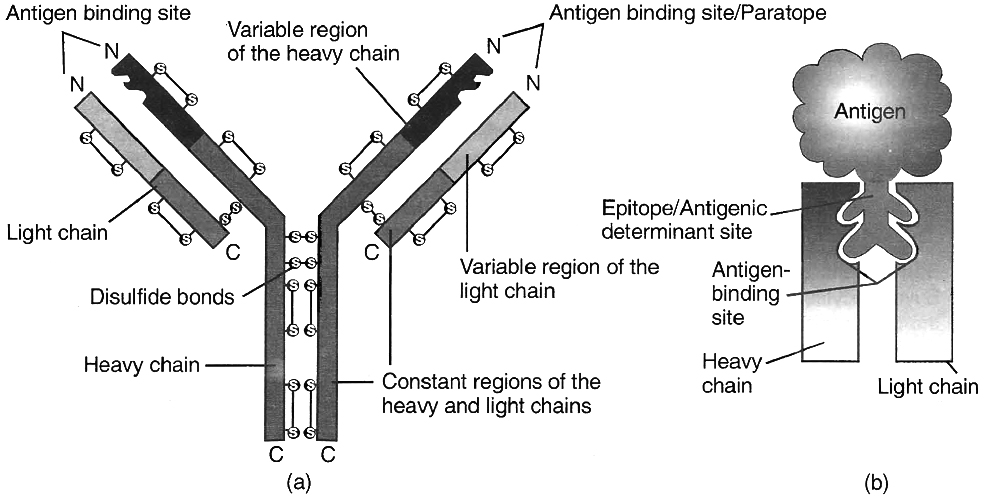
Antibodies are synthesized by B lymphocytes and exist in 2 forms -either membrane bound or secreted.
B lymphocytes use membrane bound antibody to interact with antigens.
B cells makes antibodies all of the same specificity i.e. able to react with the same antigenic determinants, and its progeny (as a consequence of mitotic division) are referred to as a clone.
The clone will continue making antibody of the same specificity.
Simultaneously, there will be lots of other clones of different specificity.
This is known as a polyclonal response.
Antigens have determinants called epitopes.
Epitopes are molecular shapes recognized by antibodies, which recognise 1 epitope rather than whole antigen.
Antigens may be proteins, lipids or carbohydrates, and an antigen may consist of many different epitopes, and/or may have many repeated epitopes.
B-Iymphocytes evolve into plasma cells under the influence of T cell released cytokines.
Plasma cells secrete antibodies in greater amounts, but do not divide.
They exist in lymphoid tissues, not blood.
Other B cells circulate as memory cells.
B cells divide, forming plasma cells and B memory cells.
Plasma cells make and release between 2000 and 20,000 antibody molecules per second into the blood for the next four or five days.
B memory cells live for months or years, and are part of the immune memory system.
B-Iymphocytes are formed within the bone marrow and undergo their development.
They have the following functions:
(i) To interact with antigenic epitopes, using their immunoglobulin receptors.
(ii) To subsequently develop into plasma cells, secreting large amounts of specific antibody
(iii) To circulate as memory cells.
(iv) To present antigenic peptides to T cells (as antigen presenting cells).
Main functions of free (Soluble) Antibodies:
Antibodies exist free in body fluids, e.g. serum, and membrane bound to B lymphocytes.
Their function, when membrane bound is to capture antigen for which they have specificity, after which the B lymphocytes will take the antigen into its cytoplasm for further processing.
Free antibodies cause agglutination of particulate matter, including bacteria and viruses.
IgM is particularly suitable for this, as it is able to change its shape.
Opsonization i.e. coating of antigen by molecules known as opsonins for which the antibody's Fab region has specificity (especially IgG).
Even complement system takes part in opsonisation specially C3B molecule.
This facilitates subsequent phagocytosis by cells possessing an Fc receptor, e.g. neutrophil (polymorphonuclear leucocytes or polymorphs).
Hence, opsonisation is the process that facilitates the phagocytosis of antigen.
Thus it can be seen that in opsonization and phagocytosis, both, the Fab and the Fc portions of the immunoglobulin molecule are involved.
Neutralization of toxins released by bacteria e.g. tetanus toxin is neutralized when specific IgG antibody binds, thus preventing the toxin binding to motor end plates and causing persistent stimulation, manifest as sustained muscular contraction which is the hallmark of tetanic spasms.
This applies particularly to IgG.
In the case of viruses, antibodies can hinder their ability to attach to receptors on host cells. Here, only Fab is involved.
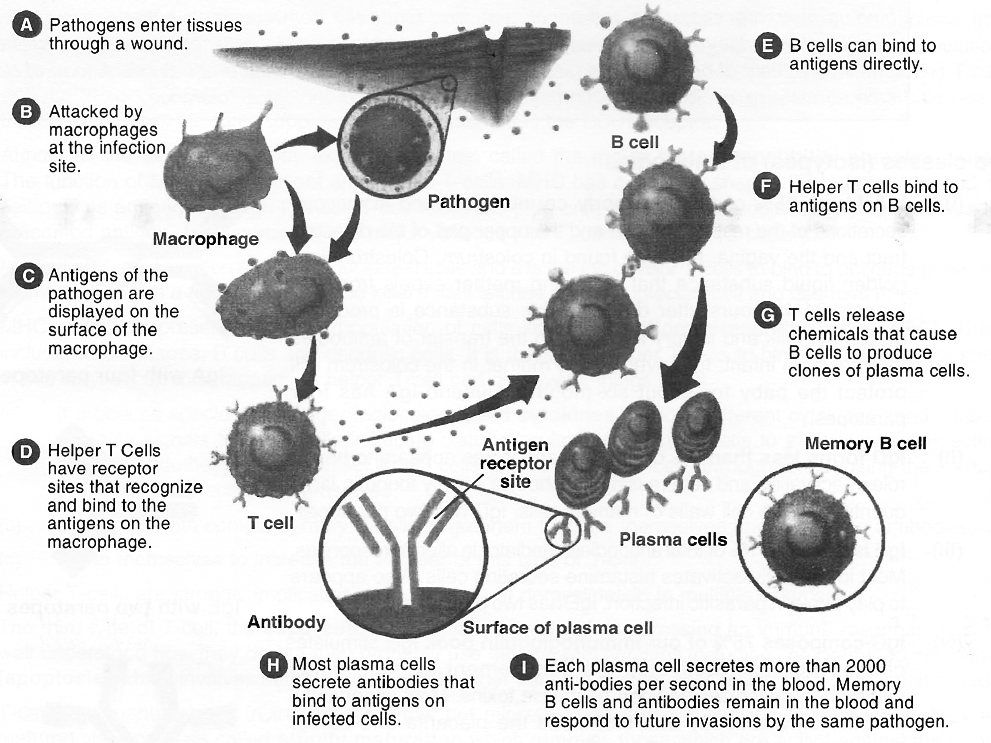
Antibodies against bacterial cilia or flagella will hinder their movement and ability to escape the attentions of phagocytic cells.
Mucosal protection is provided mainly by IgA, and to a lesser degree by IgG.
IgA acts chiefly by inhibiting pathogens from gaining attachment to mucosal surfaces.
As a consequence of antigen e.g. parasitic worms, binding to specific IgE attached to mast cells by their receptor for IgE, there is release of mediators from the mast cell.
This leads to contraction of smooth muscle, which can result in diarrhoea, and expulsion of parasites.
Precipitation of soluble antigens by immune complex formation.
Consist of antigen linked to antibody.
Depending on ratio of antigen to antibody, these can be of varying size.
When fixed at one site, they can be removed by phagocytic cells.
They may also circulate prior to localization and removal, and can fix complement.
Antibodies bind to organisms via their Fab region.
Large granular lymphocytes (Natural Killer cells -abbreviated NK cells), attach via Fc receptors, and kill these organisms not by phagocytosis but by release of toxic substances called perforins.
Concept Builder
Clonal Selection Theory : A theory explaining how the cells of the immune system produce large quantities of the right antibody at the right time, i.e., when the appropriate angtigen is encountered.
It proposes that there is a pre-existing pool of lymphocytes (B-cells) consisting of numerous small subsets.
Each subset carries a unique set of surface antibody molecules with its own particular binding characteristics.
If a cell encounters and binds the corresponding antigen it is selected stimulated to divide repeatedly and produce a large clone of identical cells, all secreting the antibody.
The involvement of helper T cells (see T-cell) is essential for activation of the B cell.
A form of clonal selection is also invoked to explain the development of immunological tolerance.
Five classes (Isotypes) of Antibodies
(i) IgA forms 15% of total antibody count. It is found in mucous secretions of the respiratory tract and the upper part of the digestive tract and the vagina. It is also found in colostrum. Colostrum is a golden liquid substance that a nursing mother expels from her breasts 24-48 hours after delivery. This substance is produced before the milk and is very important in the transfer of antibodies to a newborn infant. IgA given by the mother in the colostrum will protect the baby for about six months. Oimeric IgA has four paratopes.
(ii) IgD forms less than 1% of the total antibodies appears to have a role in activating and suppressing lymphocyte activity found in large quantities in the cell walls of many B-cells. IgO has two paratopes.
(iii) IgE is less than 1% of total antibodies. Mediator in allergic responses. Most importantly activates histamine secreting cells. Also appears to playa role in parasitic infection. IgE has two paratopes.
(iv) IgG-composes 75% of our immunoglobulin pool. IgG stimulates phagocytic cells, activates the complement system , binds neutrophils, opsonizes and can neutralise toxins. Most importantly, it is the only antibody that can cross the placenta and confer immunity on the foetus. IgG also has two paratopes.
(v) IgM-makes up 7-10% of our total antibodies. This is the predominant early antibody; the one that first activates in an initial attack of antigen. Because of its high number of antigen binding sites (10), it is an effective agglutinator of antigen. This is important in the initial activation of B-cells, macrophages, and the complement system.
Table : Functions of Different Immunoglobulin Classes

*Most abundant Ig (about 75 percent of human antibodies) ; only antibody that can cross placenta.
Mode of Action of T-cells to Antigens or cell mediated immunity (CMI) :
T-cells are the major cells that drive cellular immunity whereas an another type of lymphocyte, called as B cells, is the principle cell involved with antibody-mediated immunity.
T-cells are so-called because they are matured in an organ called the thymus.
The surface of a T-cell contains thousands of T cell receptors (TCR) but, for anyone T-cell, all the receptors are identical (monoclonal).
This means that anyone T-cell is only able to recognize a small group of related antigens i.e. each T-cell is specific only to those antigens and is not effective against any others.
The receptor rarely binds with an entire antigen but with a sub-section of it called an epitope.
The function of T-cells is to detect cells in the body that are internally infected with viruses and bacteria.
Intra cellular pathogen do this by sampling the contents of cells.
Two types of T-cells sample different populations of cells and take diferent action when they detect a antigen.
These are the "killer" or cytotoxic (CD8+) T cells and the "helper" (CD4+) T-cells.
The CD8+ and CD4+ describe the types of receptors that each carries.
A third type of T-cell called a "suppressor" T-cells also uses the CD8+receptor.
Almost all the cells in the body express a protein called the major histocompatibility complex protein.
The function of MHC is to present antigens to T-cells.
MHC has a slit in it, shaped like a letter box and the cell pushes antigens through this slit.
T-cell receptors plug onto the MHC molecule and try to bind with the presented antigen.
MHC comes in two major varieties: MHC class I and MHC class II.
MHC class I is present on almost all nucleated cells and it is the job of killer T-cells to bind to antigens presented in this way.
When a match is found, the killer T-cell latches onto the infected cell and destroys it.
MHC class II is present only on a population of cells known as antigen presenting cells (APC).
These include macrophages, B cells and dendritic cells. It is the job of helper T-cells to bind to antigens presented in this way.
When this happens, a helper T-cell can do several things:
(a) It produces special messenger molecules called cytokines. Various different cytokines send different complex signals to other cells including : attracting immune system cells to the site of the infection, causing endothelial (blood vessel lining) cells to let these other cells through and causing the immune system cells to activate themselves.
(b) Cooperate with complementary B-cells to get them to clone themselves and to release antibodies.
(c) Clone themselves to increase the number of this type of T-cell.
Helper T-cells are strongly implicated in the process of demyelination in multiple sclerosis.
The third type of T-cell, the suppressor T-cell, is involved with suppressing an immune response.
It is not well understood how they do but they probably use several mechanisms including "programmed cell deatft' (apoptosis) which involves sending cytokines to other immune system cells telling them to commit suicide.
T-cells are manufactured in the bone marrow but migrate to an organ called the thymus where they are matured via a process called affinity maturation which removes those which are active against the body's own antigens (autoreactive).
Selection for particular T-cells is dealt with in the entry on the thymus.
Helper T cells are CD4 cells that become activated when they encounter the antigens now displayed on the macrophage surface.
Activated T cells identify and activate B cells.
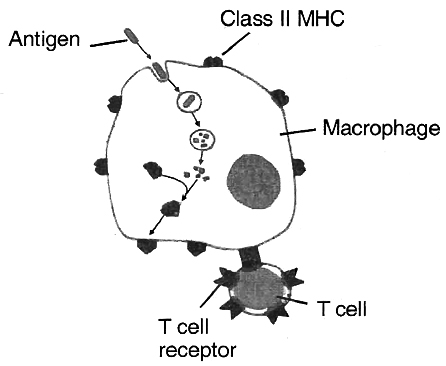
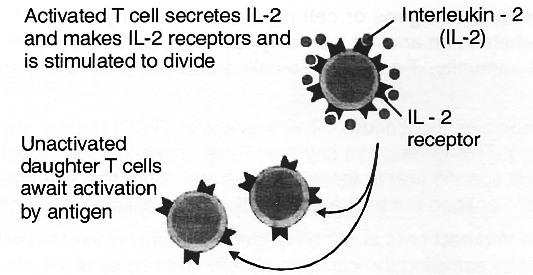
Clonal Selection and Primary and Secondary Immune Responses
Each Band T lymphocyte displays on its surface a specific receptor; the number of cells expressing a given receptor is rather small.
In case of a B cell, this receptor is the antibody produced by that cell.
When this receptor interacts with the antigenic determinant specific to it, the lymphocyte becomes activated and divides to form a clone of cells.
These cells are also transformed into effector cells, i.e., antibody producing B cells and T cytotoxic cells.
This phenomenon is called clonal selection, where all the cells in a given T or B cell clone are derived from a single parental cell, and exhibit the same specificity for antigenic determinant.
But some of the activated lymphocytes develop into long-lived memory cells, and do not produce antibodies or kill infected cells.

The immune response mounted as a result of the first encounter of an animal with an antigen takes relatively longer, is feeble, and declines rapidly.
This is known as primary immune response.
But a subsequent encounter of this animal with the same antigen results in a hightened immune response much more rapidly.
This is referred to as the secondary immune response or anamnestic response.
The secondary response is due to the memory cells that were produced during the primary response; it lasts much longer than primary response.
This is why a person surviving a disease like chicken pox or measles becomes immune to subsequent attacks of the same disease.
Development of Immunity
A person may develop immunity in three ways.
(i) Vaccination: It is a technique to develop immunity without infection. Weakened or dead pathogens (attenuated) or parts of pathogens are injected into a person who is required to be made immune. The pathogens given in a vaccine are unable to cause the disease but are sufficient to stimulate the formation of antibodies by the host's immune system. Often 2 or 3 additional doses are needed to generate adequate immunity. These doses are called booster doses.
(ii) Antitoxins: Antibodies that neutralize toxins produced in the body or introduced from outside are called antitoxins. Bacterial toxins are produced in the body, however antitoxins produced from outside are prepared from snake venom and is used as a remedy for snake bite.
(iii) Immunity through diseases: Some diseases such as mumps, measles, small pox produce a life long immunity. Hence these diseases do not appear again.
Types of Immunity: There are two main types of immunity : Inborn or innate and acquired or adaptive.
(i) Inborn or innate immunity: This type of immunity is inherited by the organism from their parents and protects it from birth throughout life. Example : Human beings have inborn immunity against distemper (a fatal disease of dogs).
(ii) Acquired or adaptive immunity: This immunity is acquired in life time. The acquired immunity is of two types: Active or natural and passive or artificial.
(a) Active immunity: When an organism's own cells produce antibodies it is called active immunity. It develops when a person suffers from a disease or gets vaccination for a disease.
(b) Passive immunity: In passive immunity, the antibodies are produced in some other organisms (e.g., vertebrates) in response to the given antigen. These antibodies are then injected into the human body at the time of need. This is known as inoculation. For example, persons infected by rabies, tetanus, Salmonella (causes food poisoning) and snake venom are given the sufficient amount of antibodies so that they can survive.
Passive immunity provides immediate relief, however, active immunity requires some time for the formation of antibodies.
There is another form of passive immunity. Nursing mothers transfer antibodies prepared in their body to the infants in their milk. Bottle-fed infants do not get this benefit. After a few weeks, infants own immunity system starts working.
Table : Differences between Active Immunity and Passive Immunity

History of Vaccination and Immunisation
In vaccination weakened or dead pathogens, or portions of pathogens, are injected into a person who is required to be made immune.
The pathogens given in a vaccine are unable to cause the disease, but are sufficient to stimulate the formation of antibodies by host's cells.
The process of vaccination was initiated by Edward Jenner in 1790.
He observed that milkmaids did not contract smallpox apparently because they were exposed to a similar but milder form of disease called cowpox.
Edward Jenner infected first James Phipps, a healthy boy of about 8 years with cowpox and two months later he infected the boy with smallpox.
The boy did not suffer from small pox.
Jenner proposed that an induced mild form of a disease would protect a person from a virulent form (which has ability to damage the host).
He used the term vaccine (in Latin Vacca means 'cow') and the term vaccination for protective inoculation.
Edward Jenner was the first to discover a safe and effective means of producing artificial immunity against small pox.
Thus once vaccination is done the individual is protected from the disease.
Vaccination develops acquired immunity.
Pasteur confirmed Jenner's findings and produced vaccines for other diseases like anthrax, rabies and chicken cholera.
In 1891, another daring step was taken which added to the growing understanding of immunology.
A little girl lay dying of diphtheria.
Her physician, Emil von Behring, decided to gamble on her life.
He infected sheep with diphtheria bacteria and waited for some time.
He then withdrew some blood from the sheep, and separated the serum by allowing it to clot.
He injected the serum into the patient.
Within a few hours she began to recover dramatically.
A new method of treatment had been discovered -passive immunity.
Von Behring was awarded the Nobel prize for this work.
Passive immunisation is the practice of taking antibodies produced by a vertebrate, in response to deliberate infection, and transferring them to a different organism by injection.
For instance, persons infected by rabies or Salmonella (that causes food poisoning) are likely to succumb to the disease as they would not be able to produce sufficient amounts of antibodies quickly.
To avert death, such persons are inoculated with antibodies produced in plasma of horses or cow.
This provides passive immunity.
IMMUNE SYSTEM DISORDER
Improper functioning of immune system can cause, discomfort, disease or even death. These disorders may involve :
1. Hypersensitivity or Allergy :
Allergy means inappropriate and excessive response to common antigens.
Substance causing allergic reaction are called allergens.
The common allergens are dust, pollen, mould, spores, fabrics, feathers, fur, plants, bacteria, foods, heat, cold, sunlight.
Parthenium flower is a common allergen in India.
Allergy mostly affects the skin and the mucous membrane.
Hay fever affects the mucous membranes of the nose, eyes and upper respiratory tracts.
In asthma, the lower portions of the respiratory system are severely affected.
In eczema, the skin becomes red, followed by the appearance of minute blisters.
During allergic reaction there is increased release of histamine from mast cells.
It causes marked dilation of all the peripheral blood vessels and the capillaries become highly permeable so that large amounts of fluid leak out from the blood into the tissues.
The blood pressure decreases drastically often resulting in the death of the individual within a short time.
Spleen is called the shock organ of allergy.
The exact nature of the substance of which a person is hypersensitive must be known before he can be properly treated.
Some forms of allergy are mentioned below:
(i) Hay fever: In this allergic form, there is swollen, reddened, running eyes and nose. The drugs called antihistamines are of major importance in the treatment of this allergic disorder.
(ii) Asthma: It is the sudden spasm of tissue surrounding respiratory tract causing narrowing of respiratory tract. The tissue surrounding the respiratory tubes in the lungs swell up and compress the tubes. Hence there is difficulty in breathing.
(iii) Anaphylactic shock : It is an allergic reaction involving all the tissues of the body and occurs in a few minutes after the injection of an antigen such as penicillin. Such a reaction is very serious. Histamine released from ruptured mast cells causes marked dilation of all the arteries so that a large amount of fluid is passed from the blood to the tissues and there is a drastic fall in blood pressure. The affected person may become unconscious and the individual may die within a short time.
2. Autoimmunity:
Andibodies are produced against antigens but sometimes it may also happen that the immune system of the body goes off the track and starts behaving against the 'own body' or 'self'.
This leads to a variety of diseases known as autoimmune diseases.
This type of diseases depends on which type of 'self-antigen' is involved.
When the cells acting as antigens in the same body, they are called autoantigens.
The nature of autoimmune diseases depends on the autoantigens involved.
For example, if the autoantigens are RBCs then the body destroys its own RBC resulting in chronic anaemia; if the autoantigens are produced against acetylcholine receptors (Myasthenia gravis); if the autoantigens are liver cells, then it results in chronic hepatitis, etc. Other autoimmune diseases are insulin-dependent diabetes, Addison's disease, ulcerative colitis and rheumatoid arthritis.
3. Immuno deficiencies
(i) Severe combined immuno deficiency (SCID) :
Sometimes new born children are without T-cells and B-cells.
These children are highly susceptible to various infections.
The most serious disorder of this type is a congenital disease known as severe combined immuno deficiency (SCID) in which both B-cells and T-cells are not present in the body.
Such children are highly susceptible even to minor infections.
In developed countries like U.S.A. such children are kept alive by keeping them in germ-free environments called isolation suits.
(ii) Acquired immune deficiency syndrome (AIDS) :
It is a disorder of cell mediated immune system of the body.
There is a reduction in the number of helper T-cells which stimulate antibody production by B-cells.
This results in the loss of natural defence against viral infection.
4. Graft rejection:
Grafts of a kidney, heart, lung, liver, etc. from one human to another always (unless donated by an identical twin) are seen by the recipient's immune system as antigenic and elicit an immune response.
If unchecked, this response will eventually lead to destruction of the graft. Both CD4+ and CD8+ T cells participate in graft rejection.
They are responding to differences between donor and host of their class II and class I histocompatibility molecules (respectively).
5. Graft-versus-host disease:
Grafts of bone marrow are used to provide, or restore, a source of blood cells for the recipient.
If there is any histocompatibility differences between donor and recipient (and there always are some, unless the patient's own marrow is used or that of an identical twin), then the T cells of the donor will mount an immune response against the tissues of the recipient.
Fortunately, graft-versus-host disease can usually be controlled with immunosuppressive drugs.
AIDS
- Books Name
- A TEXT OF BIOLOGY - CLASS XII
- Publication
- ACME SMART PUBLICATION
- Course
- CBSE Class 12
- Subject
- Biology
AIDS
AIDS (Acquired Immune Deficiency Syndrome) is a deadly disease, caused by HIV (human immunodeficiency virus), which mounts a direct attack on all cells that have a specific protein called CD4 on their surfaces.
CD4 is found on a class of lymphocyte cells called T4-cells.
This class includes Helper T-cells, which is why HIV destroys the body's population of Helper T-cells.
CD4 receptors are also found on macrophage surfaces, and as a result, macrophages also become infected with HIV.
Much of the HIV transmission from one individual to another is thought to occur within macrophages passed as part of body fluids.
Macrophages thus act as HIV factory.
A simplified definition of AIDS includes anyone infected with HIV and having a T4 lymphocyte count under 200/mm3 of blood. (Normally, the T4 count would be about 1200/mm3).
AIDS was first recognized in June 1981 as a result of reports from the Los Angeles area (U.S.A.) to the Center for Disease Control and Prevention (CDC) of several cases of a very rare type of pneumonia caused by a fungus.
The pneumonia, called Pneumocystis carinii pneumonia (PCP), occurred among homosexual males.
At about the same time, the CDC also received reports from New York and Los Angeles concerning an increase in the incidence of Kaposi's sarcoma (KS) amongst homosexual males.
AIDS was first recognised in USA in 1981.
In 1984, American and French scientists independently identified the agent as a virus.
The Americans named it HCLV-III (Human Cell Leukaemia Virus-III).
The name human immune deficiency virus is now preferred.
There are two types of HIV namely HIV-1 and HIV-2; the most common virus currently associated with AIDS is HIV-1.
A virus found in the blood of wild African green monkey, called the Simian immonodeficiency virus (SIV), is similar to HIV-2.
The genome of HIV consists of two indentical molecules of single stranded RNA and is said to be diploid.
HIV consists of a core RNA with Reverse Transcriptase surrounded by a protein coat.
The protein coat around the core consists of a protein called P24.
Outside this protein coat is a layer composed of another protein called P17.
The outermost envelope consists of a phospholipid bilayer studded with glycoproteins (GP120 and GP41).
HIV is a retrovirus; using the enzyme reverse transcriptase, it can synthesize DNA from RNA.
Once HIV produces DNA from its RNA, the DNA is integrated into the host cell's DNA.
There it can remain dormant, giving no sign of its presence, or it can take over the host cell's genetic machinery to produce more viruses.
The major cell infected by HIV is the Helper T-Iymphocyte that bears the CD4 receptors site.
The attachment of virus of CD4 receptor site is by the help of GP120 on the protein coat of the virus.
HIV enters body cells by receptor-mediated endocytosis.
The receptor of docking protein that permits HIV entry is the CD4 molecule on the surface of T4 cells, although other cellular factors, not yet understood, must also contribute.
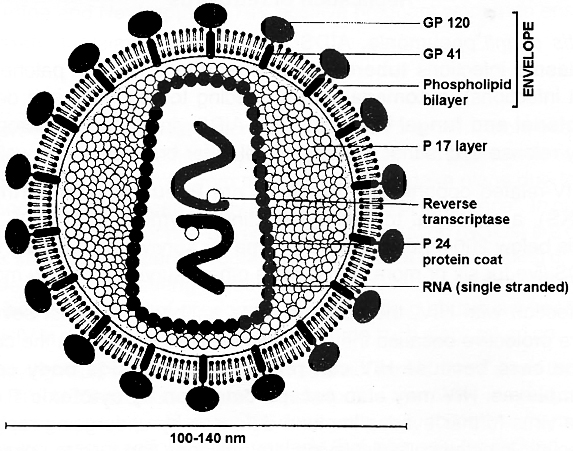
With time, the number of T4 cells, mainly Helper T cells, declines due to death of infected cells.
The result is progressive collapse of the immune system.
Since cytokines secreted by Helper T cells normally stimulate the activity of monocytes, neutrophils, and macrophages, nonspecific defense mechanisms also are depressed.
The person becomes susceptible to opportunistic infections, invasion of normally harmless microorganisms that now proliferate wildly because of the defective immune system.
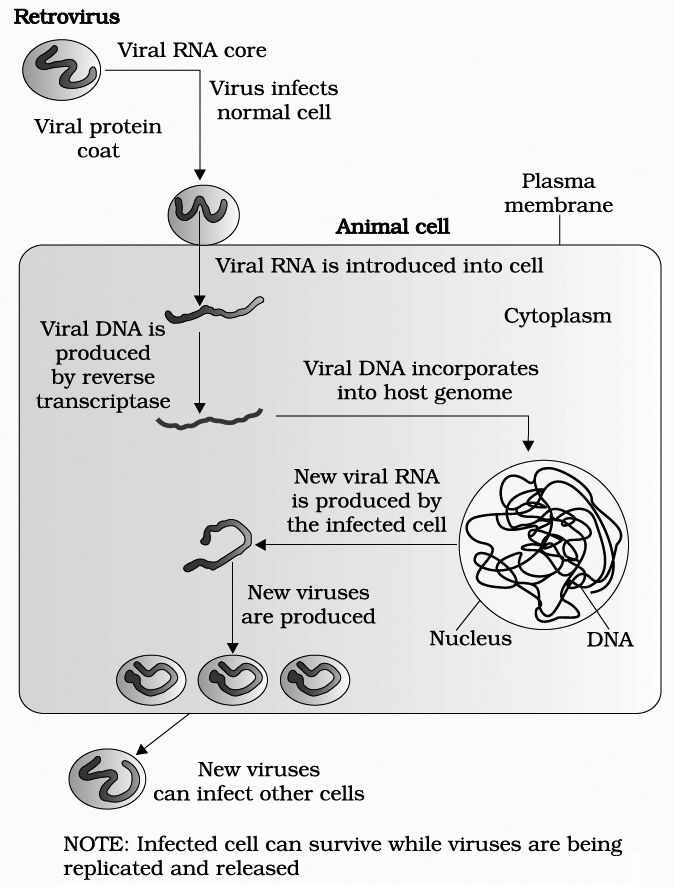
Besides Pneumocysfis carinii pneumonia, AIDS victims have persistent diarrhoea and are especially susceptible to Toxoplasma infections tuberculosis, leukoplakia (whitish patches on mucous membranes primarily due to yeast infections), cytomegalovirus (leading to blindness and dementia), Herpes simplex, among may other bacterial and fungal infections.
The AIDS virus infects macrophages, brain cells (where HIV-infected cells may release toxins that disrupt and kill other brain cells), as well as T4 cells.
The most common HIV-related opportunistic infections are Pneumocystis carinii pneumonia (PCP) and Kaposi's sarcoma (KS), a cancer of the skin.
The clinical symptoms of AIDS usually appear when the T-Iymphocyte level falls below 200/mm3.
The median time for survival after a diagnosis of AIDS is two years.
Some people with AIDS live for six or more years, while others survive for a few months only.
Some weeks after infection with HIV, the host develops antibodies against several proteins in the virus.
Antibodies normally are protective because they help eliminate an intruder.
In the case of the AIDS virus, this is not necessarily the case because HIV can remain hidden inside body cells, unavailable to form antigen-antibody complexes.
HIV may also escape detection by cytotoxic T cells, natural killer cells, and phagocytes.
The virus further evades immune defenses by undergoing rapid antigenic changes in its surface proteins.
Moreover, infected cells displaying viral acntigens can fuse to uninfected cells and spread the virus that way.
In rare cases, a person may harbor HIV without forming antibodies against it.
Thus, a standard blood test that detects antibodies would be negative.
The presence of nucleic acids from HIV can still be detected using a method called the polymerase chain reaction (PCR).
Once the host is infected by HIV, a detectable antibody response occurs in most cases within 6-8 weeks.
HIV antibodies can be detected by the ELISA test (enzyme-linked immunosorbent assay).
A positive ELISA should be confirmed using another test called the Western blot test.
Although HIV has been isolated from several body fluids, the only documented transmissions are from blood, semen, or vaginal secretions or by way of breast milk from a nursing mother to her baby.
The virus is found free and in macrophages in these fluids.
HIV is transmitted by sexual contact most commonly.
HIV is also effectively transmitted through exchanges of blood, for example, by contaminated hypodermic needles, contact with open wounds, or using the same razor blade for shaving.
Infected mothers may transmit the virus to their infants before or during birth.
It does not appear that people become infected as a result of routine nonsexual contact.
There is no known case of transmission from a mosquito bite.
It also appear that health-care personnel who take proper routine barrier precautions when dealing with body fluids (gloves, masks, safety glasses) are not at risk unless the barriers fail.
Outside the body, HIV is fragile and can easily be eliminated.
For example, dishwashing and clotheswashing, by exposing the virus to 135°F (56°C) for 10 minutes, will kill HIV.
Chemicals such as hydrogen peroxide (H2O2), rubbing alcohol, household bleach, and germicidal skin cleaner (such as Dettol) are also very effective, as is standard chlorination in swimming pools and hot tubs.
Medical scientists are engaged in an immense effort to find a cure for AIDS.
One of the problems in treating AIDS is that HIV can lie undetected in body cells.
In addition, HIV can infect a variety of cells, including those in the central nervous system that are protected by the blood-brain barrier.
Added to this is the problem of opportunistic infections, which may be very difficult to treat.
Any therapy must overcome the problem that antiviral agents may also harm host cells.
Thus scientists are trying to devise strategies for disrupting specific viral activities.
Some research centers on preventing binding of the virus to the host CD4 protein.
Other strategies are to prevent conversion of RNA to DNA, which is catalyzed by reverse transcriptase, block processing of viral proteins by specific viral enzymes, inhibit assembly of viruses within the host cell, and thwart release of new viruses.
To date, four drugs with similar action are used to inhibit HIV replication and slow the progression of AIDS.
All are nucleoside analogs, substances that are similar to the naturally occurring nucleosides in RNA and DNA.
They block conversion of retroviral RNA into DNA.
The first and still most commonly used drug to treat AIDS is AZT (azidothymidine) or Retrovir.
Among patients taking AZT, there is a slowing in the progression of symptoms.
The main side effects are red bone marrow damage and anemia.
Eventually, the virus develops resistance to the drug.
Other drugs are DDI (dideoxyinosine), DDC (dideoxycytidine), and D4T (stavudine), which may be used in patients who do not respond to AZT or have become resistant to it.
Doctors generally give Zidovudine and Nevirapine to HIV positive pregnant woman to ensure that their babies do not carry the infection.
Prevention of AIDS
As AIDS has no cure, prevention is the best option.
Moreover, HIV infection, more often, spreads due to conscious behaviour patterns and is not something that happens inadvertently, like pneumonia or typhoid.
Of course, infection in blood transfusion patients, new-borns (from mother) etc., may take place due to poor monitoring.
The only excuse may be ignorance and it has been rightly said -"don't die of ignorance".
In our country the National AIDS Control Organisation (NACO) and other non-governmental organisation (NGOs) are doing a lot to educate people about AIDS.
WHO has started a number of programmes to prevent the spreading of HIV infection.
Making blood (from blood banks) safe from HIV, ensuring the use of only disposable needles and syringes in public and private hospitals and clinics, free distribution of condoms, controlling drug abuse, advocating safe sex and promoting regular check-ups for HIV in susceptible populations, are some such steps taken up.
Infection with HIV or having AIDS is something that should not be hidden -since then, the infection may spread to many more people.
HIV/AIDS-infected people need help and sympathy instead of being shunned by society.
Unless society recognises it as a problem to be dealt with in a collective manner -the chances of wider spread of the disease increase manifold.
It is a malady that can only be tackled, by the society and medical fraternity acting together, to prevent the spread of the disease.
Cirrhosis
Cirrhosis refers to a distorted or scarred liver as a result of chronic inflammation.
The parenchymal (functional) hepatocytes are replaced by fibrous or adipose connective tissue.
The symptoms of cirrhosis include jaundice, edema in the legs, uncontrolled bleeding, and increased sensitivity to drugs.
Cirrhosis may be caused by hepatitis (inflammation of the liver), certain chemicals that destroy hepatocytes, parasites that infect the liver, and alcoholism.
HEPATITIS
1. Hepatitis refers to inflammation of the liver and can be caused by viruses, drugs, and chemicals, including alcohol. Clinically, several viral types are recognized. Hepatitis A (infectious hepatitis) is caused by hepatitis A virus and is spread by faecal contamination of food, clothing, toys, eating utensils, and so forth (faeco-oral route). It is generally a mild disease of children and young adults characterized by anorexia (loss of appetite), malaise, nausea, diarrhoea, fever, and chills. Eventually jaundice appears. Most people recover in 4-6 weeks. Hepatitis A virus has single-stranded RNA genome and non-enveloped capsid.
2. Hepatitis B (serum hepatitis) is caused by hepatitis B virus. HBV is a 42 nm enveloped virion, containing partially double-stranded circular DNA genome. Within the core there is DNA-dependent DNA polymerase. It is spread primarily by sexual contact and contaminated syringes and transfusion equipment. It can also be spread by saliva and tears. Hepatitis B virus can be present for years or even a lifetime and can produce cirrhosis and possibly cancer of the liver. Persons who harbor the active hepatitis B virus are at risk for cirrhosis and also become carriers. Vaccines produced through recombinant DNA technology (for example, Recombivax HB) are available to prevent hepatitis B infection. This vaccine is second generation vaccine.
3. Hepatitis C (non-A, non-B hepatitis) is caused by hepatitis C virus. It is clinically similar to hepatitis B and is often spread by blood transfusions. Hepatitis C can cause cirrhosis and possibly liver cancer. It has enveloped virion with ss-RNA.
4. Hepatitis D (delta hepatitis) is caused by hepatitis D virus which has ss-RNA. It is transmitted like hepatitis B. In fact, a person must be coinfected with hepatitis B before contracting hepatitis D. Hepatitis D results in severe liver damage and has a fatality rate higher than that of people infected with hepatitis B virus alone. HDV is a defective virus for which HBV is the helper.
5. Hepatitis E (infectious NANB hepatitis) is caused by hepatitis E virus and is spread like hepatitis A. Although it does not cause chronic liver disease, hepatitis E virus is responsible for a very high mortality rate in pregnant women. HEV has ss-RNA.
Table : Important properties of Hepatitis Virus
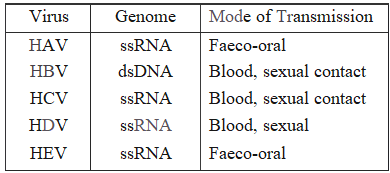
MENTAL HEALTH
Mental illness is characterised by the following symptoms: (i) depression, (ii) insomnia (lack of sleep) or excessive sleeping, (iii) compulsive actions, (iv) feeling of hopelessness, (v) serious thoughts of suicide, (vi) unreasonable phobias, (vii) partial or complete loss of memory, (viii) self-destructive behaviour, e.g., excessive gambling, drinking, drug abuse, over-eating and extreme dieting, (ix) delusions (false beliefs) and hallucinations, and (x) vocational and social dysfunctioning on a day-to-day basis.
Hallucination is a subjective disorder of sensory perception, in which one of the senses is involved in the absence of external stimulations.
Psychological Disorders
These include psychosis and neurosis, Psychosis involves deeper mental disorientation due to a distorted sense of reality.
Neurosis, on the other hand, is a maladaptive habit.
Neurotic individual relates to the same "real world" as does the normal, but cannot effectively act upon it. Important psychological disorders are as follows:
(i) Anxiety disorders: It is associated with a range of unpleasant bodily symptoms, including palpitation, sweating, nausea, trembling, diarrhoea and muscular tension.
(ii) Obsessive-compulsive disorders: These disorders cause total disability and affect a person's waking hours. Affected persons manifest overwhelming obsessions and compulsions. They are compelled to perform an action or an idea despite their own attempt to resist it (compulsion) . The most common obsessions are violence, concern about infection by germs or dirt, and constant doubts (obsessions).
(iii) Attention deficit disorder: It is a mental health problem among children. It occurs more in boys than in girls. As a result of this disorder, the boys exhibit under achievement, behavioural problems and a tendency to be disliked by other children.
(iv) Mood disorders: These are the occasional bouts of high or low mood, i.e., elation and depression. Depression is a mood disorder characterised by sadness, hopelessness, low self-esteem, decline in interest, energy, concentration and changes in sleep pattern and appetite.
(v) Schizophrenia: It is characterised by (a) distorted thoughts (b) laughing or crying at completely inappropriate times (c) often disturbed emotions with rapid shifts from one extreme response to other, and (d) incoherent and bizarre behaviour lasting for a week or more. Schizophrenic may also suffer from delusions, auditory hallucinations and can find difficulty in handling even the simplest jobs.
(vi) Borderline personality disorder (BPD) : This disorder is an emotionally unstable personality disorder, which is characterised by impulsivity, unpredictable moods, outbursts of emotion, behavioural explosions, quarrelsome behaviour, and conflicts with others. BPD can be diagnosed with specific patterns of behavioural, emotional, and cognitive instability and dysregulations. These individuals are highly reactive, and generally experience episodic depression, anxiety, and irritability. They also have problems with anger and anger expression. Relationships with other individuals are chaotic, intense, but nevertheless, hard to give up. Individuals with BPD often attempt to injure, multilate, or kill themselves, and have little sense of self since they feel empty.
Cancer
- Books Name
- A TEXT OF BIOLOGY - CLASS XII
- Publication
- ACME SMART PUBLICATION
- Course
- CBSE Class 12
- Subject
- Biology
CANCER
Cancer is characterised by the uncontrolled multiplication of abnormal cells in the body.
The spread of cancerous cells to distant sites via blood is termed metastasis.
Normally cells show a property called contact inhibition by virtue of which contact with other cells inhibits their uncontrolled growth but cancer cells have lost this property.
It may be broadly classified into three major categories:
(a) Carcinomas are malignant growths of the epithelial (ectodermal) tissues that cover or line the body organs. e.g., skin cancer, breast cancer, lung cancer, cancer of the stomach and pancreas (about 85 percent of all tumors are carcinoma).
(b) Sarcomas are malignant growths arising in tissues derived from primitive mesoderm. e.g., bone tumors, muscle tumors, cancer of lymph nodes. They are rare in human beings (about 1 percent of all tumors).
(c) Leukaemias result from unchecked proliferation of cell types present in blood and their precursors in the bone marrow.
Cancer is a complex group of diseases that can affect many different body cells and tissues.
All cancers are characterized by the uncontrolled growth and division of cells.
Cancer leads to a mass of cells termed as neoplasm (Gr. for new formation) or tumor.
Abnormal and persistent cell division localized in a particular region is called benign tumor.
Benign tumor contains well-differentiated cells, not usually dangerous.
Tumor cells may be carried by blood stream or lymph or penetrate directly to other parts of the body resulting in dangerous malignant tumors and the spread of cancerous cells to distant sites is termed metastasis.
Other types of cancers are:
Melanoma : Cancer of pigment cells of the skin
Adenoma : Cancer of glands
Myoma : Cancer of muscular tissue
Lymphoma : Cancer of lymphatic tissue
Glioma : Cancer of glial cells of CNS
Oncology is the study of cancer.
All cells carry certain cancer associated proto-oncogenes.
Susceptibility to cancer depends upon familial factors, smoking, chemical and enviromental factors, viral factor, alcohol and dietary factors.
Any agent that induces a cancer is carcinogenic or oncogenic agent.
Exposure to ionizing radiations, such as X-rays, gamma rays, and non-ionizing UV-rays are said to induce cancer.
Chemical substances that can cause mutation are called carcinogens.
Physical irritants can also lead to cancer, such as continued abrasion of the lining of the intestinal tract by some type of food.
In many families, there is a strong hereditary tendency to cancer.
Viruses cause a number of specific cancers in animals.
Tumor producing viruses are called oncoviruses.
Table-III : Some Cancer causing agents and their Targets
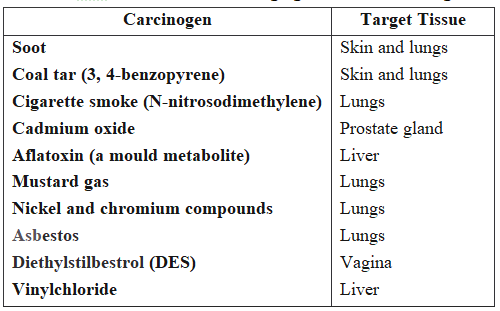
Viruses are a second cause of cancer.
These agents are tiny packages of nucleic acids, either DNA or RNA, that are capable of infecting cells and converting them to virus-producers.
Although the link between viruses and cancer is strongly established for a variety of animal cancers, the relation in human cancers is less predictable.
Clearly, the number of people infected with these viruses is much larger than the number who develop cancer.
But evidence suggests that chronic viral infections are associated with up to one-fifth of all cancers. These include:
(a) Human T-cell leukemia virus-1 (HTLV-1), associated with leukemia, a malignant disease of bloodforming tissues, and lymphoma, a cancer of lymphatic tissue.
(b) Human immunodeficiency virus (HIV), associated with Kaposi's sarcoma, a cancer of blood vessels in the skin.
(c) Epstein-Barr virus (EBV), which causes infectious mononucleosis, associated with Burkitt's lymphoma, a cancer of white blood cells, nasopharyngeal carcinoma (common in Chinese males), and Hodgkin's disease -a lymphatic system cancer. Here Burkitt and Hodgkin are the names of discoverers.
(d) Hepatitis B virus (HBV), associated with liver cancer.
(e) Human papilloma virus (HPV), which causes genital warts (benign growths) associated with cancer of . the cervix, vagina, penis, and colon.
(f) Type 2 herpes simplex virus, which causes genital herpes, implicated in cancer of the cervix of the uterus.
Cancer may cause a variety of minor symptoms. Any that persist for several days should be checked by a doctor. The earlier a cancer is diagnosed the better the chance of cure
(a) Rapid weight loss without apparent cause
(b) A scab, sore of ulcer that fails to heal within 3 weeks
(c) A blemish or mole that enlarges, bleeds or itches
(d) Severe recurrent headaches
(e) Difficulty in swallowing (~ Persistent hoarseness of voice
(g) Coughing of blood sputum (phlegm)
(h) Persistent abdominal pain
(i) Change in shape or size of testes
(j) Blood in urine, with no pain on urination
(k) Change in bowel habits
(l) Lump or change in breast shape
(m) Bleeding or discharge from nipple
(n) Vaginal bleeding or spotting between periods or after menopause
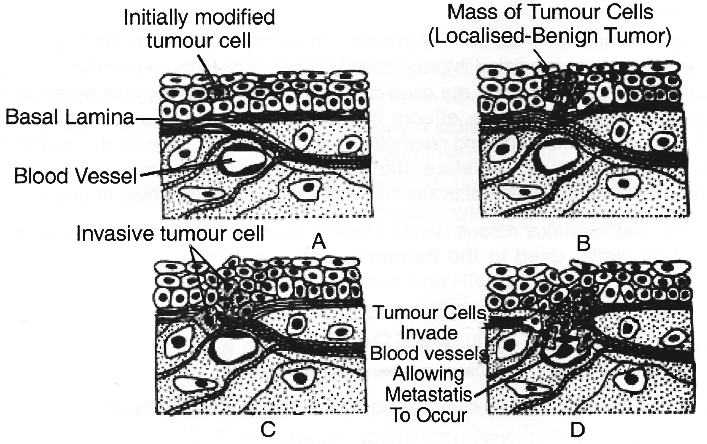
Cells of malignant tumors duplicate continually and very often quickly and without control.
Such an increase in the number of cells due to an increase in the frequency of cell division is called hyperplasia.
Initially, malignant cells invade surrounding tissues.
As the cancer grows, it expands and begins to compete with normal tissues for space and nutrients.
Eventually, the normal tissue decreases in size (atrophies) and dies.
Following the nearby invasion, some of the malignant cells may detach from the initial (primary) tumor.
They may invade a body cavity or enter the blood or lymph, which can lead to widespread metastasis.
Next, those malignant cells that survive in the blood or lymph invade other body tissues and establish secondary tumors.
Finally, the secondary tumors become vascularized.
They undergo angiogenesis, which is the growth of new networks of blood vessels.
Any new tissue, whether it results from repairing a wound, normal growth, or tumors, requires a blood supply to deliver nutrients and oxygen.
Proteins that serve as chemical triggers for blood vessel growth in tumor tissue are called Tumor Angiogenesis Factors (TAFs).
In all stages of metastasis, the malignant cells resist the antitumor defenses of the body.
The pain associated with cancer develops when the growth puts pressure on nerves or blocks a passageway so that secretions build up pressure.
Cancer Detection and Diagnosis
Early detection of cancers is essential as it allows the disease to be treated successfully in many cases.
Cancer detection is based on biopsy and histopathological studies of the tissue and blood and bone marrow tests for increased cell counts in the case in leukemias.
In biopsy, a piece of suspected tissue cut into thin sections is stained and examined under microscope (histopathological studies) by a pathologist.
Techniques like radiography (use of X-rays), CT (Computed tomography) and MRI (Magnetic resonance imaging) are very useful to detect cancers of the internal organs.
MRI is the safest method for detection of cancer.
Computed Tomography uses X-rays to generate a three-dimensional image of the internal of an object.
MRI uses strong magnetic fields and non-ionising radiations to accurately detect pathological and physiological changes in the living tissue.
Antibodies against cancer-specific antigens are also used for detection of certain cancers.
For example, "Herceptin". Monoclonal antibodies are used for the diagnosis of breast cancer.
Techniques of molecular biology can be applied to detect genes in individuals with inherited susceptibility to certain cancers.
Identification of such genes, which predispose an individual to certain cancers, may be very helpful in prevention of cancers.
Such individuals may be advised to avoid exposure to particular carcinogens to which they are susceptible (e.g. tobacco smoke in case of lung cancer).
Treatment of Cancer
The common approaches for treatment of cancer are surgery, radiation therapy and immunotherapy.
In radiotherapy, tumor cells are irradiated lethally, taking proper care of the normal tissues surrounding the tumor mass.
Several chemotherapeutic drugs are used to kill cancerous cells.
Some of these are specific for particular tumors.
Majority of drugs have side effects like hair loss, anemia, etc.
Most cancers are treated by combination of surgery, radiotherapy and chemotherapy.
Tumor cells have been shown to avoid detection and destruction by immune system.
Therefore, the patients are given substances called biological response modifiers such as a-interferon which activate their immune system and help in destroying the tumor.
A common weed, Catharanthus roseus (Vinca rosea or Sadabahar), is the source of two anticancer drugs, Vincristin and Vinblastin, used in the treatment of leukaemia.
drugs and alcohol abuse
- Books Name
- A TEXT OF BIOLOGY - CLASS XII
- Publication
- ACME SMART PUBLICATION
- Course
- CBSE Class 12
- Subject
- Biology
Drugs and Alcohol Abuse
Surveys and statistics show that use of drugs and alcohol has been on the rise especially among the youth.
This is really a cause of concern as it could result in many harmful effects.
Proper education and guidance would enable youth to safeguard themselves against these dangerous behaviour patterns and follow healthy lifestyles.
The drugs, which are commonly abused are opioids, cannabinoids and coca alkaloids. Majority of these are obtained from flowering plants. Some are obtained from fungi.
Addictive Disorders
If the body needs continuous presence of psychoactive substance within it, it is called addiction.
Psychoactive drugs have the ability to alter the activity of nervous system.
Different psychoactive drugs along with their category and effects are given below.
Table : Major Categories of Psychoactive Drugs, their Effects and Clinical Uses
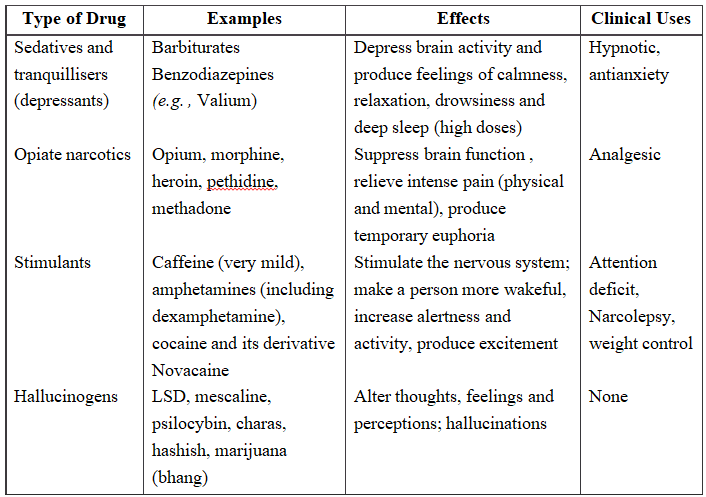
A person who is habitual user if abstains from a drug (abstinence), his body reacts i.e., ceases to function normally. It is called physical dependence.
The symptoms appearing in the body are withdrawal symptoms and range from mild tremors to convulsions, abdominal pain, diarrhoea, muscle cramps, all depending upon the type of drug abused.
In many cases the withdrawal symptoms may be life threatening and needs medical supervision.
1. Sedative-hypnotics :
Sedatives are the drugs that reduce excitement, assuage pain and lower the physiological or functional activity leading to drowsiness or sleep.
Hypnotics are also the drugs that induce sleep.
Sedative-hypnotics are more or less general CNS depressants and they include Barbiturates and Benzodiazepines.
Barbiturates and Benzodiazepines :
These are substituted derivatives of barbituric acid (a combination of melonic acid and urea; called malonyl urea) which are general depressants of all excitable cells but CNS is most sensitive to them.
They reduce anxiety and induce sleep. Repeated use of this causes to addiction.
It results in permanent damage to brain, headache, coma and muscular twitching.
Sudden withdrawal causes epilepsy.
2. Opiates (Opioid analgesics or Opiate narcotics) :
Opiates or opioids are derived from opium alongwith their synthetic relatives.
The drug that relieves pain by acting on CNS are termed as analgesic, they are also called pain killers.
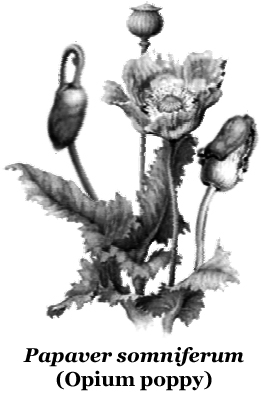
Opium is dried latex of unripe capsular fruits of poppy plant, Papaver somniferum (family; Papaveraceae).
It has heavy smell and bitter taste.
It is smoked or eaten.
Opioids bind to specific opioid receptors present in our CNS and gastrointestinal tract.
Opiates have narcotic, analgesic, sedative and astringent (that cause contraction of body parts) effects.
They slow down respiratory activity, cause constriction of pupil of eye, decrease glandular secretions, impair the digestion, produce nausea, vomiting and sterility.
Opium addicts lose weight, fertility and interest in work.
Opium contains a number of alkaloids :

(i) Morphine: Serturner, a pharmacist, isolated the active principal of opium in 1806 and named it 'morphine'. It is the main opium alkaloid, which is a strong analgesic and also has sedative and calming effect. Morphine depresses respiratory centre and contributes to the fall in SP. It can cause bradycardia (slow heart beat), release of ADH, reduction in urine output, constipation mild hyperglycaemia etc. It causes addiction. Diacetyl-morphine hydrochloride is brown sugar/smack and is more powerful analgesic than morphine.
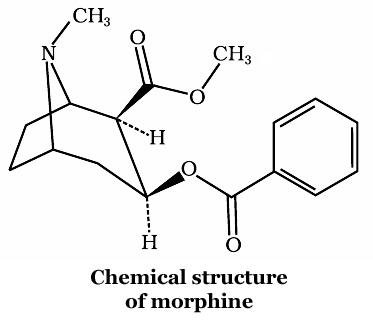
(ii) Codeine : A derivative of opium (methyl-morphine) which occurs naturally in opium and is partly converted in the body to morphine. It is mild analgesic; which do not cause addiction. It is an ingredient of many medicines and cough syrups. Its prominent side effect is constipation.
(iii) Heroin [Diamorphine or Diacetylmorphine] : Heroin also called as smack and is semisynthetic opiate which is addictive most dangerous of all the opiates. It is about 3 times more potent than morphine. Due to its high potency, it has been favoured in illicit drug trafficking, so it has been banned in most countries, Heroin is formed from morphine by acetylation. It is taken orally, or inhaled or injected, pure drug is seldom taken. It induces drowsiness and lethargy. Heroin causes indigestion, reduced vision, decreased weight, sterility and total loss of interest in work. Since the heroin addicts are careless about syringes and needles for injection so this may cause blood poisoning, abscess formation, hepatitis-S and AIDS. Withdrawal symptoms are unpleasant which include vomiting, diarrhoea, shivering, running nose, muscular and abdominal cramps and epilepsy.
(iv) Pethidine (Meperidine) : It is a synthetic opiate which is chemically unrelated to morphine but has many similar actions. Its analgesic efficiency is almost similar to morphine and is more than codeine. It is equally sedative and euphoriant. It causes less histamine release and is safer in asthmatics. It has local anaesthetic action. It is mostly metabolized in liver.
(v) Methadone: It is a synthetic opiate which is chemically dissimilar but pharmacologically very similar to morphine. It has analgesic, respiratory depressant, constipating actions similar to morphine. Withdrawal symptoms are gradual and less severe.
Concept Builder
Endorphins ("endogenous morphine") are endogenous opioid peptides that function as neurotransmitters.
They are produced by the pituitary gland and the hypothalamus in vertebrates during exercise, excitement, pain, consumption of spicy food and they resemble the opiates in their abilities to produce analgesia and a feeling of well-being.
The term "endorphin" implies a pharmacological activity (analogous to the activity of the corticosteroid category of biochemicals) as opposed to a specific chemical formulation.
It consists of two parts: endo and orphin, these are short forms of the words endogenous and morphine, intended to mean "a morphine-like substance originating from within the body.
3. Stimulants:
Drugs which stimulate the nervous system; make a person more wakeful, alert and active; and cause excitement.
However, addiction is psychological and withdrawal of stimulant is followed by depression, anxiety and restlessness. e.g., caffeine, cocaine, amphetamines etc.
(i) Caffeine:
It is bitter alkaloid; obtained from the leaves of tea plant, (Thea sinensis)-seeds of coffee plant, (Coftea arabica)-seeds of cocoa plant, (Theobroma cacao)-It is mild stimulant and taken as beverages-tea, coffee, cocoa and cola drinks.
Caffeine is CNS stimulant which provides a sense of wellbeing, alertness, beats boredome, thinking becomes clear, improves performance and also acts as cardiac and respiratory stimulant.
It is mild diuretic (increases urine output).
Caffeine increases contractile power of skeletal muscles.
BMR (Basal Metabolic Rate) and inhibits the release of histamine.
Higher doses of caffeine cause nervousness, restlessness, panic, insomnia (lack of sleep) and excitement.
Excessive intake of caffeine also causes addiction and indigestion and disturbs renal functions.
(ii) Cocaine:
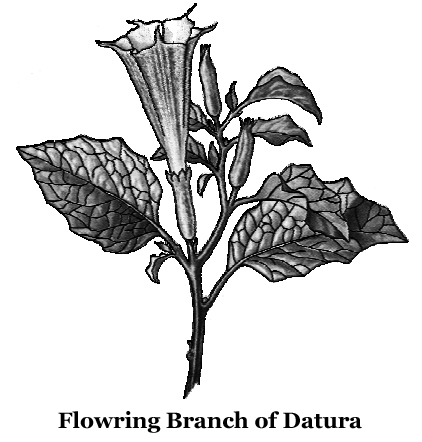
It is a natural alkaloid obtained from leaves of coca plant-Erythroxylum coca (Family; Erythroxylaceae).
It is bitter, white, crystalline powder with vasoconstrictor properties and hence, it is a good local anaesthetic.
It interferes with the transport of neuro-transmitter dopamine.
It is taken by snorting.
It is a powerful, CNS stimulant which induces a sense of wellbeing or euphoria and pleasure and delays fatigue.
It also increases heart beat, blood pressure and body temperature.
It is smoked or injected or inhaled by addicts.
It causes lack of sleep loss of appetite, headache, convulsions, insomnia, respiratory or cardiac failure and may lead to mental disorder.
Excessive dosage of cocaine causes hallucinations. Some other plants such as Atropa bellandona and Datura has hallucinogenic properties.
Concept Builder
The mechanism of action of cocaine:
Cocaine modifies the action of dopamine in the brain.
The dopamine rich areas of the brain are the ventral tegmental area, the nucleus accumbens and the caudate nucleus-these areas are collectively known as the brain's "reward pathway".
Cocaine binds to dopamine re-uptake transporters on the pre-synaptic membranes of dopaminergic neurons.
This binding inhibits the removal of dopamine from the synaptic cleft and its subsequent degradation by monoamine oxidase in the nerve terminal.
Dopamine remains in the synaptic cleft and is free to bind to its receptors on the post synaptic membrane, producing further nerve impulses.
This increased activation of the dopaminergic reward pathway leads to the feelings of euphoria and the 'high' associated with cocaine use.
(iii) Amphetamines:
They are synthetic drugs, commonly called pep pills, antisleep drugs or speed uppers because they are CNS stimulants.
They cause alertness, self-confidence, talkativeness and increased work capacity.
They stimulate respiratory centre and cause wakefulness and postponement of sleep and hence called antisleep drugs.
Due to slow metabolism, the drug is found in the urine for several subsequent days.
It is one of the drugs included in the 'dope test' for athletes, suppress hunger (anorexia) and cause addiction.
High doses of amphetamines produce euphoria, marked excitement, sleeplessness, nausea and vomiting.
4. Psychedelic Drugs (=Hallucinogens) :
The drugs which change one's mood, behaviour, thoughts and perceptions in a manner like that of seen in psychosis.
The hallucinogens generally produce a dreamlike state with disorientation and loss of contact with reality without any true sensory stimulus.
They cause hallucinations and usually make users to see sound and hear colour and also called vision producing drugs as they produce false imaginations or extreme feeling of either despair or euphoria by effecting cerebrum and sense organs.
Concept Builder
Hallucinogen :
A drug that causes hallucinations (profound distortions in a person's perceptions of reality).
Under the influence of hallucinogens, people see sound and hear colours and feel sensations that seem real but do not exist.
Some hallucinogens also produce rapid, intense emotional swings.
Hallucinogens cause their effects by disrupting the interaction of nerve cells and the neurotransmitter serotonin.
Distributed throughout the brain and spinal cord, the serotonin system is involved in the control of behavioral, perceptual, and regulatory systems, including mood, hunger, body temperature, sexual behavior, muscle control, and sensory perception.
(i) LSD (Lysergic acid diethylamide) : It is the most powerful psychedelic (=hallucinogen). It is a crystalline amidated alkaloid obtained from ergot, of fungus Claviceps purpurea that is parasite on rye plant. LSD was synthesized by Hofmann (1938). LSD causes horrible dreams, emotional outbursts, hallucination, chronic psychosis and severe damage to the central nervous system. LSD also brings about chromosomal and foetal abnormalities.
(ii) Mescaline: It is a white powdery alkaloid, obtained from the tops (called mescals) of a small spineless cactus, Lophophora williamsii. This cactus is also called 'Peyote cactus'. It is a low potency hallucinogen.
(iii) Psilocybin: It is obtained from the fruiting bodies of Mexican mushroom (fungus), Psilocybe mexicana (family: Agaricaceae). Psilocybin is a crystalline solid that may have value in psychological medicine. Its effects are similar to those of mescaline.
(iv) PCP (Phencyclidine piperidine) : It has stimulant, depressant, hallucinogenic and analgesic properties. Its higher dose may produce hypersalivation, vomiting, fever and even coma. It is widely used in veterinary medicine to briefly immobilize large animals.
Synthetic derivatives like DMT (Dimethyltryptamine), DOM (Dimethoxymethylamphetamine), DMA (Dimethoxyamphetamine) are also hallucinogenics.
(v) Products of Hemp plant: Known as 'Cannabinoids'. Tetrahydrocannabinol (THC) is present in hemp plant, Cannabis (family: Cannabinaceae) bhang, ganja, marijuana, etc., are the various forms in which THC is used as hallucinogen.
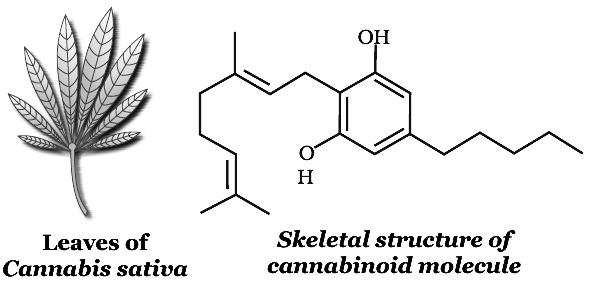
(a) Bhang: It is fresh/dried leaves and flowering shoots of both male and female plants of Cannabis sativa. Bhang is generally taken orally (e.g. , drink or in the form of pakora or tikki). It acts slowly.
(b) Ganja: It is the dried unfertilized female inflorescence of Cannabis sativa. It is smoked generally in cigarettes. It is more potent, and its effects are produced almost instantaneously.
(c) Charas: It is the dried resinous extract from the flowering tops and leaves of Cannabis sativa, which is most potent and smoked with tobacco. In some countries like America, charas is called hashish. Liquid hashish is called hash oil, which may contain a THC concentration of 25 to 60 percent.
(d) Marijuana: It is obtained from the dried flowers and top leaves of the female plants of Cannabis sativa, its most active ingredient is delta-9-tetrahydrocannabinol (Delta-9 THC). It is smoked in Cigarettes.
ALCOHOLISM
Alcoholism is a dependency of a person on regular consumption of alcohol either in low concentration (wine, bear etc.) or in high concentration (rum, vodka etc.)
Effects of Alcohol on an Individual
1. Effect on liver:
Absorbed alcohol is carried directly to the liver, where it becomes the preferred fuel.
Use of moderate amounts of alcohol does not cause liver damage, provided adequate nutrition is maintained.
However, chronic alcoholism causes the following diseases. (i) Alcoholic fatty liver. The liver becomes enlarged, yellow, greasy and firm. Hepatocytes (cells of liver) are distended by large fat globules which push the hepatocyte nucleus against the cell membrane. There is increase in the fat synthesis in the liver (ii) Alcoholic hepatitis. It is characterised by degeneration of hepatocytes. The damaged (degenerated) hepatocytes are surrounded by polymorphonuclear leucocytes. These hepatocytes may be pale and swollen and some contain dense eosinophilic masses called Mallory's hyaline. (iii) Alcoholic cirrhosis. With continued alcohol intake, there is destruction of hepatocytes and fibroblasts (cells which form fibres) and stimulation of collagen protein formation. (iv) Cholestasis (Gr. Chole -bile, stasis -a standing still). It is stoppage in the flow of bile. It is characterised by jaundice, abdominal pain and hepatomegaly (enlargement of liver).
2. Effect on nervous system : These are characterised as :
(i) Will power, judgement power and self control become reduced.
(ii) Control on emotion becomes reduced.
(iii) Moral sense becomes reduced.
(iv) Cerebellum becomes affected which results the loss of muscle co-ordination so affected person shows staggering gait and incoherent speech.
(v) Inflammation ofaxons of neurons leads to neuritis.
3. Effects on stomach :
High doses of alcohol cause ill effect on gastric glands of stomach, these glands secrete gastric juices in excess which cause the inflammation to gastric mucosa.
This condition is known as gastritis.
It may also result gastric carcinoma, peptic ulcer.
Dilute alcohol (optimum 10%) stimulates gastric secretion (specially acid).
Acute alcoholic intake can result in inflammation of the oesophagus (oesophagitis) and stomach (gastritis).
Chronic heavy drinking, if associated with violet vomiting, can produce a longitudinal tear in the mucosa at the gastrointestinal junction -a Mallory-Weiss syndrome (also called Mallory -weiss Lesion).
4. Effect on heart :
Due to deposition of alcoholic fat on the wall of blood vessels, the lumen of blood vessels becomes reduced, this increases the blood pressure and hence, the activity of heart.
Size of RBCs becomes increased but the number of RBCs, WBCs and platelets is reduced.
5. Effect on kidneys:
Alcohol reduces the release of hormone ADH (Antidiuretic hormone) due to which the excess amount of water is released from the body. So, alcoholism greatly causes dehydration condition.
6. Heavy drinking can cause an acute alcoholic myopathy characterized by painful and swollen muscles and high levels of serum creatine phosphokinase (CK).
7. Alcohol increases RBC size causing a mild anaemia. Chronic heavy drinking can also decrease production of white blood cells (WBCs). Alcohol may decrease platelet aggregation.
8. Effects on the skeletal system include alternations in calcium metabolism with an increased risk for fracture and osteonecrosis (death of bone mass) of the head of femur.
9. Hormonal changes include an increase in cortisol levels, inhibition of vasopressin, reversible decrease in serum thyroxine and a more marked decrease in serum triiodothyronine (T3).
10. Heavy drinking during pregnancy results in serious consequences for foetal development. The foetal alcohol syndrome (FAS) includes facial changes, poorly formed concha (cavity of pinna), small teeth with faulty enamel, defects in atria and ventricles of heart.
11. Regular intake of small to moderate amounts has been found to raise HDL -high density lipoproteins (good cholesterol) and lower LDL -low density lipoproteins (bad cholesterol) levels in the blood plasma. This may be responsible for lower incidence of coronary artery disease in such persons. Alcohol also reduces blood sugar level which is harmful to the functioning of brain.
12. Effect on immunity: Alcoholism reduces resistance to infection. The alcoholics in most cases, are victims of malnutrition and are easily susceptible to diseases like pneumonia.
13. Effect on family: The habit of drinking not only creates problems to the drinker but directly or indirectly affects the family and community life. Most drinkers do not think regarding needs of their children and other members of the family.
14. Effect on society: Alcoholism is invariably associated with social crimes and dissolution of moral and cultural inhibitions. Violence and other corrupt practices in the community are often directly or indirectly due to the drinking of alcohol.
Metabolism of Alcohol
In body the alcohol passes to the stomach.
Some amount of it also passes to proximal part of intestine.
Thus, stomach and proximal part of intestine absorb this alcohol and then transfer to blood and from blood to liver.
In liver, alcohol is converted to acetaldehyde with the help of enzyme alcohol dehydrogenase.
Acetaldehyde is oxidized by the enzyme acetaldehyde dehydrogenase.
It liberates the heat.
This heat is utilized in the synthesis of fat.
The excess of fat reduces the formation of glycogen, enzymes and structural proteins.
This condition is known as cirrhosis.
TOBACCO ADDICTION
Tobacco can be obtained from dried and cured leaves of young branches of two species of tobacco plant, Nicotiana tobaccum and N. rustica. Tobacco plant belongs to angiospermic family Solanaceae.
The use of tobacco was started in America where Red Indians were started use it. It spreads to Europe and other countries in early 1700s.
Table : Toxic substances of Tobacco and their effects
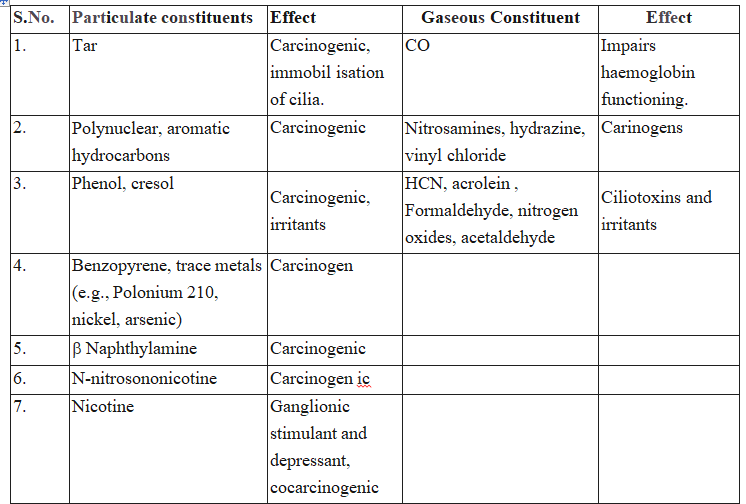
Tobacco Smoking and Diseases
1. Cancer: About 90% of victims of lung cancers are associated with smoking. Another cancer is mouth cancer due to chewing of tobacco.
2. Immunity becomes weak due to regular use of tobacco.
3. Use of tobacco increases the male infertility.
4. More adrenaline is released which increases blood pressure and heart rate. It may lead cardiovascular diseases.
5. In pregnant women, nicotine alkaloid reduces foetal growth and development.
6. Carbon monoxide present in smoke combines with haemoglobin present in blood and forms carboxyhaemoglobin. It greatly reduces the oxygen carrying capacity of blood.
7. Premature wrinkling may be possible.
8. It is also known to cause Pulmonary tuberculosis.
9. Smoking causes inflammation of lung alveoli which decreases surface area for gaseous exchange and cause emphysema.
10. Smoking causes irritation and inflammation of mucosa of throat and bronchi which causes coughing and bronchitis.
11. Smoking accelerates the secretion gastric juices which causes gastric and duodenal ulcers.
Drugs of abuse are frequently taken with alcohol or other common medicine e.g., aspirin, insulin. Such combination can lead to increased sedation or reduces the effect or medicine or complication like hypertension.
Table : Interaction of Alcohol and other Substances of Abuse with some Common Drugs
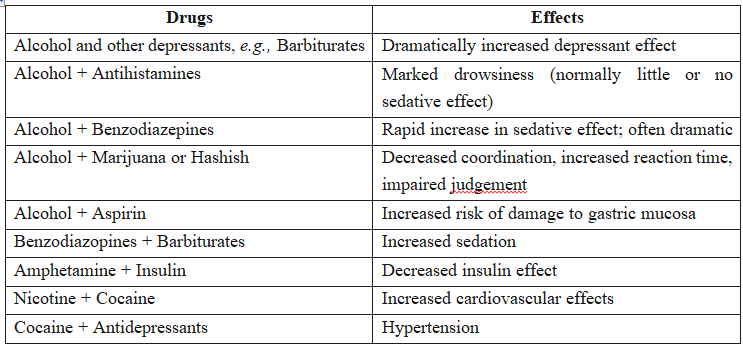
Drugs like barbiturates; amphetamines, benzodiazepines, lysergic acid diethyl amides (LSD), and other similar drugs, that are normally used as medicines to help patients cope with mental illnesses like depression and insomnia, are often abused.
Morphine is a very effective sedative and painkiller, and is very useful in patients who have undergone surgery.
Several plants, fruits and seeds having hallucinogenic properties have been used for hundreds of years in folk-medicine, religious ceremonies and rituals all over the globe.
When these are taken for a purpose other than medicinal use or in amounts/frequency that impairs one's physical, physiological or psychological functions, it constitutes drug abuse.
Drug abuse is found only with those who live a stressful life, unsatisfied with themselves, feel insecure.
As the problems and stress are becoming a part of modern life, these a person must learn to face the problems and stresses.
One must discuss the problems with family members/friends and attempt to sort them out, rather than to resort to drug/alcohol use.
Animal husbandry
- Books Name
- A TEXT OF BIOLOGY - CLASS XII
- Publication
- ACME SMART PUBLICATION
- Course
- CBSE Class 12
- Subject
- Biology
Animal Husbandry
ANIMAL BREEDING
A group of animals related by descent and similar in most characters like general appearance, features, size, configuration etc. are said to belong to a 'breed'. Animal breeding is producing improved breeds of domesticated animals by improving their genotypes through selective mating.
Objectives of Animal Breeding:
The main objectives of animal breeding are: (i) Improved growth rate, (ii) increased production of milk, meat, egg, wool, etc., (iii) superior quality of milk, meat, eggs, wool, etc., (iv) improved resistance to various diseases, (v) increased productive life and (vi) increased or, at least, acceptable reproduction rate, etc.
Methods of Animal Breeding : Two methods of animals breeding are: inbreeding and outbreeding (based mainly on breeding work done with cattle).
1. Inbreeding.
When breeding is between animals of the same breed for 4-6 generations, it is called inbreeding. e.g. between breeds of cows, buffaloes, poultry etc.
Inbreeding may be explained by taking an example of cows and bulls.
Superior cows and superior bulls of the same breed are identified and mated.
The progeny obtained from such mating are evaluated and superior males and females are identified for further mating.
A superior female, in the case of cattle, is the cow that produces more milk per lactation.
On the other hand, a superior male is that bull which gives rise to superior progeny as compared to those of other males.
Inbreeding, as a rule, increases homozygosity.
Thus inbreeding is necessary if we want to develop a pureline in any animal.
Inbreeding exposes harmful recessive genes that are eliminated by selection.
It also helps in accumulation of superior genes and elimination of less desirable genes.
But continued inbreeding reduces fertility and even productivity.
This is called inbreeding depression.
In this condition, the selected animals of the breeding population should be mated with superior animals of the same breed but those which are unrelated to the breeding population.
2. Outbreeding.
Outbreeding is the breeding between the unrelated animals which may be between individuals of the same breed (but not having common ancestors) or between different breeds (cross breeding) or different species (interspecific hybridization).
(i) Outcrossing. It is the mating of animals within the same breed but not having common ancestors on either side of their pedigree up to 4-6 generations. The offspring of such a cross is called an outcross. Outcrossing is the best breeding method for animals that are below average in productivity and milk production, growth rate in beef in cattle etc. Sometimes only one outcross helps to overcome inbreeding depression.
(ii) Cross-breeding. In cross-breeding, superior males of one breed are mated with superior females of another breed. Many new animal breeds have been developed by this strategy. It gives better breeds. Cows of an inferior breed may be mated to bulls of a superior breed to get better progeny. Hisardale is a new breed of sheep developed in Punjab by crossing Bikaneri ewes and Marino rams.
(iii) Interspecific Hybridisation. In this approach, male and female animals of two different species are mated. The progeny obtained from such a mating are usually different from both the parental species. But in some cases, the progeny may combine desirable characters of both the parents. Mule is produced from a cross between female horse (mare) and male donkey. Mules are sturdier than their parents and are well suited for hardwork in mountainous regions.
Concept Builder
Controlled Breeding Experiments :
These are carried out using artificial insemination and Multiple Ovulation Embryo Transfer Technology (MOET).
1. Artificial Insemination (AI) :
The semen of superior male is collected and injected into the reproductive tract of the selected female by the breeder.
The semen can be used immediately or can be frozen for later use.
When a bull inseminates a cow naturally, approximately 5 to 10 billion sperms are deposited in the vagina.
However, when semen is deposited artificially, considerably fewer sperms are required to achieve conception.
Therefore, artificial insemination is very economical.
The spread of certain diseases can be controlled by this method.
2. Multiple Ovulation Embryo Transfer (MOET) :
In this method, hormones (with FSH-like activity) are given to the cow for inducing follicular maturation and super ovulation.
Instead of one egg, which they usually give per cycle, they produce 6-8 eggs.
The cow is either mated with a best bull or artificially inseminated.
The embryos at 8-32 cell stage are recovered and transferred to surrogate mothers.
The genetic mother is available for another super ovulation.
MOET has been done in cattle, sheep, rabbits, buffaloes, mares, etc.
High milk giving breeds of females and high quality (lean meat with less lipid) meat giving bulls have been bred successfully to obtain better breed in a short time.
Animal husbandry is the science of rearing, improvement and caring of domesticated animals.
Although the word "Animal" includes any of the various organisms belonging to the kingdom Animalia but when we use it in animal husbandry, we mean only those domesticated animals which are reared mostly for economic or for recreation purposes, such as cattle, buffalo, sheep, goat, camel, pig, horse, etc.
It also includes poultry farming and fisheries.
Since long time, animals like bees and silkworm have been used by humans.
All above mentioned livestock (animals kept for use or profit) has been used by humans for products like milk, eggs, meat, wool, silk, honey, etc.
The word 'husbandry' means the management of domestic affair.
The term used in connection with animal husbandry includes proper feeding, breeding, health care, housing etc.
Domestication of animals probably began during the 'hunting and gathering' phase of human civilisation.
As humans realised the importance of domesticating animals for use as beasts of burden and as sources of milk, meat, leather and fur, methods of improvement through selective breeding were used.
Curiosuly, Old World Agriculture employed animals.
While there is little evidence of the use of animals in the primitive agriculture of the New World.
Most of the useful animals raised today have evolved from their wild ancestors.
One of the earliest animals to be domesticated was the dog.
Starting from a few basic types, the wild dog, the wolf and the jackal, man has produced an amazing variety of breeds. The Eskimos still use huskies to draw sledges.
Cattle livestock :
Buffalo in India, termed 'water-buffalo' in the western literature, constitutes the most important species of livestock in India.
They serve as the primary source of milk -the only dietary animal protein for a majority of Indians.
The cattle are used to draw water from wells.
Their dung is used as fuel and for the generation of biogas.
India happens to be one of the largest exporters of leather goods made from cattle hide.
Horns, hooves and bones are used to prepare cattle feed and fertilizers.
Indian cattle are hardy and highly resistant to major diseases.
Bulls from India are used for crossbreeding with European and American varieties.
The best Indian cattle breeds are found in the drier parts of the country.
There are 26 breeds of cattle and seven breeds of buffaloes which differ in their body colours, horns and shape of forehead.
The family of domestic cattle is Bovidae.
There are two main groups of bovidae (domestic cattle) i.e.,
(i) Bos Indicus found in India and Africa . They are also called Zebu Cattle or humped cattle.
(ii) Bos taurus are found in Europe and North America and are non humped cattle.
The zebu is characterised by
(i) presence of prominent hump,
(ii) upright horns,
(iii) a long face,
(iv) drooping ears and
(v) large and slender legs. In the U.S. Zebus are called Brahman cattle.
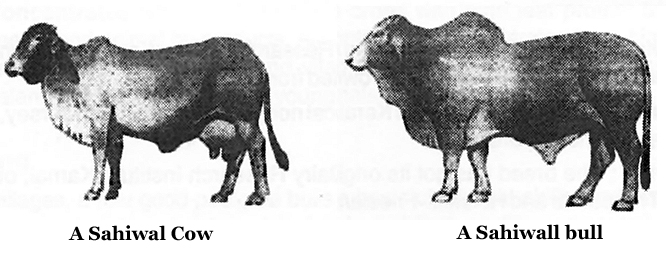
The cattle breeds are classified into three groups.
(i) Milch breeds: The cows of these breeds are good milk producers, however, bullocks are of poor quality.
(ii) Draught breeds : The bullocks of these breeds are good for working but cows are poor milk producers.
(iii) General utility breeds (Dual-purpose breeds) : The cows of these breeds are good milk producers and the bullocks are good draught animals. They are intermediate between milch and draught breeds.
Concept Builder
Table : Some breeds of Indian Cattle and Buffaloes
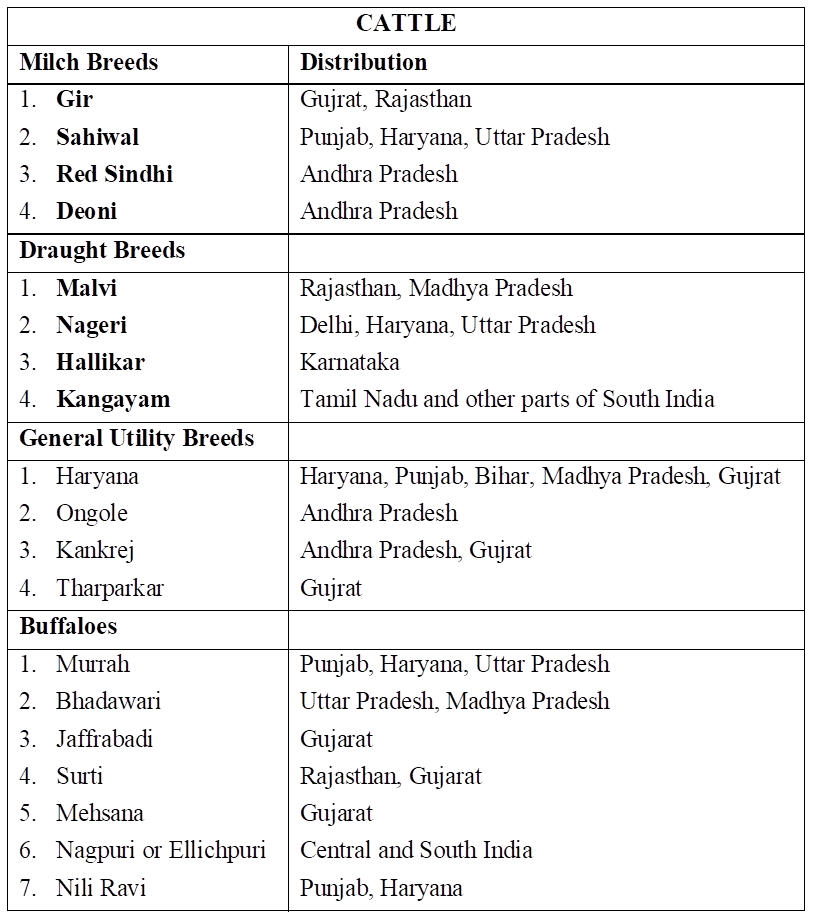
 Cross Breeds
Cross Breeds
1. Karan Swiss: This breed has been evolved at the National Dairy Research Institute, Karnal in Haryana, by breeding the Sahiwal cows with the semen of Brown Swiss bulls imported from U.S.A.
2. Sunandini: This breed originated in Kerala by crossing the local non-descript cattle with Jersey, Brown Swiss and Holestein-Friesian breeds.
3. Karan Fries: The breed has got its origin at the National Dairy Research Institute Karnal, out of crossing between Tharparkar and Holstein-Friesian.
Some exotic (foreign) breeds of cattle (Bos taurus) that are used for cross-breeding purpose in India.

Compared to cows, buffaloes (Bubalus bubalus) generally yield more milk of high fat content.
They also have greater disease resistance and longevity.
The milk yielding capacity of buffaloes is three times more than cows. Buffalo milk is superior to cow's milk in fat content as well as minerals.
CATTLE MANAGEMENT AND FEEDING
1. India has about 227 million cattle and buffaloes. In terms of sheer numbers, India ranks fifth in the world. However, in milk production, India figures very poorly. Cattle management practices vary in different parts of the country depending upon climatic conditions. India is lowest in milk yield per cow.
Feeding: Ninety percent livestock subsists on grazing in public and government-owned lands and forests.
2. The prepared feed given to them is classified into :
(i) Roughages which include fodder, silage, hag and straw. This feed has a high fibre content.
(ii) Concentrates which include cereals, millets, forage crops with high leaf protein and oil cake, oil seeds, and animal by-products. Although low in fibre content, the concentrates have high nutrient value and digestibility. Minerals and vitamins are added to the feed of high yielders. The proportion of balanced feed differs for the young and the adult animals.
Cattle-Breeding
1. In the villages, a few good pedigree bulls are selected on the basis of draught ability and permitted to graze with the cows to bring about random breeding. Bulls not selected for breeding are castrated when young and converted to bullocks. They are the main source of animal draught power in India.
2. Mature cattle having more than 3 years of age should be used for breeding. The best local cows with a good milk yield should be mated with a pure breed exotic bull which should have high genetic potential. One bull is usually enough for 60 to 70 cows.
3. About 10 to 60 per cent cows are artificially inseminated by semen collected from high quality bulls. Artificial insemination ensures good quality progeny and is also economical as semen from a single bull can inseminate several thousand cows. Average gestation period of the cow is 280 days. The length of gestation of buffaloes varies, influenced by breed and environment, between 276 and 340 days, but on an average, it lasts for 310 days or 10 months, in contrast to the cow with an average gestation of 280 days or 9 months.
4. An average cow or buffalo produces 8-10 calves during its productive life time : Generally only one ovum is fertilized at a time. Selective breeding, progeny testing and improvement take longer time in the livestock than in annual food crops. With the exception of certain Indian breeds which have been maintained for good yield, the majority of Indian cattle have been on marginal inputs and are infertile and poor milk yielders. Research on the cause of infertility led to the use of pregnant mare serum gonadotropin to augment fertility in sterile cows and to induce lactation immature females by implantation of stilbesterol tablets.
5. Artificial Insemination (AI). It involves the insemination of the semen of superior bulls of exotic or indigenous breeds into the native cows. The semen should be deposited either deep in the cervix or at beginning of the body of the uterus. When insemination is performed deep in the cervix, spermatozoa are likely to live longer in the cervix than in the uterus. Deposition of semen in the vagina results in dilution, contamination and lowered conception rate. When a bull inseminates a cow naturally, approximately 5 to 10 billion spermatozoa are deposited in the vagina. However, when semen is deposited artificially into the cervix considerably fewer sperms are required to achieve conception. Therefore, artificial insemination is very economical. Semen collected from a single superior bull can be used for fertilizing many cows. Semen from desired bull located at distant places can be used. The spread of certain diseases can be controlled by this method. Artificial insemination was first introduced in India at Indian Veterinary Research Institute, Izzatnagar, Bareilly, Uttar Pradesh.
6. To increase the milk yield, Indian cows are cross-bred with European breeds like Holstein, Brown Swiss, Jersey, Red Dane and others. The Karanswiss and Sunandini are the breeds developed through cross-breeding at the National Dairy Research Institute, Karnal , and in Kerala, respectively.
7. Super Ovulation and Embryo Transplantation: It is also called as MOET (Multiple ovulation and embryo transfer) A pedigreed bull and a high production cow are chosen to produce super milch cows. Superovulation is induced by hormone injection. After artifical insemination, 4 to 10 embryos are collected at a time. Each embryo is then transplanted into a 'carrier' cow (surrogate mother). Such embryo transplants can also be carried out in sheep, goats, and other livestock. By deep freezing (-196QC), it is possible to preserve seven days old foetuses for several years to be used when needed. An embryo can be cut into two, to obtain homozygotic twins. The most beneficial outcome of embryo transplantation is the selection of high quality bulls for genetic upgrading. India has launched research using the above-mentioned techniques.
Use of Buffaloes
Milk: Buffaloes provide milk with all the essential nutrients. It has bigger size fat globules. The milk is rich in calcium and phosphorus and low in sodium and potassium. Buffalo milk is almost free from carotenoids (golden yellow in colour) due to conversion of all carotenoid materials into vitamin A (colourless by the liver cells). That is why buffalo milk and ghee is white whereas ghee made from cow milk is golden yellow in colour because of incomplete conversion of carotenoids into vitamin A inside liver cells which appears in cow milk.
Cattle Diseases
Most Zebu cattle (domesticated cattle, Bos indicus) are resistant to diseases like Rinderpest or cattle plague, foot and mouth and other bacterial and viral diseases.
Rinderpest has been controlled through a National Programme.
Vaccination is given to highly productive herds.
Domesticated animals suffer from a variety of diseases.
In animals, disease may be defined as a state of discomfort associated with an abnormal function of the animals body.
Diseases may be caused by mutant genes (genetic diseases), improper nutrition or pathogens.
Genetic diseases are strictly selected against during animal breeding.
Generally, animals are raised on properly balanced diets to avoid nutritional disorders and to ensure optimum performance.
Domesticated animals suffer from diseases caused by (a) viruses, (b) bacteria, (c) protozoa, (d) fungi, and (e) animals, like worms.
Such diseases are commonly known as infectious diseases because they are caused by pathogenic infections.
Many of the infectious diseases are known as contagious diseases since they spread to healthy animals by contact with diseased animals, or with materials that were in direct contact with the diseased animals.
Some of the infectious diseases may spread to humans from the animals, e.g. anthrax.
Infections can occur through skin, digestive tract, respiratory tract, conjunctiva, urogenital tract, placenta, umbilicus, udder, teats and egg.
It is a good policy to implement measures for the prevention of infectious diseases, some of which are as follows.
(i) Isolation of animals suffering from or suspected to be infected with an infectious disease
(ii) Proper disposal of the carcass and all materials that were in contact with the diseased animals(s).
(iii) Proper cleaning and disinfection of the animal house and other materials that were in contact with diseased animal(s).
(iv) Transfer of healthy animals to a pasture other than that used by diseased animal(s).
(v) Vaccination of animals.
(vi) Injection of antiserum into healthy animals whenever an epidemic is expected.
(vii) The authorities of the veterinary department should be immediately informed of cases of infectious diseases. This will allow them to initiate measures to prevent the spread of these diseases.
Bacterial Diseases
Animals suffer from several bacterial diseases. For example, cattle suffer from anthrax, mastitis, pneumonia, etc.
1. Anthrax:
Anthrax is caused bythe bacterium, Bacillus anthracis.
This disease is contagious and affects cattle, buffaloes, horse, sheep and goats; it can also spread to human beings.
In animals, anthrax spreads through contaminated food, water and pastures.
Symptoms and diagnosis:
In very acute cases, there is increased respiration, and blood-mixed foamy discharge from mouth, nose and anus.
In such cases, the infected animals may die within minutes.
But in subacute and chronic cases, the infected animals have high fever (up to 41.1ºC), and increased pulse and respiration rates.
There is discharge of black, shiny and foamy material from natural openings of animals.
The infected animals die within 2 to 3 days.
The anthrax bacterium uses up the oxygen carried by the animal blood.
As a result, the animals die due to a lack of oxygen.
Disease diagnosis can be confirmed by microscopic observation of the the bacterium in the blood of patients, or by culturing the bacterium present in the blood on a suitable medium.
Treatment:
In the case of human beings, a suitable antibiotic like ciprofloxacin is quite effective, particularly if used in the initial stages of the disease.
But in cattle, ciprofloxacin may be effective only in chronic cases.
Anthrax antiserum can also be used with good results.
In any case, antiserum should be given to all healthy animals to protect them from the disease.
Prevention and control:
The general measures for prevention of infectious diseases should be followed.
The healthy animals should be vaccinated.
Animals that have come in contact with diseased animals should be given anthrax antiserum to protect them from the disease.
2. Mastitis: It is the inflammation of udder that often occurs in dry cows due to infection of bacterium "cornybacterium pyogenes".
Viral Diseases
Animals suffer from a variety of viral diseases. For example, cattle suffer from rinderpest, foot and mouth disease, cowpox, etc. In this section, rinderpest is discussed in detail.
1. Rinderpest: This disease is caused by a virus and is highly contagious. The virus is present in all the fluids and secretions of the body of diseased animal. The disease spreads rapidly by direct contact with patient animals, through contaminated food, water, workers and their clothes and by flies.
Symptoms: Initially, the infected animal develops fever (40.0º to 42.2°C), loses appetite, develops constipation, and passes hard faeces that often are covered with blood. In the final stages of the disease, animal suffers from loose motions which gives off offensive odour. The body temperature declines and may go down below normal. The animal usually dies in about 7 days.
Treatment: Treatment is effective only when it is started in the initial stages of the disease. Injection of sulphamethazine sodium is often effective. Injection of rinderpest antiserum is highly effective, especially when combined with injection of sulphamethazine sodium.
Prevention: All the measures for prevention of infectious diseases should be implemented. It is highly desirable to vaccinate the animals against rinderpest. In 1954, a massive vaccination programme was initiated in India. This project has been highly successful, and rinderpest is no longer a dreaded disease.
Cattle of higher altitudes: Mithun is found in north-eastern India at an altitude of 700 to 1700 m. It is used for meat. Yak is found in Tibet, Ladakh, Lahaul, Spiti, Garhwal and Sikkim. Yak gives meat, hide and wool. It is also used for tilling land. The transport of people and goods across the desolate trans Himalayan region would be impossible without the yak.
2. Foot and mouth disease: If affects cattle, sheep, goats, pigs and other ruminants, caused by ssRNA Aphthovirus. It is characterised by eruption of vesicles over the lips, inside buccal cavity, over legs, feet, udder and even teats.
There is loss of appetite but dribbling of saliva is present. Lameness occurs.
The infected animals should be separated immediately and the animal house thoroughly disinfected.
3. Cow pox : It is mild self limiting eruptive skin disease of cows caused by cow pox virus. The infection is confined to udder and teats.
It spreads to humans accidently while milking infected animals.
Inoculum from cow pox lesions was used by Edward Jenner in 1798 as vaccine against small pox.
POULTRY
Poultry-farming deals with the rearing of fowls (chicken), ducks, turkeys, and pheasants for their eggs and meat. India and the neighbouring countries are recognised as the original home of the red jungle fowl (Gallus gallus). There is evidence that Aseel or Malay fowl were carried to Europe through the Middle East about 2,000 years ago and have given rise to the present-day European breeds.
1. Poultry and poultry products are a rich source of animal protein and other nutrients such as fats, vitamins and minerals. Consumption of eggs would pave the way for overcoming protein malnutrition prevalent especially among children in India.
2. Poultry-farming has definite advantages over livestock-rearing. Poultry birds are easy to raise, can be acclimatised to a wide range of climatic conditions, have short life span and are prolific breeders. Hens have an average yield of 60 eggs per year (upto 240 eggs in high-yielding varieties). Poultry-farming requires less space, is easier to manage and maintain and brings fast returns within a span of six months.
3. In a poultry farm, comfortable, well-ventilated and illuminated dry houses are built. Birds of different ages are kept in separate houses. In regions with moderate climate, they are kept in cages (coops). The floor is littered with chopped straw, paddy husk, dry leaves or ground nut hulls. It is made rat proof and provided with water channels with proper drainage. Minerals which are important for poultry diets are calcium, phosphorous, sodium, copper, iodine, iron, manganese and zinc. Vitamins required are vitamin A, 0 3' E, pyridoxine, riboflavin, pantothenic acid, niacin, folic acid, B12 and choline. The male breeder's diet should contain extra calcium, manganese and vitamin E to ensure proper fertility. Thus, a balanced diet is the requirement so that the utilization for building of tissues and egg production is maximised. Clean and fresh water is very essential for birds.
Light management: Light is essential for high egg production. 14 to 16 hours of light including daylight is required for optimum production. When the pullets (young hens especially at the time they begin to lay eggs) come into production, start giving additional light if the daylight is less than 12 hours. Gradually increase the light 20 minutes every week till 16 hours of total light is there. One tube light of 40 watt is sufficient for 36 sq.m area while 40 watt bulb is sufficient for 18 sq.m floor area. Light should spread uniformly. The light should not be provided for whole night.
4. Fowls are widely distributed as domestic animals and the most common species of jungle fowls are Gallus gallus, G. lafayetti and G. sonneratti.
5. Poultry feed includes all the nutrients and is made of cereals and millets, oil cake, protein concentrates, fish and meat meal, minerals and green vegetables.
6. The domestic fowl (Gallus domesticus) population of our country can be roughly classified into two types:
(i) Indigenous (desi type), (ii) Exotic (improved type)
Some of the indigenous breeds like Aseel , Karaknath, Ghagus, Brahma, Busra are the best table birds. The Aseel fowls are used in cock-fighting. The exotic breeds are classified, according to their source of origin, into American class, English class, Mediterranean class and Asiatic class. Some examples are White Leghorn, Rhode Island Red, Plymouth Rock and New Hampshire. They are now completely acclimatised to Indian conditions. Some of them are excellent egg-layers, whereas others give good meat.
Table : Breeds of Chickens

The indigenous breeds are crossed with exotic breeds for improving egg production. Heterosis has been utilised for producing better egg layers and broilers (birds grown for meat) with high nutritive value.
Some of the diseases like fowl pox, ranikhet, coryza, fowl cholera and aspergillosis take a heavy toll on poultry. But with better management, proper housing and nutrition and timely vaccination of the chicks, these diseases can be controlled.
7. Ducks comprise 6 per cent of the total poultry population in India. They are abundant in the southern and eastern parts of India. There are 20 breeds of duck of which Muscori, Pekin, Aylesbury and Campbell are popular exotic breeds; indigenous breeds include Indian Runner, Syhelt meta, etc. Brown and white geese are common in India. Turkeys which are in demand during Christmas time, belong to the breeds Narfold, British White, Broad Breasted Bronze and Beltsville Small White.
8. Poultry Diseases
(i) Encephalomalacia: Deficiency of vitamin E causes softening of brain tissue in young poultry.
(ii) Coccidiosis: The protozoan Eimeria causes coccidiosis in fowls. It causes bloody diarrhoea.
(iii) Bacterial Diseases

Concept Builder
Viral Diseases: Ranikhet, Fowl pox, Infectious bronchitis, Lymphoid leukosis.
Fungal Dieases: Thrush, Aflatoxicosis, Brooder pneumonia.
Ranikhet Disease is respiratory disease caused by Paramyxovirus characterised by coughing, sneezing and marked signs of respiratory diseases. Also known as 'New Castle disease'.
Marck's disease is primarilya disease of the young growing fowls caused by DNA virus. Paralysis is one of the major clinical symptoms.'
Bird Flu resembles influenza and is caused by a virus HN1. The virus enters the man through chicken.
Coccidiosis caused by a group of protozoans called coccidia (e.g. Eimeria, Isopora) which affect the different parts of intestine.
Tick fever is transmitted through the fowl tick (Argus persicus). Usually tick bites the birds at night and parasite is transmitted into blood. High temperature, dullness, depression, greenish diarrhoea are its symptoms.
Perosis is due to deficiency of manganese in poultry birds. There is enlargement of tibiometatarsal joint twisting and bending of end of tibia.
Infectious Coryza is caused by Haemophilus gallinarum and infected birds show discharge from the nostrils and eyes.
Pullorum disease is caused by Salmonella pullorum. The heart, spleen, liver, kidney, lung and digestive tract are affected.
Aspergillosis is mainly disease of young chick and is caused by a fungus Aspergillus fumigatus. Normally the lungs are the major area of internal infection.
Mycosis is caused by a yeast called Candida albicans. It affects mostly upper portion of the digestive tract (mainly crop, proventriculus and gizzard).
APICULTURE
It is the care and management of honey bees. Honey bees give us honey and wax. They are good pollinators.
1. Common breeds of honey bee are
Apis dorsata (Rock bee)
Apis indica (Indian bee)
Apis florea (Little bee)
Apis mellifera (Italian bee)
2. Honey produced by the honey bee Apis species is probably the oldest sweetening agent in our civilisation. Honey contains two sugars -dextrose and levulose -and a mixture of several other substances. It is tasty, health-giving and also medicinally useful. Honey bees also yield wax, which has multiple uses. A large quantity of honey is still collected from wild sources. However, bee-keeping (apiculture) using domesticated bees has been practised in many parts of the world, including India (using A. dorsata, A. florea and A. indica).
3. Social organization (Castes) of honey bee: The nest of honey bee is known as the bee-hive. The hive consists of 32 to 60 thousand individuals, showing a highly organized division of labour in the colony. Bees are polymorphic, consisting of three types of individuals (Castes) viz, QUEEN, DRONE and WORKER. The characters are given in the following table.
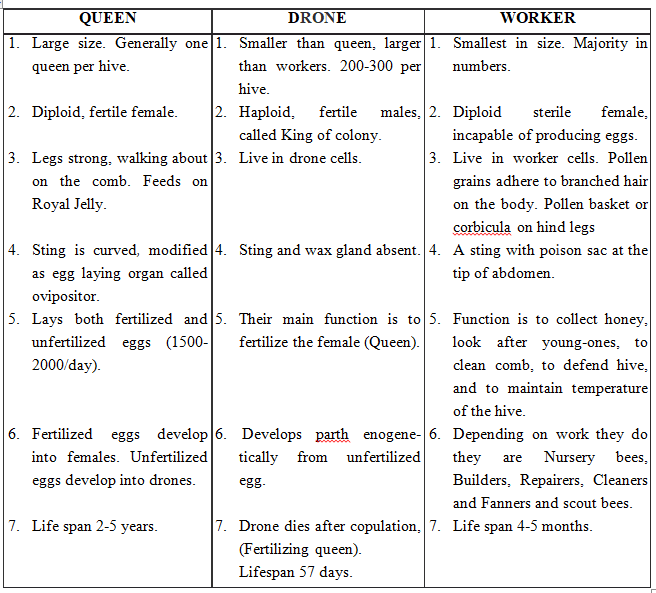

4. From its mandibular gland, the developing queen secretes antiqueen substances or antiqueen pheromones which inhibit the worker bees from building brood chambers and developing ovaries.
5. Drones are male honey bees. They develop from unfertilized eggs. The phenomenon is called arrhenotoky. Drones and virgin queens take part in nuptial flight. After copulation, the drones are not allowed to come back into hive.
6. The queen stores the sperm in her spermatheca. They are sufficient to fertilize all the eggs that are laid by her.
7. Females develop from fertilized eggs. Workers are sterile females. Scout bees search for food and intimate the same, to worker bees by dances -round dance for less than 75 m and tail wagging dance for longer distances (Frisch) of the new food source from the hire.
8. Workers have a pollen collecting apparatus in hind legs called corbicula and nectar storing mechanism in crop and wax secreting glands in abdomen.
9. Young workers secrete royal jelly and are called nurse bees. Royal jelly is given to queen or potential queens. Apiculture is the rearing of bees or bee keeping for collecting of honey and wax.
10. Honey is near neutral sugary syrup with 6.8 pH, having 17-25% water, 3.3% minerals, abundant vitamins (B1, B6, C, D), L-fructose (Laevulose, 41%), glucose (35%), sucrose (1.9%) and dextrin (1.5%). It is tonic, laxative and sweetening agent. Bee wax is secreted by abdominal wax glands of the worker bees. It possesses a hardening substance from cephalic gland and a resin called propolis from pollen grains.
Concept Builder
Importance of Honey bees: Honey bees have the following importance.
1. Honey: The honey is a natural valuable tonic for human body. It contains various substances of high medicinal value, including important enzymes, vitamins and sugars, mainly glucose and fructose. It prevents infection if applied to a wound. A number of ayurvedic medicines are taken with honey.
2. Bee wax : Bee wax is made of secretion of worker bees' abdominal glands. It is a product of industrial importance. It is used in the manufacture of many items including cosmetics, shaving cream, face cream, ointments, plasters, carbon papers, pencils, electric goods, toothpaste, lotions, furniture-polishes, boot-polishes, protective coating, ink paints and candles. It is also used in model and mould making and in printing industry. It is also used in the laboratory for microtomy with the common wax for block preparation of the tissues.
3. Pollination: The honey bees are pollinators of many crop species such a sunflower, Brassica, apple and pear.
4. Medicinal value: A drug, prepared from the bodies of honey bees, is used in the treatment of Diphtheria and some other dangerous diseases. The venom of honey bees has been used in the treatment of arthritis and snake bite.
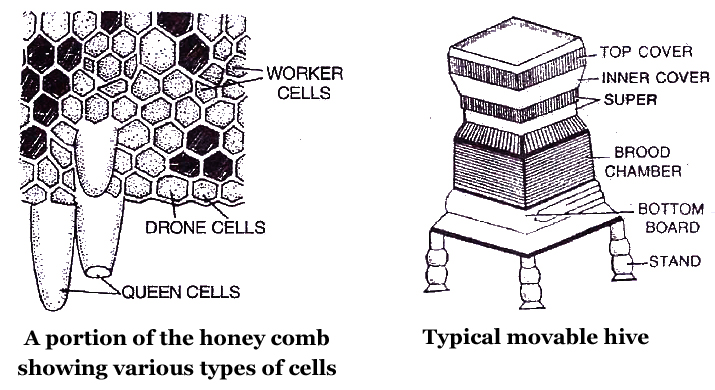
The detailed studies on the habits and behaviour of the honey bee led to the development of apiculture not only as a useful hobby but a large scale profitable trade to produce honey and wax in large quantities.
The honey-bees are reared in wooden boxes having a large brood chamber placed on a wooden platform with an opening for the entry and the exit to the bees at the bottom.
A number of frames coated with wax sheets having hexagonal imprints are placed in the chamber vertically with the help of wires.
The bees start making cells along the margins of hexagonal imprints.
Each wax sheet, known as comb foundation, provides the foundation arc for the bees to build combs on both the sides.
Another frame fitted with wire meshing for the easy passage of the workers is placed over the vertically placed frames.
A chamber called super having additional similar frames for more comb foundations meant for the expansion of the hive, is placed over the brood chamber.
The wire meshing referred to above, extends between the brood chamber and super.
In order to provide ventilation, light and protection, a cover having holes is placed over the super.
To start a colony in the artificial hive, a gravid (fertilized) queen is inducted into the brood chamber.
Artificial hives are placed in gardens, orchards and fields having flowering plants to provide the pollen and nectar.
When sufficient honey has been stored, the combs are removed from the frames and then centrifuged to extract the honey.
The same comb can be used again.
The appliance used for the extraction of honey are a pair of gloves, a knife, a brush to remove the bees from taken out combs and a centrifuge.
Bee Enemies: These include the wax moths (e.g., Galleria mellonella), wasp (e.g., Vespa) , black ants (e.g., Componotus compressue) and bee eaters (e.g., Merops orientalis and king crow, Dicrurus macrocerus). Man is the last but worst enemy of honey bees.
Bee Diseases : Honey bees suffer from Nosema disease caused by a sporozoan Nosema apis, paralysis dysentery and acarine disease caused by a parasitic mite, Acarapis woodi.
FISHERY
A large section of the Indian population uses fish as food. Fish is an easily available source of protein. It is highly nutritious and easily digestible. In India, edible fishes are abundantly available from sea, rivers, lakes, ponds and marshes. Fish is also an item of export trade.
Concept Builder
"Aquaculture" involves production of useful aquatic plants and animals such as fishes, prawns, shrimps, lobsters, crabs, molluscs (edible and pearl oysters) by the proper utilisation of small and large bodies of water. "Pisciculture" is the production of fishes.
Fishes are reared in small rivers, lakes and canals.
Fish eggs are introduced into nurseries (hatcheries).
The young ones hatched from the eggs are fed, tended and nursed and harvested when full grown.
Aquaculture techniques of induced breeding by the administration of pituitary hormones have helped in the production of seed fish in pure form.
Hatcheries with Circulating water have ensured almost 100 percent hatching of fertilised eggs.
Culturing fish in fresh water is known as 'Inland fisheries'.
Fish industry also includes trapping and capturing fishes from estuaries, sea coast and even from within the sea by using sophisticated electronic locaters, baits, nets and trawlers.
A large number of fishermen living in the coastal regions of India still use catamarans and various traditionally built boats.
Mechanised fishing boats have now made deep-sea fishing possible.
Catching, processing and packaging of marine fishes have been developed on a scientific footing in our country.
India exports marine food to several countries.
Besides serving as table food, fishes are of medicinal value.
Shark liver oil and cod liver oil are natural sources of vitamins A, C and D.
Oil from sardines, herrings and salmon is used in the manufacture of soaps and paints.
Concept Builder
Fish meal is a rich source of protein for cattle and poultry. It is prepared from the nonedible parts of fishes such as tails, fins and bones which are discarded from factories that extract oil from fishes. Fish waste is also used for making fertilisers and adhesives. Shark leather (shark skin) called shagreen is used to make articles such as hand bags, shoes and tobacco pouches and is considered fashionable and fetches a high price in the market.
Pisciculture is rearing, catching and management of fishes.
Culture fishery is the raising of fishes in tanks and ponds while capture fishery is management of catching of fish without actually raising them.
India has 1.6 million hectares of inland water (annual yield 2.242 million tonnes, 1996 data) and over 2.59 km2 of continental shelf for fishing (annual yield 2.7 million tonnes, 1996 data).
Table : Important Edible Fishes of India
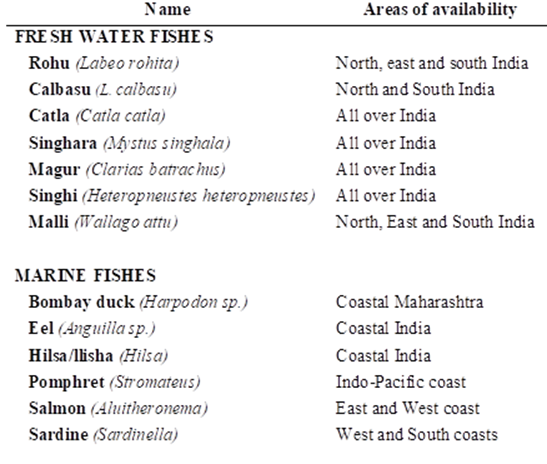
Culture Fishery: In this method, pituitary hormone extract is injected into male and female breeder fish.
Two males and one female are then kept in a breeding happa, a bamboo and cloth container.
Spawning takes place in 3-6 hours.
The fertilized eggs are removed and kept in hatchery, where they hatch in 15-18 hours.
The hatchlings are kept in glass-jar hatcheries.
A mouth is formed on the third day and the young fish are now called fry.
They are kept in rearing ponds for about three months, where they grow into 4"-6" long fingerlings.
The fingerlings are then released into stocking ponds where they grow to the required size.
In composite fish culture, different species of fish like catla, rohu and mrigal are cultured together.
Types of Ponds: Three types of ponds are required for the culture of Indian major carps: nursery, rearing and stocking ponds.
(i) Nursery Ponds: Efficient pond fish culture requires special preparation of nurseries to receive the tender hatchlings at spawn. Small and seasonal nurseries are preferred as they facilitate effective control of the environmental conditions. The steps adopted towards preparation of nurseries are control of predatory fishes and weeds, There should be production of zooplankton to serve as food for spawn and control of algal blooms.
(ii) Rearing Ponds: The fries (sing. fry = young one of fish) are collected from the nursery ponds and released in rearing ponds where fries develop into fingerlings.
(iii) Stocking Ponds: The fingerlings are netted out from the rearing ponds to stocking ponds where they change to fish. In the stocking ponds, the fishes are kept for stocking.
Marine fisheries: The marine fishery is divided into coastal fisheries (about 3 miles from the coast line), and deep sea fisheries, which have different fauna of fish. In India, about 75% of the marine fish catch is from the western coast.
The main marine fisheries are Sardines (26%), Mackerel (9.7%) and the Bombay duck (11%).
Crustacean fisheries i.e. Prawns, Lobsters, Crabs, Penaeus sp. are dominant on the west coast. Mollusc fisheries include oysters, clams, mussels, squids, cuttlefish and octopus.
Estuarine fisheries : The place where the fresh water of rivers meets the salt water of the sea is called an estuary. It contains brackish water.
At estuary only those fishes of fresh water and sea can survive that can tolerate a change of salinity.
The estuary also forms the nursery ground for several marine and fresh water species.
Fishing on large scale from such places, results in the death of number of young and immature fishes.
Bag nets are most commonly used in estuarine fishery.
The major estuarine systems in India are (1) Hooghly -in West Bengal. (2) Mahanadi estuary in Orissa. (3) Cauvery estuary in Tamil Nadu. (4) Narmada and Tapti estuary in Gujarat and (5) Godavari-Krishna estuary in Andhra Pradesh.
Carp fishes such as catla (theila), Labeo rohita (rohu), Cirrhinus mrigala (mrigal) and Labeo calbasu (kalbasu) are commonly cultured together in our country.
Such a practice of culturing together of fishes is called polyculture or composite culture.
Important edible fishes are :
A. Fresh water fishes: Rohu (Labeo rohita), Calbasu (Labeo calbasu), Catla (Catla catla), Singhara (Mystus singhala), Magur (Clarias batrachus), Singhi (Heteropneustes)
B. Marine fishes : Bombay duck (Harpodon sp.), Hilsa (Hilsa sp.), Eel (Anguilla sp.), Pomphret (Stromatetis sp.), Salmon (Aluitheronema sp.), Sardine (Sardinella sp.)
Plant breeding
- Books Name
- A TEXT OF BIOLOGY - CLASS XII
- Publication
- ACME SMART PUBLICATION
- Course
- CBSE Class 12
- Subject
- Biology
MAIN STEPS IN PLANT BREEDING
The main steps in breeding a new genetic variety of a crop are the following:
Collection of Variability :
Genetic variability is the root of any breeding programme.
In many crops preexisting genetic variability is available from wild relatives of the crop.
Germplasm is collected from within country (IC – Indigenous collection) and also from other countries (EC – Exotic collection).
The germplasm collections are usually maintained at low temperature in form of propagules.
The stored propagules are periodically grown in the field to obtain fresh propagules.
In fruit trees, the germplasm is maintained as trees grown in the field.
Collection and preservation of all the different wild varieties, species and relatives of the cultivated species is a pre-requisite for effective exploitation of natural genes available in the population.
Germplasm is the sum total of all the alleles for all the genes present in a crop and its related species.
The entire collection (of plants/seeds) having all the diverse alleles for all genes in a given crop is called germplasm collection. A good germplasm collection is essential for a successful breeding programme.
Therefore, germplasm collection is the most practical and effective answer to problem like loss of germplasm due to expansion of agriculture, industries and other human activities.
Evaluation and Selection of Parents :
The germplasm is evaluated to identify plants with desirable combination of characters.
Selection of parents is done by picking up seeds of only those plants for multiplication which have the desired traits.
Selected plants are multiplied and used in the process of hybridisation. Pure lines are created wherever desirable and possible.
Common Methods of Crop Improvement
(a) Selection :
Selection is the oldest method of crop improvement.
Almost all our present day crops are the result of selections carried out by prehistoric human beings.
During selection, the individual plants or groups of plants having desired characters are picked up from population, eliminating the undesirable ones.
The selected parents are allowed to reproduce for setting their seeds. The seeds are collected and again a new crop is developed. Selection is again done in this new crop.
It is of three types:
(i) Mass selection :
Simplest and oldest method mainly for cross pollinated crops and is based on phenotypic characters.
It is most common method of crop improvement.
In this, large number of plants of a species with similar phenotypic characters are selected and their seeds are mixed together at time of harvesting.
These seeds are sown in field for progeny testing. Progeny selection is done by eliminating the undesirable one and saving the best.
(ii) Pure line / Inbreed selection :
Involves isolation of desirable homozygous individuals and is done for self pollinating crops.
A pure line is the progeny of a single homozygous self pollinated plant. In this method, a plant with desired characters is selected from a genetically mixed population.
The single selected plant is self pollinated during subsequent generations to pick out a true breeding species with desired characters.
Once homozygosity is confirmed, the individual is multiplied on a large scale and recommended to farmers. e.g., Wheat varieties like : PV - 18; HUW - 468, Kalyan Sona
(iii) Clonal selection :
It is used for vegetatively reproducing crops. Progeny of a single vegetatively propagated plant is called clone. Here selection is made between clones and not within clone e.g., Kufri safed potato.
(b) Hybridisation :
Hybridisation is the process of making a cross between two genetically diverse parents to obtain a progeny with desired superior traits.
The desired characters very often combines from different parents. For example high protein quality of one parent may need to be combined with disease resistance from another parent.
When a hybridisation is performed between two plants it is called single cross and when it is performed between more than two plants, it is called multiple cross e.g., development of C-306 wheat variety and IR-36 rice variety.
It is not necessary that the hybrids do combine the desirable characters, only one in few hundred to a thousand crosses shows the desirable combination. The primary aim of hybridization is to produce variations.
First natural hybridisation was reported in corn (Maize). First artificial hybrid was obtained by crossing sweet william and carnation by Thomas Fair child and is known as fairchild mule.
Hybridisation was first practically utilised in crop improvement by Kolreuter.
(c) Mutation Breeding :
Mutation is sudden, stable and inheritable change which alter the gene expression of organism. This results in a new character not found among parents.
The mutations, which are artificially induced by treatment with certain physical or chemical agent are called induced mutations.
The application of induced mutations for crop improvement is called mutation breeding.
The agents which are used to induce mutations are called mutagens.
Various chemicals such as HNO2 base analogues, alkylating agents, acridine dyes, and physical agents such as X-rays, UV-rays and gamma rays are used to induce mutations which produce desirable qualities.
It has been used commonly in self pollinating crops.
A number of new varieties have been developed e.g.,
(i) Sharbati Sonora and Pusa Lerma varieties of wheat (formed basis of green revolution in India).
(ii) Reimei, Atomita-2 and Jagannath varieties of rice.
(iii) Erectiferum and Erectoids varieties of barley.
(iv) Aruna variety of castor.
(v) Thick shell in ground nut (TGI)
(vi) Wheat - NP 836
(vii) Cotton - lndore-2
(viii) In mung bean, resistance to yellow mosaic virus and powdery mildew.
(ix) Peppermint (Mentha piperita) - Todd's Mitcham variety, (high oil content and disease resistant).
(d) Polyploid Breeding :
Organisms having more than two sets of chromosomes are called polyploid.
Induced polyploidy is used by plant breeders for improving yield of forage and other crops.
Many of modern day crops such as wheat, rice, sugarcane, potato and cotton are natural polyploids.
The allopolyploids have been used for obtaining fertile hybrids between different species and genera.
Allopolyploidy immediately forms new species.
Odd-numbered polyploids (3x, 5x etc.) are usually sterile, while even-numbered polyploids are fertile.
Allopolyploids are produced in two steps, as follows - First of all, two different species are hybridised to produce F1. The F1 is usually sterile.
Therefore, in the second step, the chromosome number of the F1 is doubled.
The resulting allopolyploid is usually, at least, partially fertile and forms a new species.
Many alloployploids have been produced in nature, some of which have succeeded as crops e.g., wheat.
Humans have produced a new alloployploid crop called Triticale in the following manner.
Allotetraploid wheat (Triticum turgidum) was hybridised with rye (Secale cereale; a diploid grass).
The chromosome number of the resulting F1 was doubled to produce Triticale. Triticale is cultivated in some areas of Punjab and in the hilly regions of the country.
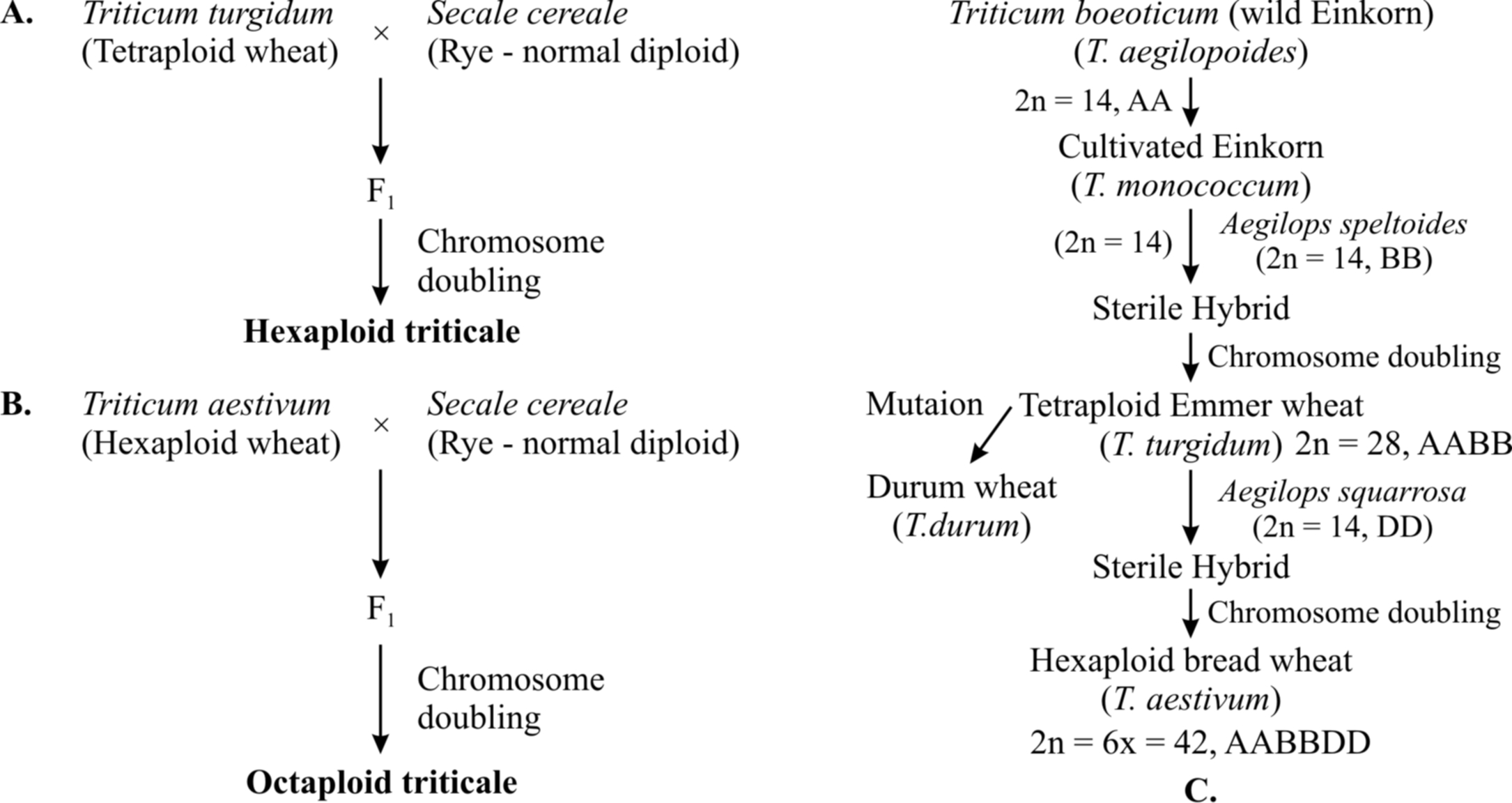
Selection and Testing of Superior Recombinations :
This step comprises of selecting, among the progeny of the hybrids, i.e. those plants that have the desired character combination.
This is the crucial step for the success of breeding experiment, so require careful scientific evaluation of progeny.
The selection process yields plants that are superior to both of the parents.
These plants are self-pollinated for several generations till they come to a state of uniformity (hornozygosity) so that the characters will not separate in the progeny.
Testing, Release and Commercialization of New Cultivars :
The newly selected lines are evaluated for their yield and other agronomic traits of quality, disease resistance, etc.
This evaluation is done by growing these in the research field and recording their performance under ideal fertilizer, irrigation etc.
The testing of the materials is done in the farmer's fields, for at least three growing seasons at different locations in the country, representing all the agroclimatic zones.
The material is evaluated in comparison to the best available local crop cultivar - a check or reference cultivar.
Finally the seeds of desirable plants are certified by National Seed Corporation (NSC) for marketing.
GREEN REVOLUTION
India is an agricultural country. Agriculture contributes about 33% of India's GDP and gives employment of about 62% of the population.
The development of several high yielding varieties of wheat and rice in mid 1960's increased the yield per unit area. This phase is often referred to as the Green Revolution.
From 1960 to 2000 wheat production increased from 11 million tonnes to 75 million tonnes while rice production increased from 35 million tonnes to 89.5 million tonnes.
This was due to the development of semi-dwarf varieties of wheat and rice.
Dwarf Wheat
A dwarfing gene Norin-10 was reported in Japan.
American plant breeders produced single dwarf wheat. N. Borlaug developed triple dwarf wheats in Mexico, popularly known as Mexican Wheats.
These had high yield, resistance for lodging, common pathogens and pests, photoinsensitive, fertilizer responsive and have smaller growth period.
Sonora-64 and Lerma Rojo-64 were brought to India and modified through gamma mutations so that these can become part of Indian Agriculture.
In 1963, many varieties like Sonalika and Kalyan sona were introduced in all wheat growing belts of India.
Dwarf Rice.
A dwarfing gene dee-geo-woo-gen, was reported in Taiwan.
It was introduced in rice varieties by IRRI, Philippines in varieties IR-8, IR-24.
Taichung Native-1 was developed in Taiwan. Later better yielding semi dwarf varieties Jaya and Ratna were developed in India.
Sugarcane :
Saccharum barberi was originally grown in North India, but had poor sugar content and yield.
Tropical canes grown in South India i.e. Saccharum officinarum had higher sugar content and thicker stems but did not grow well in North India.
These two species were crossed to get sugarcane varieties combining the desirable qualities of high sugar, high yield, thick stem and ability to grow in the sugarcane belt of North India.
Millets :
Hybrid bajara, jowar and maize have been developed in India. From hybrid varieties, the development of several high yielding varieties resistant to water stress were taken over.
PLANT BREEDING FOR DISEASE RESISTANCE
Fungal, bacterial, viral and nematode pathogens attack the cultivated crops. So crop loss can be upto 20-30 percent, sometimes even total.
In such situation if the crops are made disease resistant, food production is increased and use of fungicides and bacteriocides would be reduced.
(1) The development of diseases in a plant depends on the interactions among following factors :
(a) Host genotype
(b) Pathogen genotype
(c) The environment

(2) Some host genotypes possess the ability to prevent a pathogen strain from producing disease. Such host lines are called resistant, and this ability is called resistance.
(3) The term strain has a similar meaning for the pathogen as line has for the host, Those lines of a host that are not resistant to the pathogen are called susceptible. A successful breeding for disease resistance depends mainly on the following two factors :
(a) A good source of resistance
(b) A dependable disease test. In disease test, all the plants are grown under conditions in which a susceptible plant is expected to develop disease.
Some Important Diseases of Economically Important Plants (A Brief Information)
(a) Late Blight of Potato :
The disease is famous as it caused Ireland famine of 1845.
The disease occurs in all potato growing areas of the world. It is most destructive under cool and moist conditions.
The pathogen is Phytophthora infestans. The disease kills the foliage of crop because of which the yield is reduced.
The disease not only infects potato tubers in the field, but also continues to advance inside the tubers under storage conditions.
Symptoms : They appear first as water soaked or hydrotic areas along the margin and tips of lower leaflets. The spots enlarge rapidly, become necrotic, turn brown and then blackish or blighted. The infected leaves become limp, appear blighted and rot away, producing a characteristic odour.
Control Measures.
(i) Seed tubers should be free from infection.
(ii) Disease Resistant varieties.
(iii) Fungicides. In susceptible environment and disease prone areas, the crop should be sprayed or dusted with fungicides.
(b) Loose Smut of Wheat
Causal organism : Ustilago nuda tritici.
Symptoms : It is recognized as soon as the effected inflorescence emerges from leaf sheaths. In the smutted deformed inflorescence, spikelets are completely filled with black, dry, powdery mass of chlamydospores (brand spores), the skin of fruit wall bursts, soon exposing the spores
Control measures : Disease resistant varieties and fungicides. In susceptible environment and disease prone areas, the crop should be sprayed or dusted with fungicides.
(c) Black Rust of Wheat
Causal organism : Puccinia graminis tritici.
Symptoms : Black rust or stem rust of wheat is seen on the stem and leaf sheaths. Both uredosori and teleutosori are seen. Uredospores are brownish, spherical or oblong and teleutospores are black and elongated. As this rust is heteroecious, uredosori and teleutosori are found on Wheat, whereas some other stages are found on other host, Barberry.
Control measures : Disease resistant varieties, fungicides. In susceptible environment and disease prone areas, the crop should be sprayed or dusted with fungicides.
(d) Bacterial Blight of Rice :
It is caused by bacterium Xanthomonas oryzae.
The infected tissues collapses and are digested by bacteria. Lesions enlarge and become necrotic.
The stems and the leaves of infected plant give blighted or burnt up appearance.
Control measures include rogueing, 3-year crop rotation, spray of agrimycin plus copper oxy-chloride and antibiotics besides sowing disease resistant varieties.
(e) Cucumber Mosaic Disease / Beans Mosaic Disease
It is world-wide disease caused by an isometric single stranded RNA virus called Cucumovirus having fragmented genome.
The virus seems to have the widest range of hosts, attacking different types of plants like cucumbers, melons, squash, gladioli, crucifers, banana, celery, spinach, pepper, beans, chickpea (gram) etc.
It attacks plants which are 5-6 weeks old. Infected plants develop bunched or bushy appearance.
There is mottling, distortion, wrinkling, curling and dwarfing of leaves. Later on leaves fall down. Flowers and fruits also develop distortions.
It is transmitted by a variety of methods including aphids, agricultural implements, farm workers, air, water and other mechanical means.
Control measure : Disease resistant varieties.
(f) Root Knot of Tomato and Brinjal
The disease is quite common in all vegetable growing areas especially where the climate is warm with short or mild winters.
It devitalizes root tips, develop swelling over roots and reduces flow of water and minerals to the aerial parts.
As a result, yield and quality of fruits are affected. The disease is caused by root knot nematode Meloidegyne incognita.
Symptoms : The main as well as lateral roots develop a number of spherical to elliptical swellings or galls. The diameter is 2 to several times the diameter of the root. They include reduced growth, smaller, fewer yellow leaves which tend to wilt. Flowering is reduced. Fruits are fewer and of poor quality.
Control.
(i) Biological control. Nematode infested soil is inoculated with spores of bacterium Pesteuria penetrans, fungus Dactylella oviparasitica and VAM fungus.
(ii) Resistant varieties. It is always preferred to grow varieties resistant to root knot nematodes.
(iii) Flooding of the fields eliminates the root knot nematodes.
(iv) Steam sterilization and fumigation with nematicides free the soil of nematodes.
Methods of Breeding for Disease Resistance
Breeding is carried out either by conventional breeding techniques described earlier or by mutation breeding.
The conventional method of breeding for disease resistance is hybridisation and selection.
Conventional breeding is often constrained by availability of limited number of resistance genes identified in crop.
The various steps are:
(1) Screening germplasm for resistance sources
Wild plants can be a best source because they survive without getting protection from humans in any environment. Their characters are useful for plants breeders; for example potato has got
(i) Resistance to potato virus X and potato leaf roll virus from Solanum acaule.
(ii) Resistance to five races of cyst nematodes and to fungus Fusarium coeruleum from Solanum spegazzini.
(iii) Resistance to potato virus from Solanum stoloniferum.
(iv) Resistance to Phytophthora infestans from S. demissum.
(v) Resistance to red rot of sugarcane and adverse environment in noble sugarcane (Saccharum officinarum) was conferred from the wild Saccharum spontaneum.
(2) Hybridization of selected parents
(3) Selection and evaluation of hybrids
(4) Testing and release of new varieties.
Some released crop varieties bred by hybridisation and selectionfor disease resistance to fungi, bacteria and viral diseases
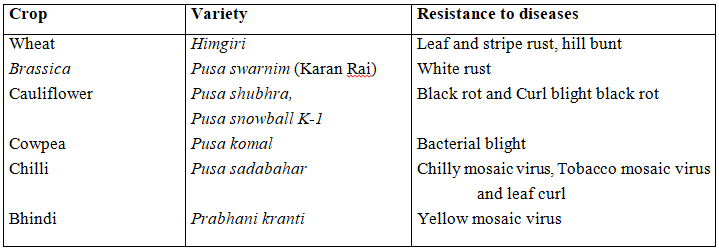
New varieties having these desirable characters can either be multiplied directly or can be used in breeding.
Constraints of conventional breeding like the limited availability of limited number of disease resistance genes can be overcome by this method.
Other useful breeding methods like mutation, selection among somaclonal variants and genetic engineering.
In mung bean resistance to YMV and powdery mildew were induced by mutations.
Resistance to YMV in bhindi (Abelmoschus esculentus) was transferred from a wild species and resulted in a new variety of A. esculentus called Prabhani Kranti.
Plant Breeding for Developing Resistance to Insects / Pests
Insects and pest infection is another major cause for large destruction of crop plant and crop produce. Insect resistance in host crop plants is due to morphological, biochemical or physiological characters.
Solid stem in wheat lead to non-preference by the stem saw fly.
Smooth leaved and nectar-less cotton varieties do not attract bollworms. Low nitrogen, sugar and high aspartic acid in maize develops resistance to maize stem borers.
Some released crop varieties bred by hybridisation and selection for insect pest resistance

Sources of resistance genes may be cultivated varieties, germplasm collections of the crop or wild relatives of the crop.
Plant Breeding for Improved Food Quality
It is estimated that more than 840 million people in the world do not have adequate food to meet their daily requirements.
Three billion people are suffering from 'hidden hunger' as their diet shows deficiencies in proteins, vitamins and micronutrient because these people cannot afford to buy adequate vegetables, fruits, legumes, fish and meat.
Breeding of crops with higher levels of vitamins and minerals or higher protein and healthier fats is called biofortification.
Plant breeding is undertaken for improved nutritional quality of the plants, with the objectives of improving:
(i) Protein content and quality
(ii) Oil content and quality
(iii) Vitamin content
(iv) Micronutrient and mineral content
Cereals are commonly deficient in lysine and tryptophan, while legumes are commonly deficient in sulphur containing amino acids like methionine and cysteine.
In 2000, maize hybrids that had twice the amount of lysine and tryptophan were developed as compared to existing varieties.
Three lysine rich maize varieties have been developed in India are Protina, Shakti and Rattan.
Wheat variety Atlas 66 with high protein content has been used as a donor for improving cultivated wheat.
Indian Agricultural Research Institute (IARI), New Delhi, has also developed many vegetable crops that are rich in minerals and vitamins.
For example, vitamin A enriched carrots, pumpkin, spinach, vitamin C enriched bitter gourd, bathua, tomato, mustard, calcium and iron enriched spinach, bathua and protein enriched beans (broad lablab, french and garden peas).
Breeding for Anti-nutritional Factors
Nutritional quality of a crop generally means improvement in its produce which can be suitable for human (animal nutrition).
Anti-nutritional factors are compounds present in foods and have adverse effect on animal and human growth.
Single cell protein
- Books Name
- A TEXT OF BIOLOGY - CLASS XII
- Publication
- ACME SMART PUBLICATION
- Course
- CBSE Class 12
- Subject
- Biology
SINGLE CELL PROTEIN (SCP)
Some microorganisms like bacteria, blue green algae, yeasts and filamentous algae are used as food and are called SCP.
They are processed to remove excess nucleic acid.
The raw materials for single cell protein production include whey, sulphite waste liquours, hydrocarbon waste from petroleum industry, waste water containing starch from potato processing plants, straw, molasses and animal manure.
The microorganisms are grown in large fermenting tanks with forced aeration for vigorous cell growth. Microorganisms which can be explored for obtaining SCP are:
(i) Algae : Spirulina, Scenedesmus, Chlorella
(ii) Fungi : Fusarium graminearum, Candida utilis, Trichoderma viride
(iii) Bacteria : Achromobacter, Cellulomonas, Methylophilus methylotrophus (Source of Pruteen) : 250 g of this microorganism can be expected to produce 25 tonnes of protein per day.
GREEN MANURE
It is a manure prepared from young, green crop plants by ploughing them back into soil.
Usually, young leguminous crops are used for green manuring because they also increase the nitrogen fertility of the soil.
The plants commonly used for green manuring in India are : Sunn Hemp (Crotolaria juncea), Dhaincha (Sesbania aculeata), Cluster Bean (Cyamopsis tetragonoloba), Sweet Clover (Melilotus parviflora), Cowpea (Vigna sinensis), Horse Gram (Dolichos uniflorus), Egyptian clover (Berseem, Trifolium alexandrinum), Lentil (Lens esculenta).
The plants are rich in nitrogenous compounds because of the presence of nodules on the roots. Sesbania rostrata possesses such nodules on the stem (caulinary nodules) as well.
The plants are slowly converted into manure through the activity of microorganisms. Green manures have all the benefits of farmyard manure.
Additionally, they increase nitrogenous content of the soil, reduce alkalinity and prevent soil erosion.
It is found that green manures increases crop yield by 30-50% as compared to farmyard manure.
ENERGY CROPS
In the face of rising prices and shortage of fossil fuel, attempts are being made to use alcohol for running automobiles.
Both ethanol (ethyl alcohol) and methanol (methyl alcohol) can be used for this purpose.
Proalcohol programme of Brazil envisages the complete replacement of petrol or gasoline with alcohol.
Gasohol programme of U.S.A. contemplates 10-15% blend of alcohol with petrol. While Brazil is concentrating on preparing alcohol from Sugarcane, U.S.A. is experimenting with Maize.
Besides Sugarcane and Maize, other crops which can be used for production of alcohol are Potato, Sugar beet, Tapioca and molasses of sugar industry.
Growing crops for production of alcohol and other fuels is known as energy cropping.
The existing gasoline engines require only little modification for using gasohol or pure alcohol.
One problem with employing alcohol as fuel is the cost of production. Another problem is the reduction in agricultural land.
This will reduce the amount of food available for feeding human population.
PETROLEUM PLANTS
Nobel Laureate, Melvin Calvin, suggested that the shortage of petrol can be overcome by extracting them from certain plants popularly called petroleum plants.
The plants produce a large amount of latex. Latex contain long chained liquid hydrocarbons.
These long chained hydrocarbons can be used directly or broken to hydrocarbons of chain length similar to the ones present in petrol.
Petroleum plants belong to families Euphorbiaceae, Asclepiadaceae, Apocyanaceae and Asteraceae.
The two plants investigated for petroleum products are Euphorbia lathyrus (family Euphorbiaceae) and Brickellia species (family Asteraceae).
Other useful plants are - Jatropha curcas and Pongamia pinnata. Limitation : Commercial exploitation of petroleum plants seems to be not yet feasible because the product would be too expensive.
Tissue culture
- Books Name
- A TEXT OF BIOLOGY - CLASS XII
- Publication
- ACME SMART PUBLICATION
- Course
- CBSE Class 12
- Subject
- Biology
TISSUE CULTURE
Plant tissue culture is the technique of growing cells, tissue, organ or organism in sterilised nutrient media under controlled aseptic conditions.
Plant cells and organs can be cultured in vitro on a suitable medium. Haberlandt started the technique of plant tissue culture in 1902.
The method of producing thousands of plants through tissue culture is called clonal or micropropagation. Each of these plants will be identical (somaclones).
Culture medium can be liquid or solid. It contains source of carbon and energy (sucrose), minerals, glycine, vitamins, growth regulators (auxin like 2-4 D and cytokinin like BAP).
Plant part used for tissue culture is called explant. The explant and media are sterilized before culturing.
Explants are sterilized by specific antimicrobial chemicals (surface sterilization), while glassware and media can be sterilized by using steam and dry heat.
Callus Culture
A small piece of parenchymatous tissue is introduced over culture medium in a tube or flask in dark at 20° - 25°C.
The medium ordinarily contain the auxin, 2, 4 - D, and often a cytokinin like BAP.
After about 2-3 weeks it forms actively growing irregular and undifferentiated mass of cells called callus.
It is divided into several small sections and can be subcultured.
Each piece is then allowed to differentiate into plantlet by providing light and morphogenetic growth hormones.
Multiple Shoot Production :
It is used for raising numerous pathogen free copies of rare plants, hybrids and sterile plants.
A shoot tip or bud with 1 - 4 leaf primordia is sterilised and introduced over culture medium with high salt content and naphthalene acetic acid (NAA).
At intervals of 4 - 6 weeks the shoot tip is given cuts or shaken to form more buds. Each bud gives rise to a small plantlet.
Suspension Culture
In this technique, explant is suspended into liquid medium containing auxin, 2, 4 - D and is constantly agitated at the speed of 100 - 250 rpm (revolution per minute).
Agitation serves following three purposes :
(i) Aeration of culture
(ii) Constant mixing of medium
(ii) Breakage of cell aggregates into smaller groups.
Suspension cultures grow much faster than callus cultures.
In both the type of tissue cultures, with passage of time, cell/tissue dry matter increases and level of nutrient decreases.
To prevent the damage of newly formed cells, part of the cultures are regularly transferred to new culture vessels containing fresh media. This process is termed as subculturing.
Shoot Tip Culture or Production of Disease Free Plants :
Pathogen free clones of plants can be obtained through shoot-tip culture because shoot apical meristem is usually free of pathogens including virus due to high concentration of auxins and rapid rate of cell division.
The apical meristem accompanied by 1-2 leaf primordia is taken. For this the apical bud is sterilised.
The shoot tip is now placed over culture medium under aseptic conditions. Scientists have succeeded in culturing meristems of banana, sugarcane, potato.
Axillary meristem is also free of virus.
Somatic Embryo Regeneration :
Somatic embryos (embryoids) are embryos that arise from somatic cells in tissue culture.
The pattern of development of a somatic embryo proceed through globular, heart shaped, and torpedo shaped stages and mimic the development of sexually produced embryos.
Somatic embryo regeneration is induced by high concentration of auxin.
These embryos are also used to produce synthetic/ artificial seeds by encapsulating them in alginate.
Embryo Culture :
This involves excision of young embryo from seeds and their cultivation through tissue culture.
Embryo culture has following applications :
(i) In embryo rescue, interspecific hybrids are often sterile because of embryo mortality and seed collapse. In such cases the hybrid embryo is excised from female parent in early stage and is cultured. e.g., hybrid between common bean (Phaseolus vulgaris) and wild bean (P angustissimus).
(ii) Embryo culture allows seedling development in the plants whose seeds lack stored nutrients required for seedling growth. e.g., Orchid.
(iii) Also used in multiplication of some rare plants like makapuno coconuts.
Haploid Culture/Androgenic Haploid Culture/Pollen Grain Culture
This technique was developed by Guha and Maheshwari (1964) in Datura innoxia. The floral buds which are very young and unopened are first sterilized in clorox for 20-40 minutes.
They are then opened to remove anthers. Anthers are introduced over culture medium. Within 4-6 weeks, each anther gives rise to a number of haploid embryoids.
Normally they produce sterile haploid plants. Colchicine treatment results in chromosome doubling and produces homozygous diploids for each and every trait.
Gynogenic haploids are also possible by using unfertilized ovules.
Winter Wheat Jinghua-1 and Rice Guan-18 are two important varieties which are produced by this technique and are now under cultivation.
Uses of Androgenic Haploid
(i) Useful in mutation breeding
(ii) To maintain pure lines
(iii) To produce seedless varieties
Protoplast Fusion/Somatic Hybridisation/Parasexual Hybridisation
It is fusion of protoplasts of two plants belonging to different varieties, species and even genera. The cells are first treated with enzymes pectinase and cellulase.
These enzymes dissolve the cell wall and as a result naked protoplasts are produced.
The naked protoplasts are fused by electrofusion (high frequency alternating electric field with short current pulses) or chemofusion (through sodium nitrate or PEG = polyethyleneglycol).
It results in hybrid protoplasts.
The somatic hybrid may have a synkaryon (single fused nucleus) or heterokaryon (having two unfused nuclei).
The hybrid protoplast is called cytoplasmic hybrid or cybrid if one of the two nuclei of this get degenerated.
The first somatic hybrid was obtained by Carlson et.al. (1972) between Nicotiana glauca and N. langsdorfi (species of Tobacco).
The intergeneric somatic hybrids are Pomato (Potato × tomato) and Bomato (Brinjal and Tomato).
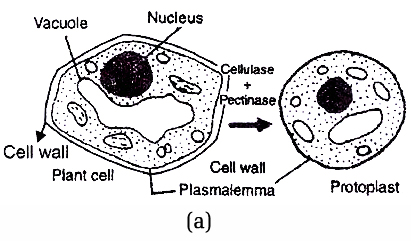
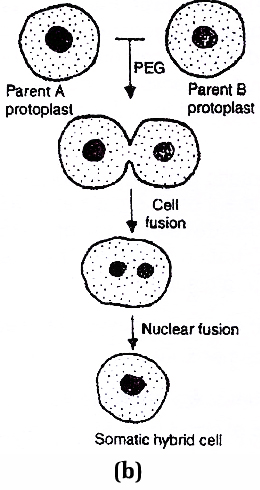
Fig. (a) Protoplast Preparation and (b) Fusion technique
Cellular Totipotency
It is ability of a plant cell to give rise to complete plant when cultured in a suitable culture medium at appropriate temperature and aeration conditions.
Each individual vegetative plant cell possess a complete genetic programme required to direct the development of an entire plant.
The term cellular totipotency was used for the first time by a German botanist Gottlieb Haberlandt (1902). He gave the idea that every plant cell is totipotent.
Applications of Tissue Culture
(i) Can be applied for crop improvement.
(ii) Can be applied for the rapid multiplication of desirable and rare plants.
(iii) Can be applied to obtain indefinite number of plants. (Help in micropropagation)
(iv) Can be applied to obtain virus free plants from shoot apex.
(v) Somaclonal Variations :
These variations are produced during tissue culture.
Some of these may be useful and stable e.g., better yield and quality, early maturation, resistance to diseases and pests, etc.
Some of the significant variations which have been taken up in plant breeding are, high protein content and resistance to late blight in Potato, increased shelf life in Tomato, resistance to rust and high temperature tolerance in Wheat, resistance to Tongro Virus and Leaf Hopper in Rice, short duration in Sugarcane etc.
Microbes in household products
- Books Name
- A TEXT OF BIOLOGY - CLASS XII
- Publication
- ACME SMART PUBLICATION
- Course
- CBSE Class 12
- Subject
- Biology
MICROBES IN HOUSEHOLD PRODUCTS
Dairy Products :
Lactic acid bacteria (LAB) like Lactobacillus are added to milk. It converts lactose sugar of milk into lactic acid.
Milk can be changed into curd, yoghurt and cheese. The starter used in preparation of milk products actually contains millions of LAB.
(a) Curd : Indian curd is prepared by inoculating cream and skimmed milk with Lactobacillus acidophilus at a temperature of about 40°C or less. Curd is more nutritious than milk as it contains a number of vitamins, especially Vit B12 and organic acids.
(b) Yoghurt : It is produced by curdling milk with the help of Streptococcus thermophilus and Lactobacillus bulgaricus. It has a flavour of lactic acid and acetaldehyde.
(c) Butter milk : It is acidulated product which is formed by inoculating skimmed milk with starter culture of Streptococcus cremoris, S. lactis, Lactobacillus acidophilus, Leuconostoc species at 22°C for 18 hours.
(d) Sour Cream : It is inoculated with Streptococcus lactis for producing lactic acid and Leuconostoc cremoris for imparting the characteristic flavour.
(e) Cheese : It is partially degraded concentrate of milk fat and casein, manufactured by activity of microorganisms. There are several hundred varieties of cheese which are prepared by selected types of microorganisms. The quality and characteristic taste of cheese is determined by the biochemical activities of specific microorganisms. Cheese consists of milk curd that has separated from whey or liquid part. Cheese is of three types - soft (50-80% water), semihard (about 45% water) and hard (less than 40% water). The method of preparing cheese with the help of microbes was known in Asia and Europe long before Christ. Large holed Swiss cheese is ripened with the help of CO2 producing bacterium called Propionibacterium sharmanii. Roquefort cheese or blue cheese uses Penicillium roquefortii, while Camembert cheese employs Penicillium camembertii for ripening.
Bread :
Selected strains of Saccharomyces cerevisiae (Baker's yeast) grown on molasses are used for this purpose.
The kneaded flour is kept at a warm temperature for a few hours. It swells up. The phenomenon is called leavening.
Leavening is caused by secretion of three types of enzymes by yeast. They are amylase, maltase and zymase.
The leavened dough is baked. Both carbon dioxide and ethyl alcohol evaporates, making the bread porous and soft.
Dosa, Uppma and Idli :
These are fermented preparations of rice and black gram. The two are allowed to ferment for 3-12 hours with Leuconostoc and Streptococcus species of bacteria.
Other Foods :
Tempeh (Indonesia) Tofu (Japanese) and Sufu (Chinese) are fermented foods obtained from soya sauce, is brown flavoured salty sauce fermented from soyabean and wheat.
Tender bamboo shoots can be used as vegetable directly as well as after fermentation. Several types of sausages are prepared by fermentation and curing of fish and meat.
Toddy (Toddy palm-Caryota urens) :
The unopened spadices of palm are tapped to obtain toddy. It is a refreshing drink which can be heated to produce jaggery or palm sugar. Toddy left for a few hours undergoes fermentation with the help of naturally occurring yeast to form beverage containing about 6% alcohol.
Microbes in industrial products
- Books Name
- A TEXT OF BIOLOGY - CLASS XII
- Publication
- ACME SMART PUBLICATION
- Course
- CBSE Class 12
- Subject
- Biology
MICROBES IN INDUSTRIAL PRODUCTS
Fermentive activity of microbes is used industrially to obtain a number of products. Production on an industrial scale, requires growing microbes in very large vessels called fermentors. The two common ones are alcoholic fermentation and antibiotics.
Fermented Beverages/Alcoholic Fermentation
Yeast species used in alcoholic fermentation are Saccharomyces cerevisiae (Brewer's Yeast), S. ellipsoidens (Wine Yeast), S. sake (Sake Yeast) and S. pireformis (Ginger Beer/Ale Yeast).
The nutrient medium is barley malt for beer, fermented rye malt for gin, fermented rice for sake, cashew-apple for fenny, potato for vodka, fermented cereals for whisky, fermented molasses for rum and fermented juices for wines and brandy.
Wine and beer are produced without distillation, whereas whisky (50% alcohol), brandy (65-70% alcohol), rum (40% alcohol) and gin about (40% alcohol) are produced by distillation of fermented broth.
Antibiotics (means against life in Greek)
An antibiotic is a substance produced by a microorganism, which in low concentration inhibits the growth and metabolic activity of pathogenic organisms without harming the host.
This is among the most significant discoveries of twentieth century.
First antibiotic is generally associated with the name of Alexander Flemming (1928) when he discovered Penicillin from Penicillium notatum.
The antibiotic was however, commercially extracted by efforts of Ernst Chain and Howard Florey. The chemical was extensively used in treating wounded American soldiers in world war II. Flemming, Chain and Florey were awarded Nobel Prize in 1945. Bulk of antibiotics are obtained from three groups of microorganism i.e., Eubacteria, actinomycetes and fungi.
Concept Builder
Name of the antibiotics :
1. From Eubacteria
(i) Bacitracin Bacillus licheniformis
(ii) Subtiiin Bacillus subtilis
(iii) Polymyxin Bacillus polymyxa
(iv) Gramicidin Bacillus brevis
2. From Actinomycetes
(i) Chlorotetracycline or aureomycin Streptomyces aureofaciens
(or tetracycline)
(ii) Chloramphenicol or chloromycetin Streptomyces venezuelae and S. lavendulae
(iii) Erythromycin Streptomyces erythreus
(iv) Neomycin Streptomyces fradiae
(v) Oxytetracycline or terramycin Streptomyces rimosus
(vi) Streptomycin Streptomyces griseus
Antibiotics have greatly improved our capacity to treat deadly diseases like plague, whooping cough, diphtheria, leprosy etc. So with reference to human beings these are pro-life.
Chemicals, Enzymes and Other Bioactive Molecules
Bioactive molecules are those molecules which are functional in living systems or can interact with their components. A number of them are obtained from microbes like organic acids, enzymes, cyclosporin A and statins.
(A) Organic Acids
Certain microbes have the ability to convert carbohydrates into organic acids, this capability of microorganisms is applied in the industrial production of some commercially important organic acids. A few very important organic acids are as follows.
1. Acetic acid : It is prepared from fermented alcohols with the help of acetic acid bacteria, Acetobacter aceti. Alcoholic fermentation by yeast is anaerobic process, but the conversion of alcohol to acetic acid is aerobic one. It is used for the prepration of vinegar. It is also used in pharmaceuticals, colouring agents, insecticides and plastic industries.
2. Citric acid : It is obtained through the fermentation carried out by fungi Aspergillus niger and Mucor species on sugary syrups. Yeast Candida lipolytica can also be employed, provided its nutrient medium is made deficient of iron and manganese. Citric acid is employed in dyeing, engraving, medicines, inks, flavouring and preservation of food and candies.
3. Gluconic acid : The acid is prepared by the activity of Aspergillus niger and Penicillium chtysogenum. Gluconate is used widely as a source of calcium for infants, cows and lactating mothers.
4. Lactic acid : It was first acid to be produced by industrial fermentation. It is commercially produced from fermentable carbohydrates such as corn and potato starch, molasses and whey by using the bacteria - Lactobacillus bulgaricus and L. delbrueckii.
(B) Enzymes
Hardly 1.0-1.5% of the total known enzymes are employed in industry and medicine.
1. Pectinases : They are obtained from fungi grown on pectin containing medium. Examples are Aspergillus niget, Byssochlamys fulvo. They are used in enhancing juice extraction and clearing of juices.
2. Proteases : Proteases are obtained from Mortierella renispora, Aspergillus and Bacillus species, used in detergents to remove proteinaceous spots. Bottled juices are also clarified using proteases and pectinase.
3. Amylases : They degrade starch. Amylases are obtained from Aspergillus, Rhizopus and Bacillus species.
Amylases, glucoamylases and glucoisomerases are employed in conversion of corn starch into fructose rich corn syrup.
4. Streptokinase (Tissue Plasminogen Activator or TPA) : It is an enzyme obtained from the cultures of some haemolytic Streptococci. It has fibrinolytic effect, used to dissolve blood clots in heart patients.
(C) Cyclosporin A
It is an eleven membered cyclic oligopeptide obtained through fermentive activity of fungus Trichoderma polysporum.
It has antifungal and anti-inflammatory properties. It is used as an immunosuppressive agent in organ-transplant patients.
(D) Statins
They are products of fermentation activity of yeast Monascus purpureus which resemble mevalonate and is competitive inhibitor of -hydroxy--methylglutaryl CoA reductase or HMG COA reductase.
This competitively inhibits cholesterol synthesis. It is used as cholesterol lowering agent.
Microbes in sewage treatment
- Books Name
- A TEXT OF BIOLOGY - CLASS XII
- Publication
- ACME SMART PUBLICATION
- Course
- CBSE Class 12
- Subject
- Biology
MICROBES IN SEWAGE TREATMENT
Sewage is collective noun used to represent municipal waste (both liquid and solid waste) generated in cities and towns which is carried off in sewerage.
It contains large amount of domestic water and waste including human and animal excreta, microbes and every things that enter sewerage system.
Sewage or municipal waste should not be passed into rivers, streams and other water bodies, because it not only contains human excreta and other organic wastes but a number of pathogenic microbes.
It is made less polluting by passing it through sewage treatment plants (STPs).
Treatment of waste water is done by the heterotrophic microbes naturally present in the sewage.
The various steps in sewage treatment are :
1. Primary Treatment :
It is a physical process of removal of large and small particles from sewage through sequential filtration and sedimentation.
Initially, floating debris is removed by sequential filtration, then the grit (soil and small pebbles) are removed by sedimentation.
The sewage is first shredded and churned. It is then passed through many screens or skimmers to remove large pieces of organic matter. The sewage is now passed into a large primary settling tank having a gentle slope.
Grit, sand and other heavy particles settle down.
All solids that undergo sedimentation and screened organic matter collectively constitute primary sludge.
Primary sludge can be used for preparing compost or manure directly. It can also be burnt.
The waste water (primary effluent) after removing the primary sludge contains fine organic matter. It is passed for secondary treatment.
2. Secondary Treatment or Biological Treatment :
It involves biological process of microbial degradation of organic matter.
There are three main methods use of oxidation tanks, trickling filter method and activated sludge method.
In activated sludge method the effluent from primary settling tank is passed into an aeration tank. It is agitated mechanically.
Air is pumped into the effluent. It contains a large population of aerobic heterotrophic microbes, including bacteria and fungi.
The microbes form flocs (masses of bacteria associated with fungal filaments).
The BOD of the effluent rises initially and the treatment continues till the BOD decrease to a certain level.
It is taken to secondary settling tank where the flocs undergo sedimentation.
The sediment is called activated sludge (This can be the inoculant for next secondary treatment).
The supernatant is allowed to pass into rivers and streams.
Activated sludge is taken to anaerobic sludge digesters alongwith the primary sludge.
Here, anaerobic microbes act upon organic matter to first produce monomers and then organic acids.
This convert the latter into a mixture of gases like methane, hydrogen sulphide and carbon dioxide.
The gaseous mixture is called biogas. It is inflammable and can be used as a source of energy.
The spent sludge is used as manure, land fill or can be burnt. Pathogens present in the original sewage get killed during anaerobic digestion.
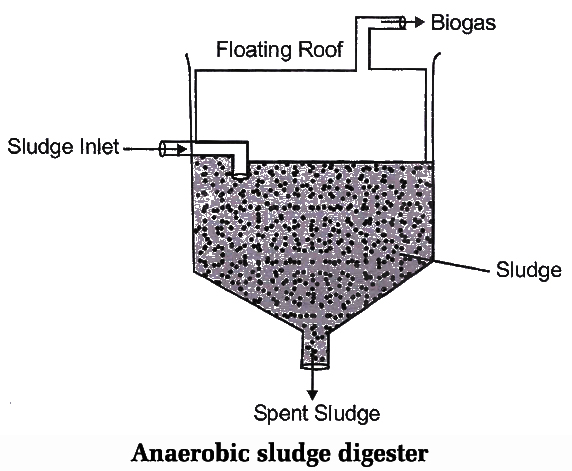
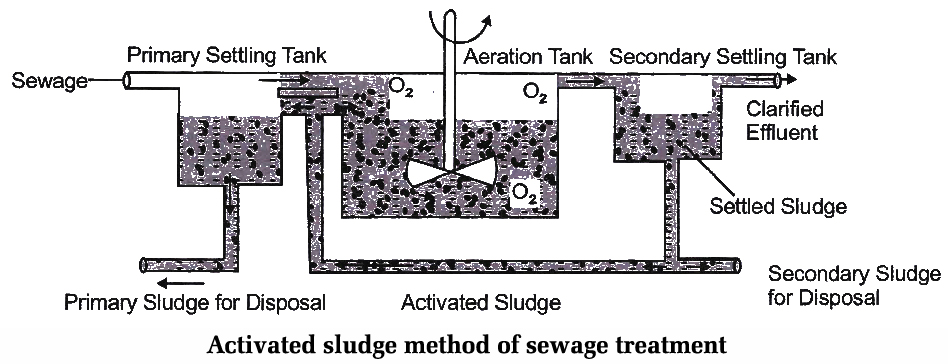
3. Tertiary Treatment :
It is physiochemical process in which chlorine gas, zirconium, ozone gas, perchlorate salts, UV rays or reverse osmosis etc are used to remove DDT, pesticides, pathogens and remove turbidity in waste water. It is preferred when water is to be used for domestic use.
River Action Plans :
Prior to 1985, very few cities and towns had sewage treatment plants.
The municipal waste water was discharged directly into rivers resulting in their pollution and high incidence of water borne diseases.
In order to protect the major rivers of India from sewage pollution, the Ministry of Environment and Forests, has initiated development of sewage treatment plants under the National River Conservation Authority, e.g., Ganga Action Plan (GAP), Yamuna Action Plan, etc.
Microbes in production of biogas
- Books Name
- A TEXT OF BIOLOGY - CLASS XII
- Publication
- ACME SMART PUBLICATION
- Course
- CBSE Class 12
- Subject
- Biology
MICROBES IN PRODUCTION OF BIOGAS
Biogas is a mixture of gases produced from degradable organic matter by activity of various anaerobic bacteria.
The microorganisms involved in biogas production are mainly facultative as well as strict anaerobic bacteria.
The most important among them are methanogenic archaebacteria, represented by Methanobacterium.
The other bacteria involved are Bacillus, Cellulomonas, Clostridium and Ruminococcus.
These bacteria are commonly found in anaerobic sludge formed during sewage treatment. Methanogens do occur in rumen of cattle where they act upon cellulose.
Composition of biogas :
The major component of biogas is methane (about 50 —70%) which is highly inflammable. The other gases are carbon dioxide (30 — 40%) and 10% mixture of other gases, viz., H2, H2S etc. Calorific value of biogas is 4429 kcal/m3 at 50% methane content.
Substrates Useful in Biogas Production :
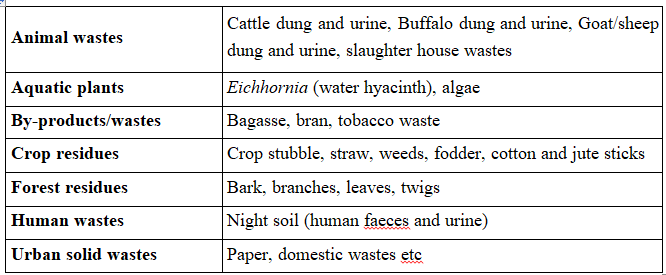
Commercial Production of Biogas :
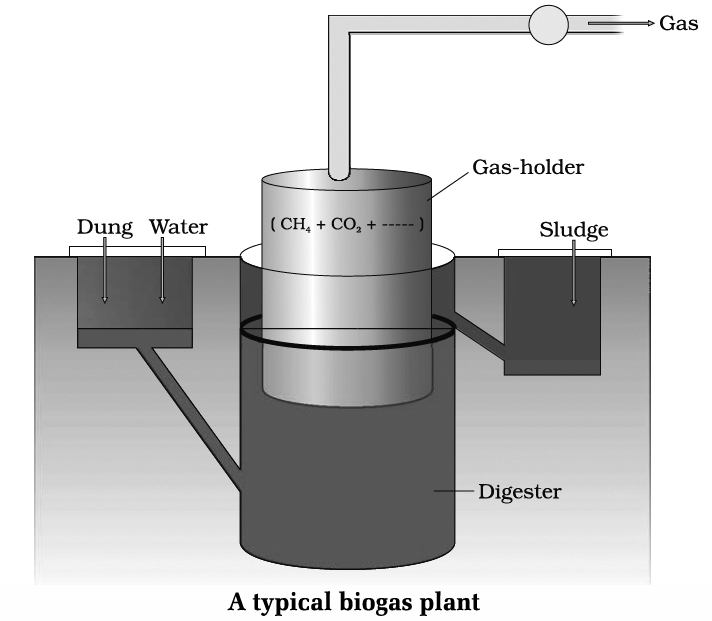
The technology for biogas production was developed in India by IARI (Indian Agriculture Research Institute) and KVIC (Khadi and Village Industries Commission).
A biogas plant has a large (10-15 ft. deep) concrete or brick lined air tight cylindrical tank called digester.
It has a charge pit for passage of slurry into digester, a floating gas holder of metal with an outlet for gas and a pit for removal of sludge or manure. The raw material used in biogas plants is cattle dung, night soil, farm refuse, water weeds (e.g., Eichhornia) and other organic wastes.
It is converted into slurry with 90% water content and fed to digester.
Cattle dung contains Methanobacterium and other methanogens which are normally present in rumen of cattle for aiding in digestion of cellulose.
An inoculum can also be provided when a gobar gas plant is to be initiated.
Formation of biogas is a three step anaerobic process :
1. Solubilisation (Decomposition) :
Organic wastes are composed of lipids, proteins, cellulose, hemicellulose and lignin. In the first stage of biogas generation, facultative anaerobic decomposers are active.
They secrete hydrolytic enzymes, e.g., lipases, cellulases, proteases, peptidases.
The enzymes breakdown the complex organic components into simpler and soluble substances. The latter are commonly called monomers.
2. Acidogenesis :
Monomers are changed into organic acids with the help of fermentating microbes. The most common organic acids produced during acidogenesis is acetic acid.
Hydrogen and carbon dioxide are produced as by products.
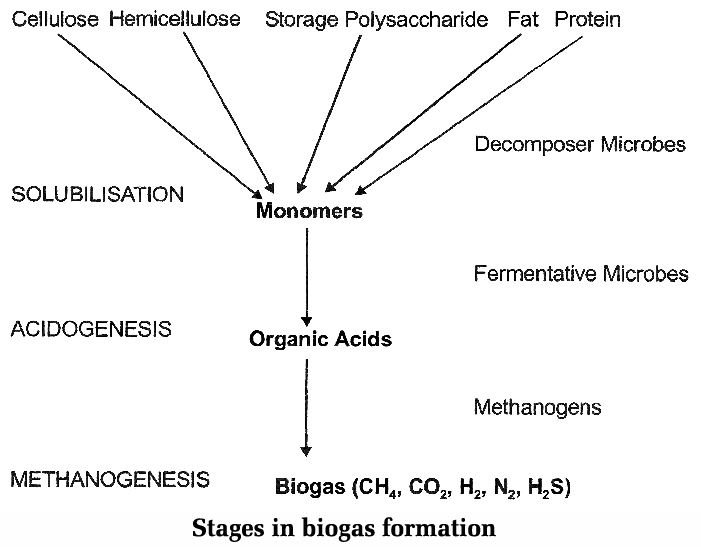
3. Methanogenesis :
Methanogens or methane producing bacteria become active.
They act on various components of microbial digestion and fermentation. Some important basic reactions are :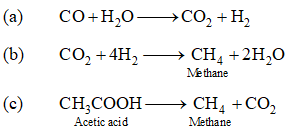

Microbes as biocontrol agents
- Books Name
- A TEXT OF BIOLOGY - CLASS XII
- Publication
- ACME SMART PUBLICATION
- Course
- CBSE Class 12
- Subject
- Biology
MICROBES AS BIOCONTROL AGENTS
Biological Pest Control or Biopesticide
1. Biopesticides are the organisms which are applied to destroy the pests. They are used to destroy the weeds as well as the insect pests. Two basic types are bioherbicides and bioinsecticides.
2. Transgenic plants are genetically engineered plants to develop resistance against pests. e.g., transgenic tobacco and transgenic cotton.
3. Smoother crops are those which do not allow the weeds to grow nearby e.g., barley, rye, Sorghum, millet, sunflower, alfalfa, soyabean, marigold etc. Smoother crops eliminate weeds through chemicals. Crop rotation with these crops will naturally reduce the incidence of weeds.
4. Catch/ trap crops : Around the major crop in the field some early growing crop is sown in strips which is termed as catch or trap crop. The pests get attracted towards the early grown trap crop and then can be easily killed by cutting and destroying the trap crop. A good example of trap crop is bhindi (okra) which is sown around the cotton field to attract the jassid and spotted bollworm. Sesame is also good trap crop to attract the red hairy caterpillar from the cotton field.
5. Bioherbicides : It involves the biological control of weeds by some living organisms. e.g., use of insects feeding on a specific weed or use of micro-organisms which will cause diseases in weeds. Some of the common examples are given below :
(a) In India and Australia, the overgrowth of Opuntia (prickly pear cactus) was checked by the introduction of the cochineal insect (Cactoblastis cactorum).
(b) The first bioherbicide was mycoherbicide called Devine, derived from a fungus Phytophthora palmivora which controls the growth of milk weed vines in Citrus orchards.
(c) Another mycoherbicide called Collego has been derived from conidia of fungus Colletotrichum gloeosporioides. It controls the growth of northern Jointvetch (Aeschynomene virginica fam. Leguminosae) growing in rice fields.
(d) Extensive growth of Hypericum perforatum or kalmath weed was checked in USA by the introduction of Chrysolina beetles.
(e) Water hyacinth has been successfully controlled in Florida using the indigenous fungus Cercospora rodmanii.
6. Bioinsecticides : These are non persistent, non toxic and biodegradable. They include
(a) Pathogens, parasite and predators :
A well known example of biological control of an insect pest is the destruction of large populations of aphids (a pest on crucifers) by an insect called lady bug or praying mantis which feeds on the aphids.
The hoover fly larvae (Syrphid larvae) are very effective in keeping the aphids (plant bugs) under check as they feed on the aphids only. Dragon flies are useful to get rid of aphids and mosquitoes.
The mosquito larvae are easily controlled by rearing the larvicidal fish Gambusia (mosquito fish).
The sugarcane scale insects are controlled by the coccinellid predators (Cailochorus negriti and Pharoscymnus homi), the fluted scale insect (lcerya purchasi), a common pest on Citrus trees by the lady bird beetles (Rodolia cardinalis) and Nephantis serinopa, is a dangerous pest on coconut palms, by Perisierola nephanticdis and Trichospilus pupivora.
Baculoviruses are pathogens that attack insects and other arthopods. NPV (Nuclearpolyhedrovirus) based insecticide has been found to eliminate bollworms which cause extensive damage to cotton. These are species specific and narrow spectrum.
Trichoderma species are effective biocontrol agents of several plant pathogens. Trichoderma species are free-living fungi that are very common in the root ecosystems.
(b) Sterilisation strategy : Screw worm (Cochliomyia hominivorax) was eradicated by releasing sterile males.
(c) Insect hormone or Pheromones :
The pheromones are those chemical messengers which help in communication, sending alarm signals, marking trails or for attracting males.
Pheromones are secreted by females. Traps containing pheromones are placed in infested
fields. Males attracted by the trap become unavailable for reproduction.
In confusion technique, the pheromone containing papers are spread all over the field, so
males can no longer locate the females.
Introduction of moulting hormone ecdysone or juvenile hormones at inappropriate times results in the early death of insect pests.
(d) Natural insecticide :
These are obtained from living organisms (Plants) e.g., rotenones (obtained from the roots of Derris elliptica), nicotine (obtained from tobacco), pyrethrum and cinerin (pyrethroids, obtained from Chrysanthemum cinerarifolium), azadirachtin from margosa (Azadirachta indica) leaves, thurioside from mutant strains of a bacterium called Bacillus thuringiensis (Bt).
Thurioside is a proteinaceous toxin and is effective against several insects such as moths, flies, mosquitoes and beetles which accumulate as crystals inside the bacteria during sporulation.
Integrated Pest Management (1PM)
Sustainable pest management is otherwise known as Integrated pest management i.e., integration of tactics for control of single pest on one or more crops.
The overall objective of IPM is to create and to maintain situations in which insects are prevented from causing significant damage to crops.
Microbes as a biofertilizers
- Books Name
- A TEXT OF BIOLOGY - CLASS XII
- Publication
- ACME SMART PUBLICATION
- Course
- CBSE Class 12
- Subject
- Biology
MICROBES AS BIOFERTILISERS
Organic farming is the raising of unpolluted crops through the use of biofertilisers that provide optimum nutrients to crop plants.
Organisms which can be used to improve the nutrient quality of soil through biological activity are known as biofertilisers.
The main sources are bacteria, cyanobacteria and fungi. In paddy fields, cyanobacteria serve as an important biofertiliser.
(a) Symbiotic N2 fixing bacteria like Rhizobium leguminosarum fixes atmospheric N2 in root nodules of legumes.
(b) Frankia (Actinomycetes) in root nodules of non-legume plants (e.g., Casuarina and Alnus).
(c) Symbiotic cyanobacteria (blue green algae) like Anabaena azollae fixes atmospheric N2 in leaves of Azolla (water fern). Azolla pinnata (a pteridophyte) is used as an excellent fertilizer in rice field.
(d) Anabaena cycadae lives in coralloid root of Cycas (a gymnosperm).
(e) Aulosira is most active, non symbiotic nitrogen fixer in rice field in India.
(f) Free living nitrogen fixer like Azospirillum and Azotobacter enrich the nitrogen content in soil.
(g) Mycorrhiza : It is symbiotic association between the fungus and roots of higher plants (seed plants). Many members of the genus Glomus form mycorrhiza. The fungal partner absorbs phosphorus from soil and passes it to the plant. Plants having mycorrhizal associations show resistance to root-borne pathogens, tolerance to salinity and drought, and an overall increase in growth and development. It is of two types :
(i) Ectomycorrhizae (Ectotrophic or Ectophytic) : Hyphae of fungus only form mantle on the outer surface of the root, increasing absorption of water and minerals e.g., Pinus, oak etc. Mycorrhiza absorb and store nitrogen, phosphorus, potassium and calcium.
(ii) Endomycorrhizae (Endotrophic or Endophytic) : Fungal hyphae penetrate into cortex and cells of root e.g., orchids, coffee and woody plants. These are also called as vesicular arbuscular mycorrhizae or VAM, because cortical cells swell and form vesicles or arbuscles. It has significant role in phosphorus nutrition in plants.

 ACME SMART PUBLICATION
ACME SMART PUBLICATION
